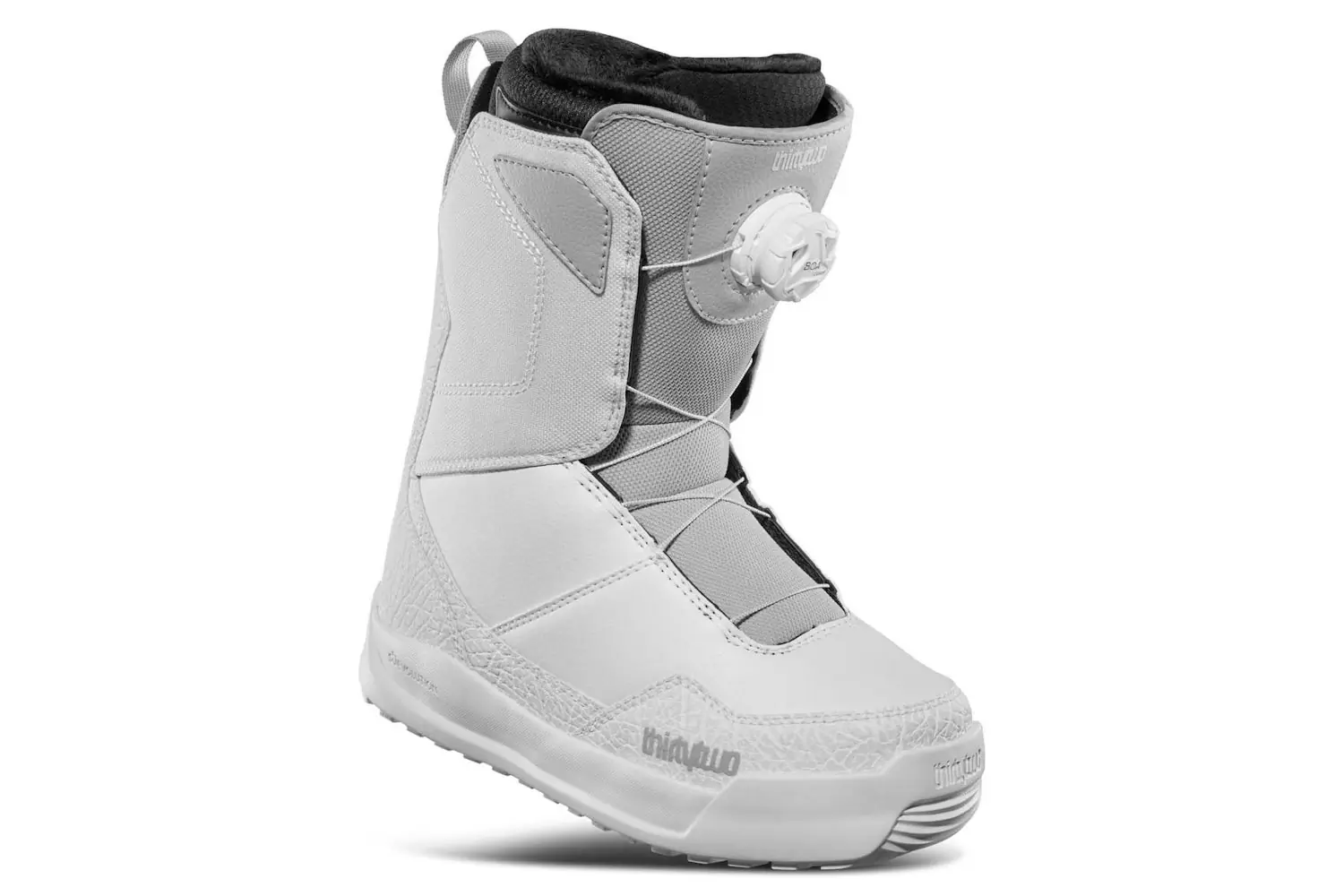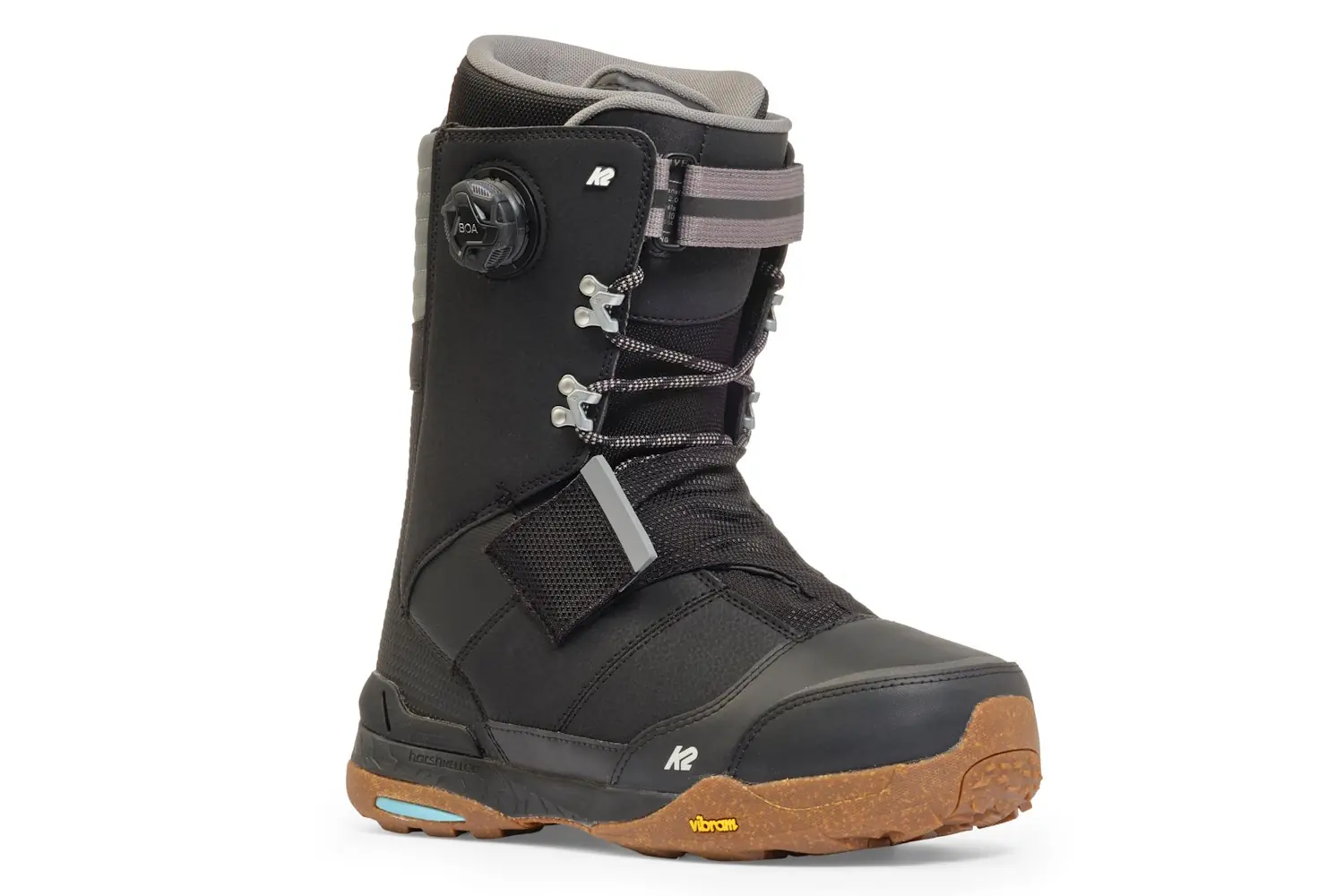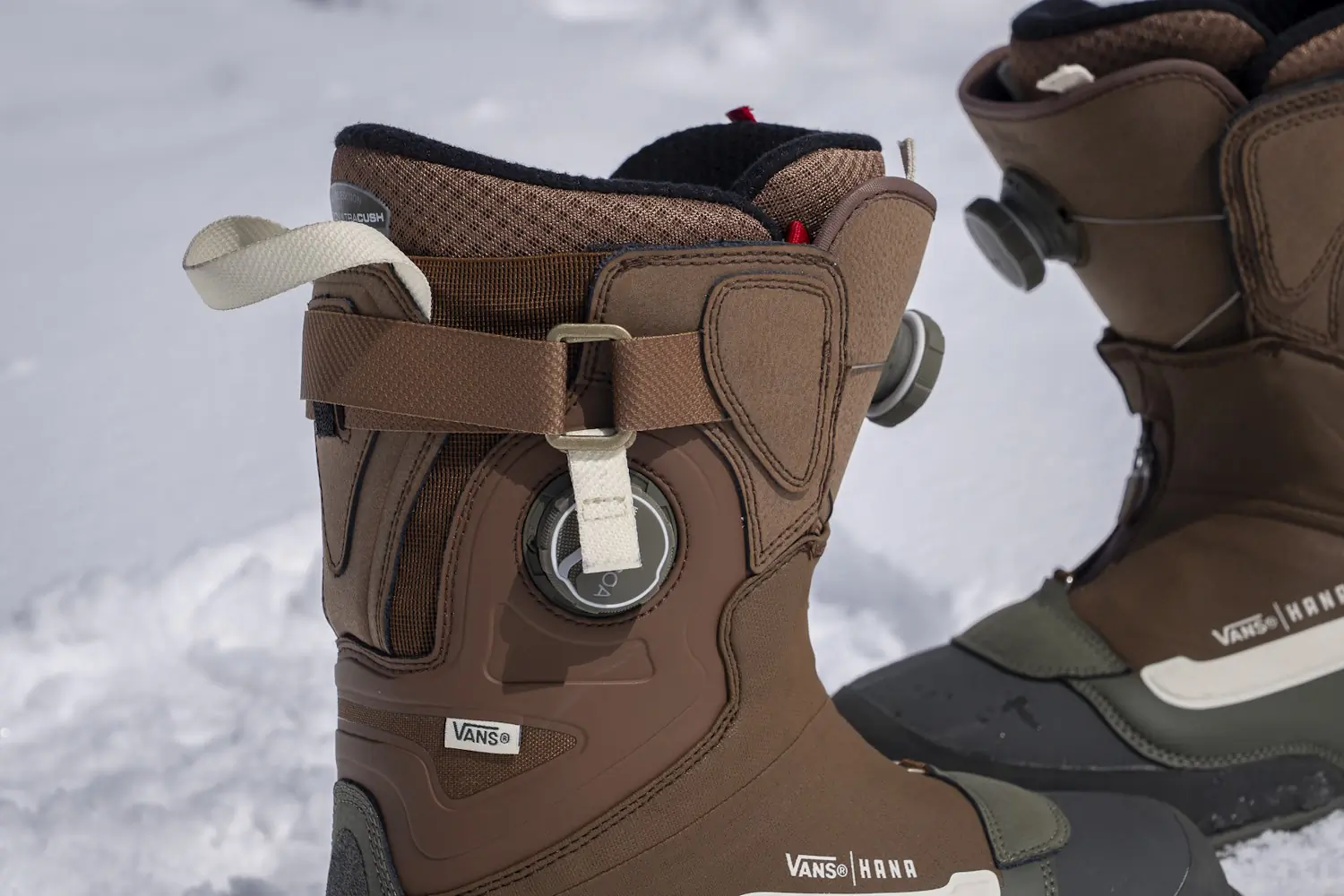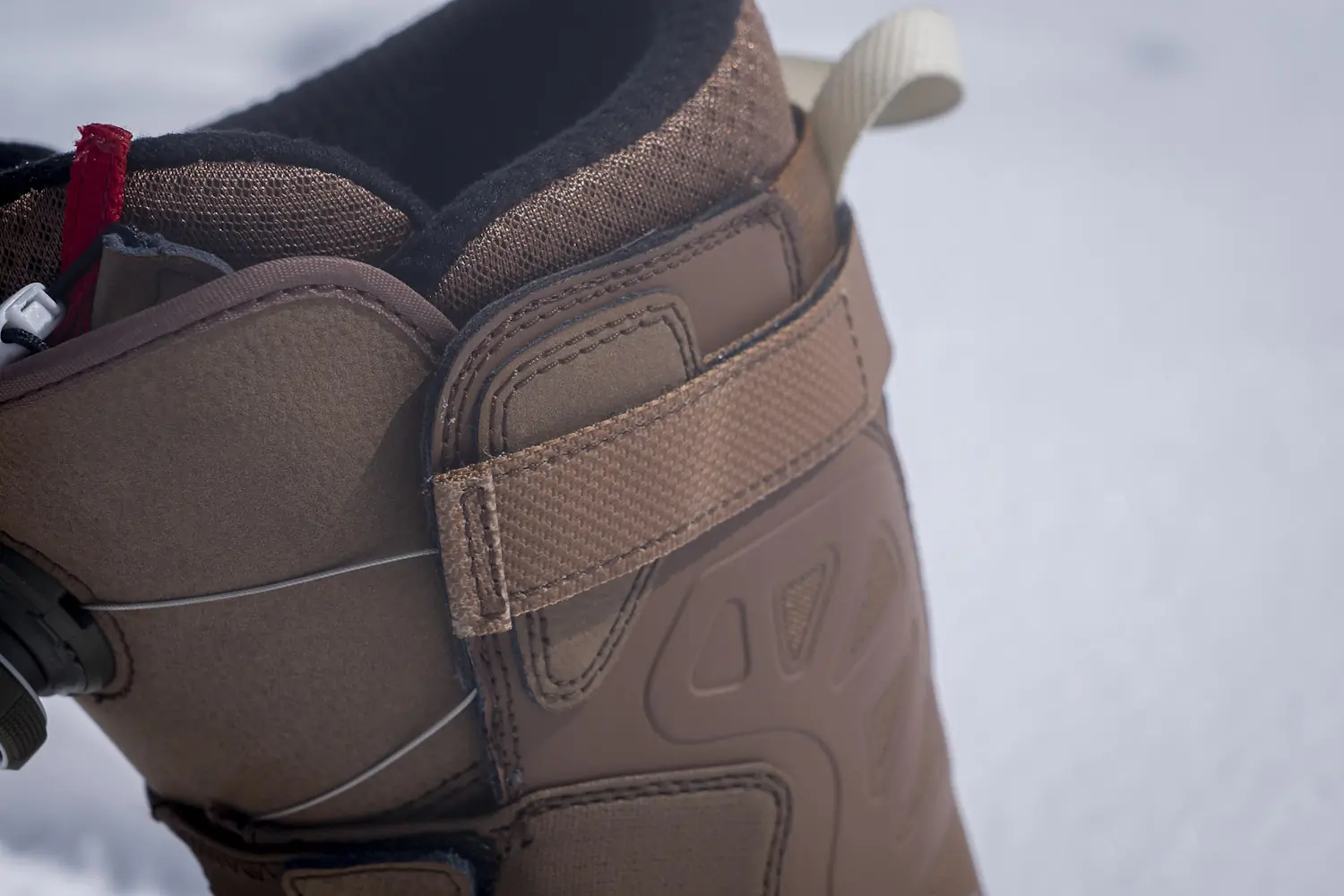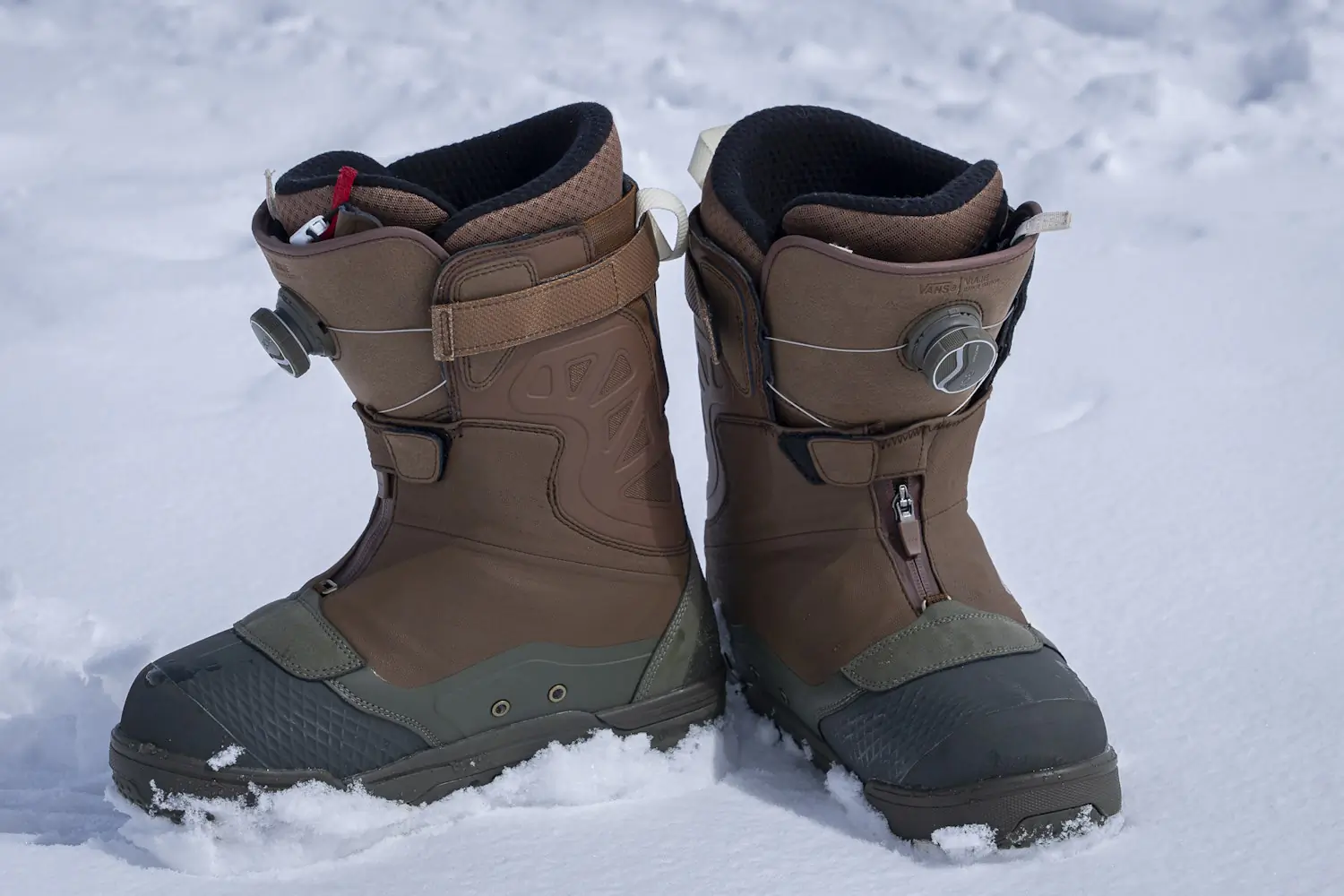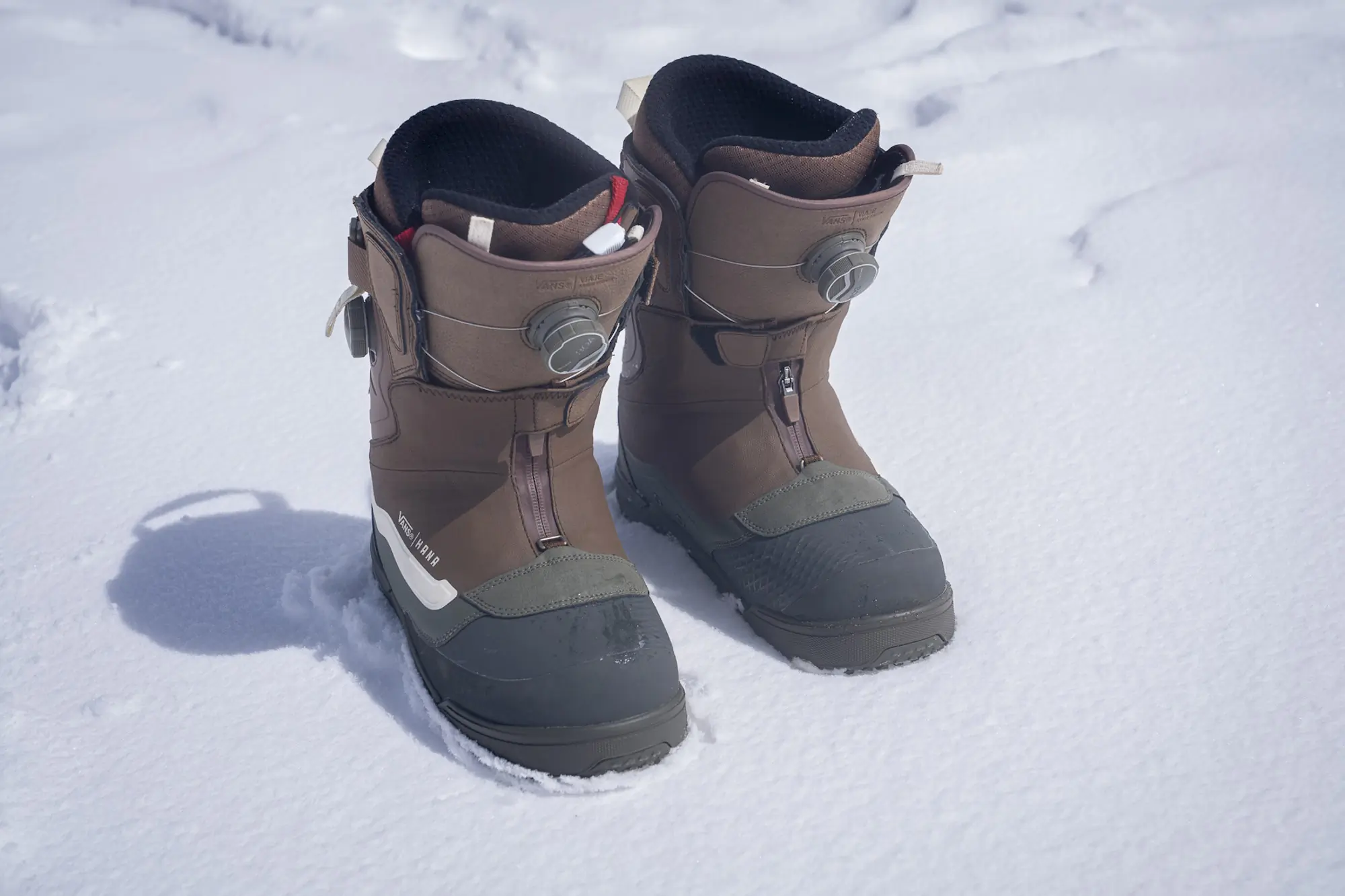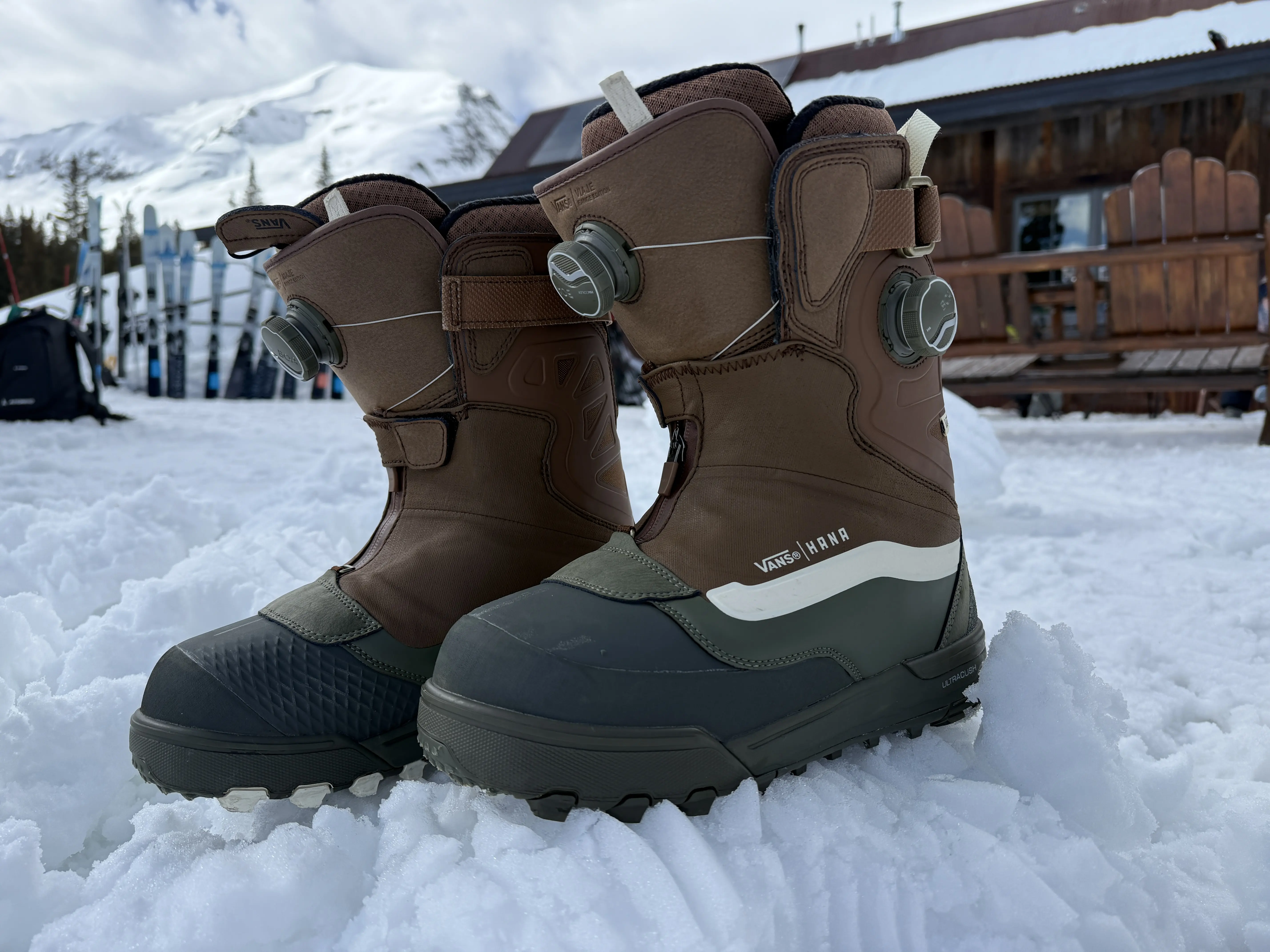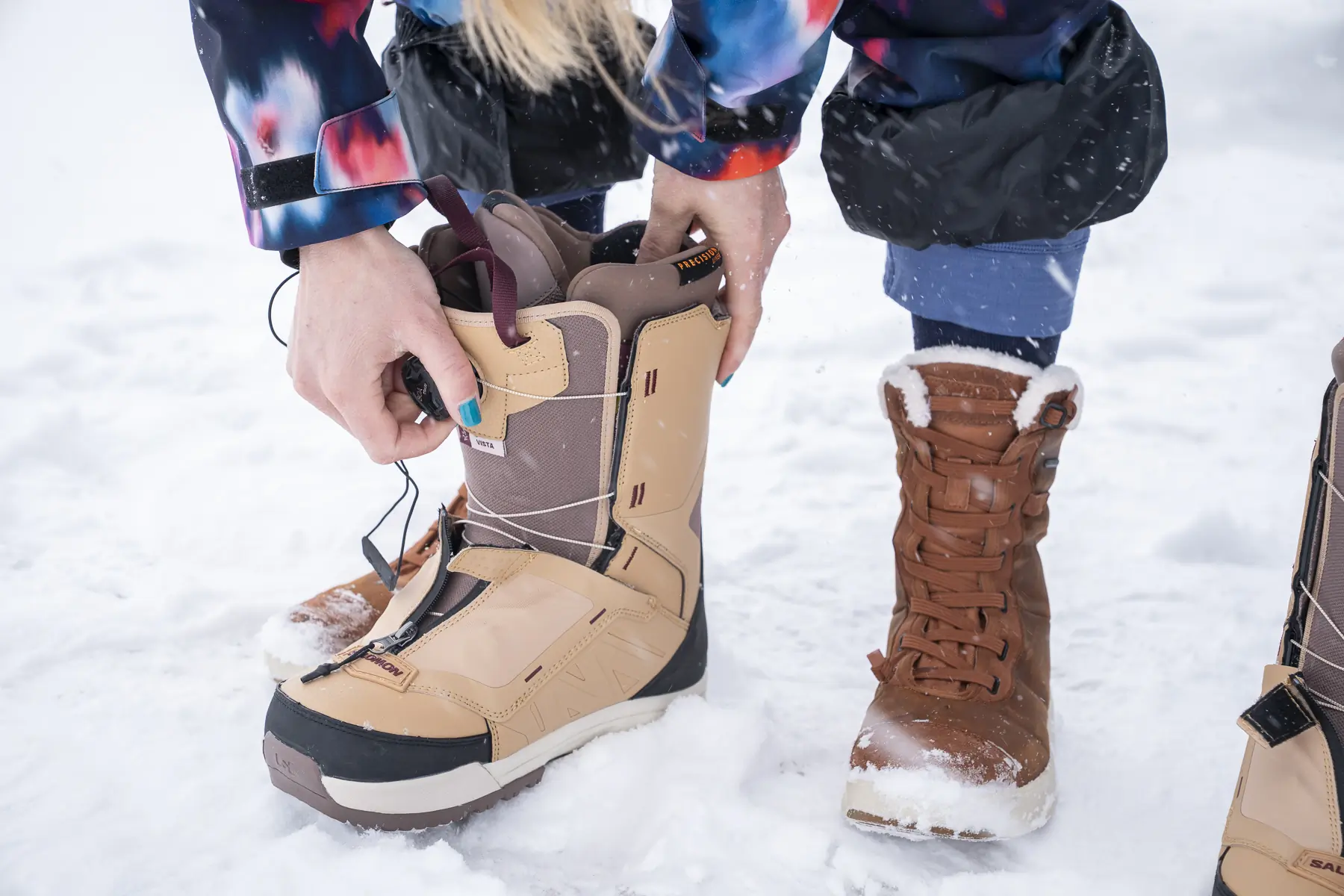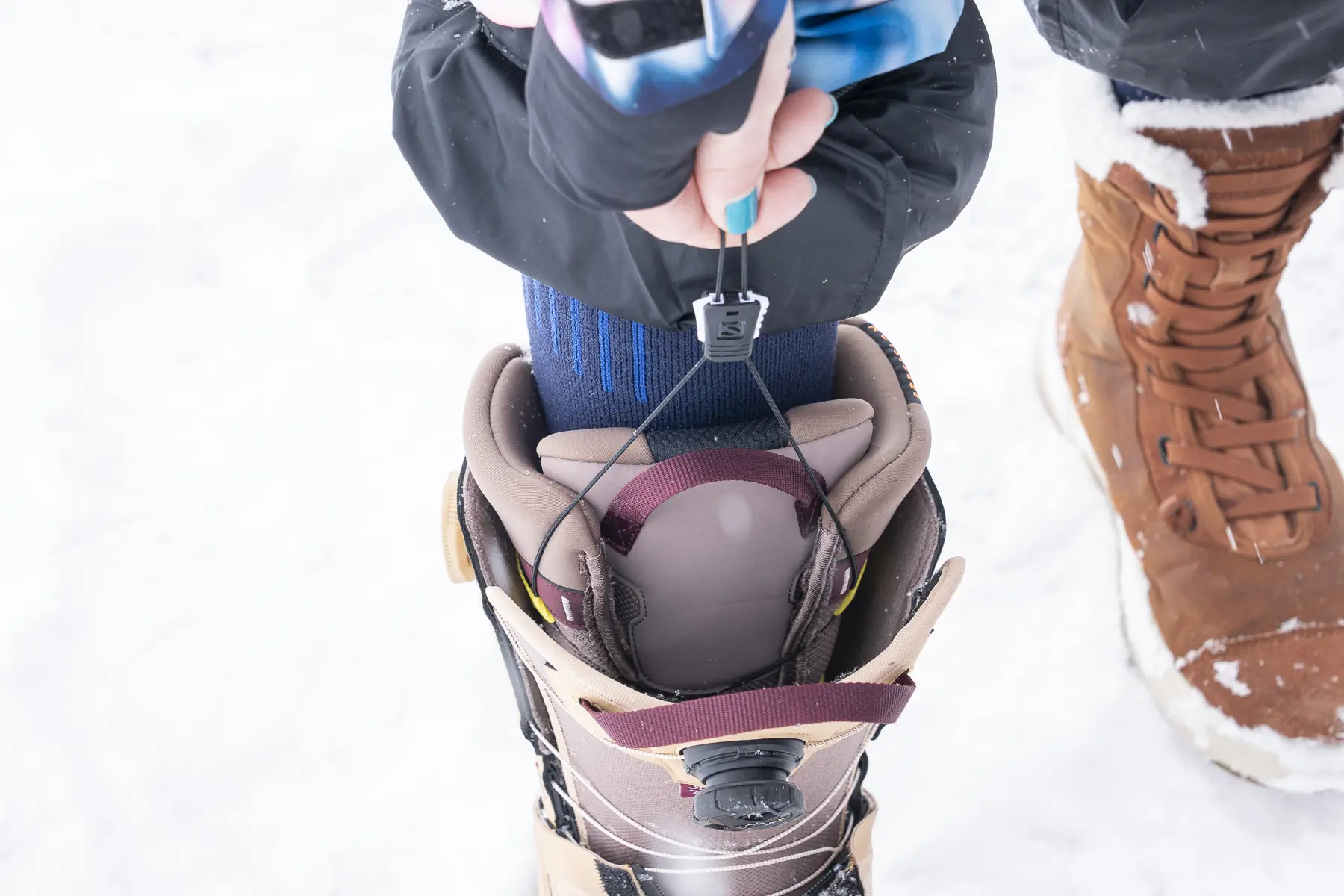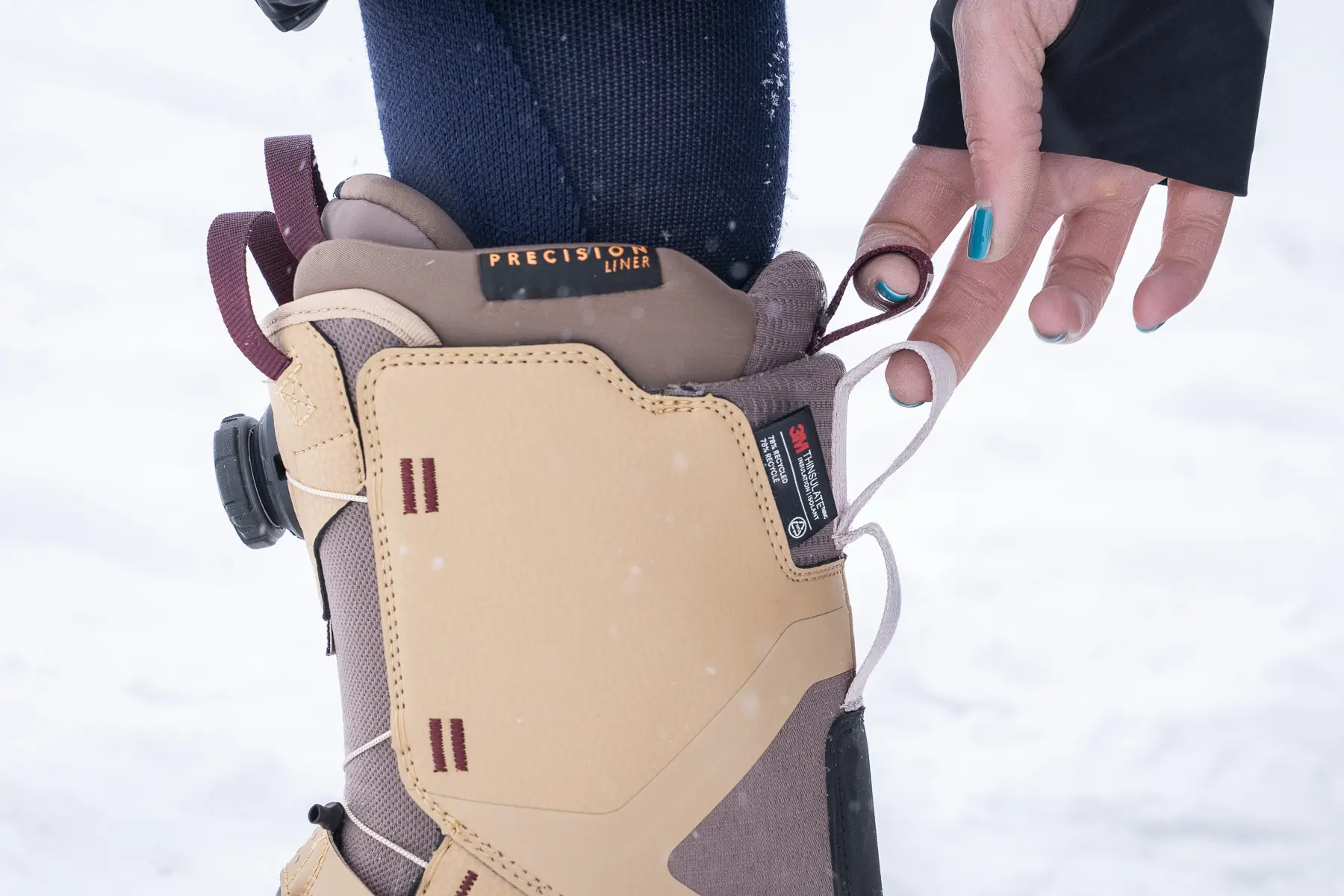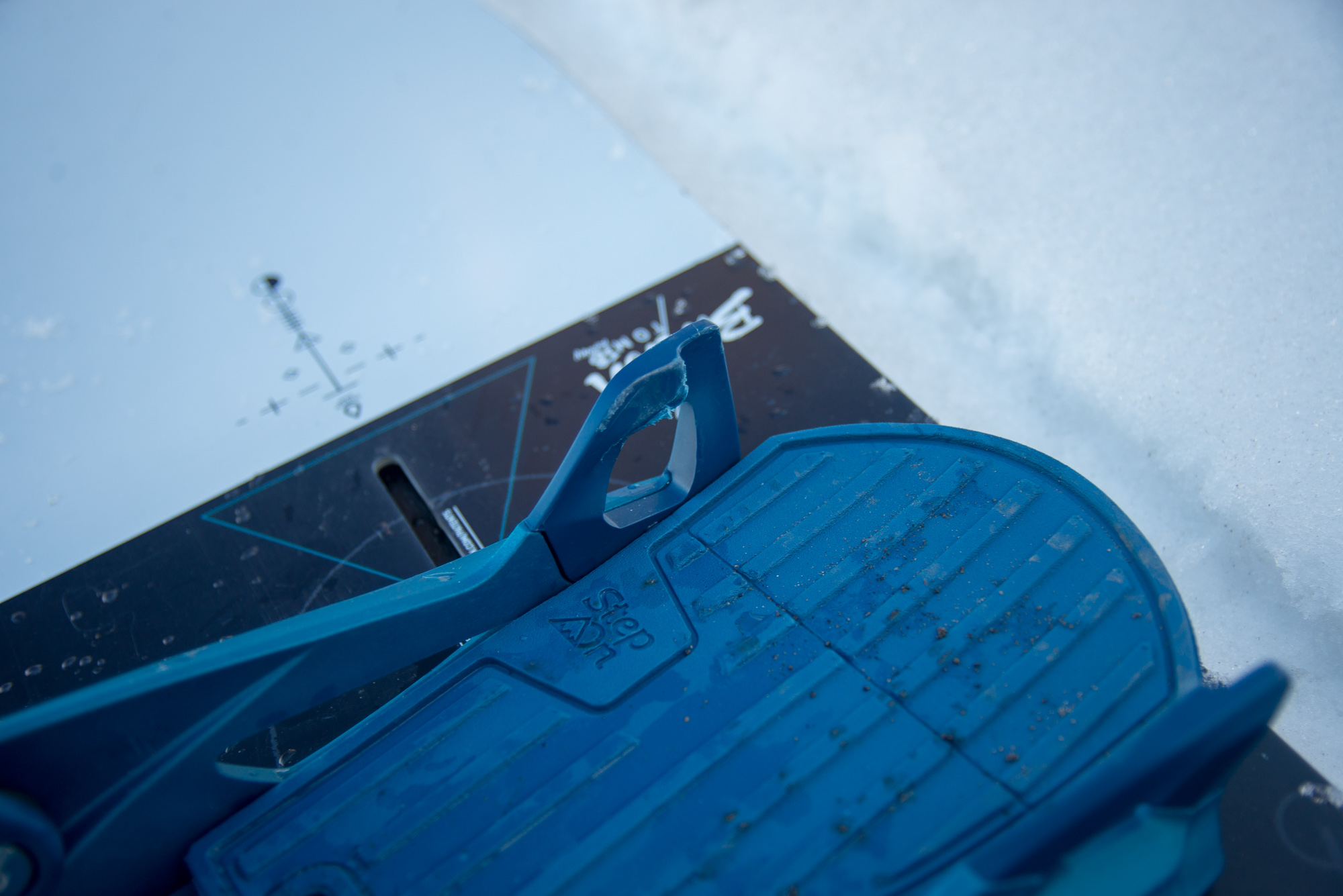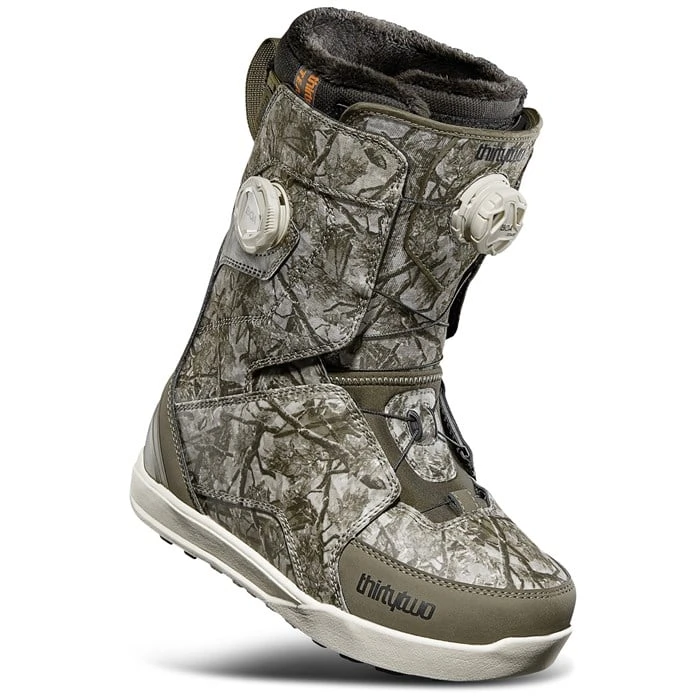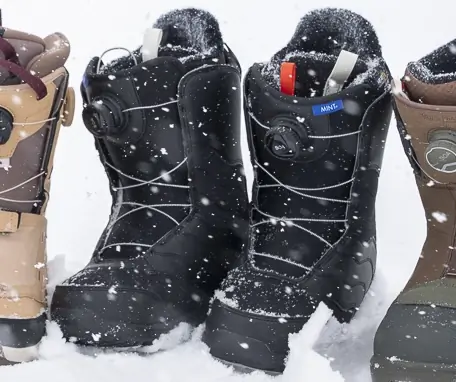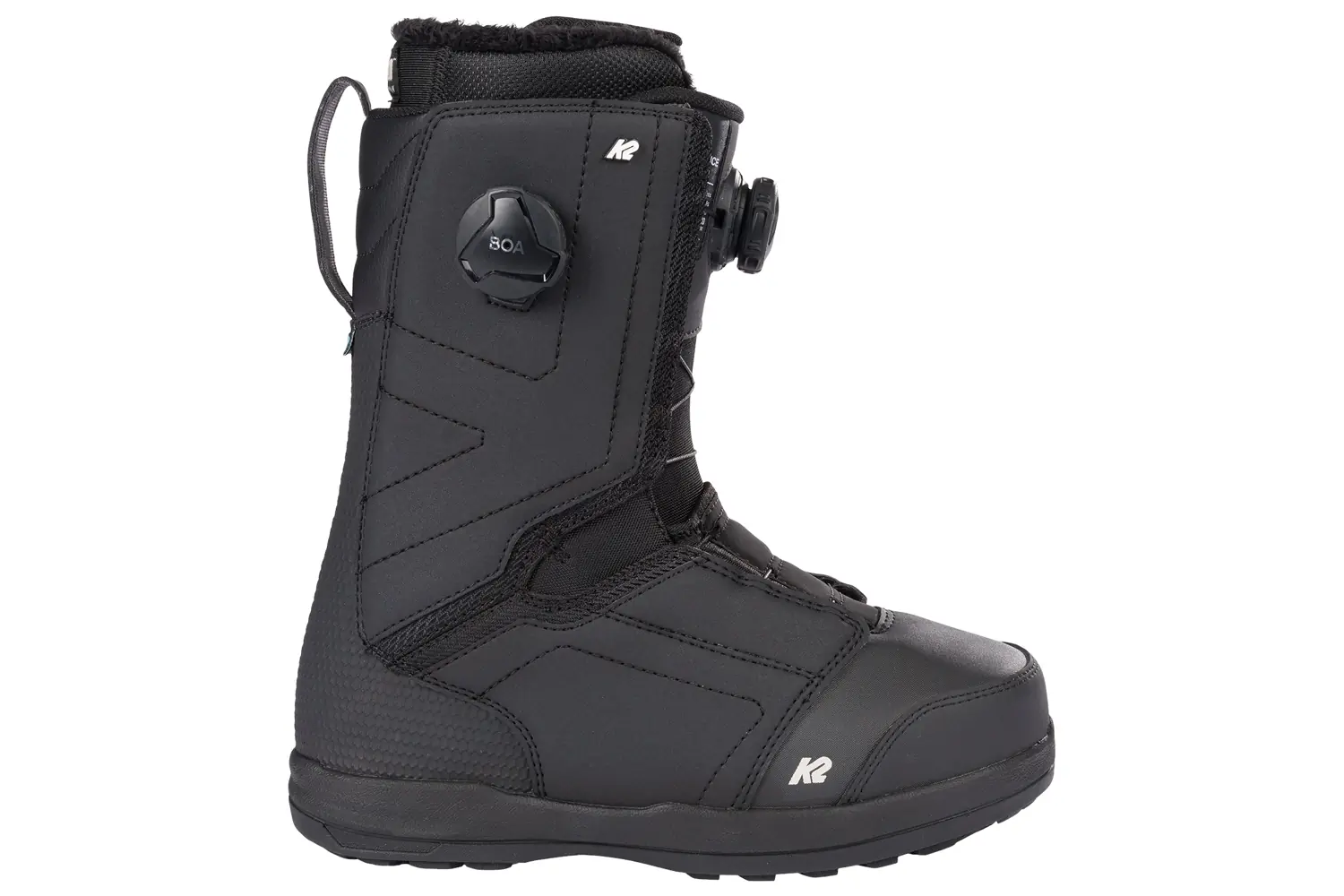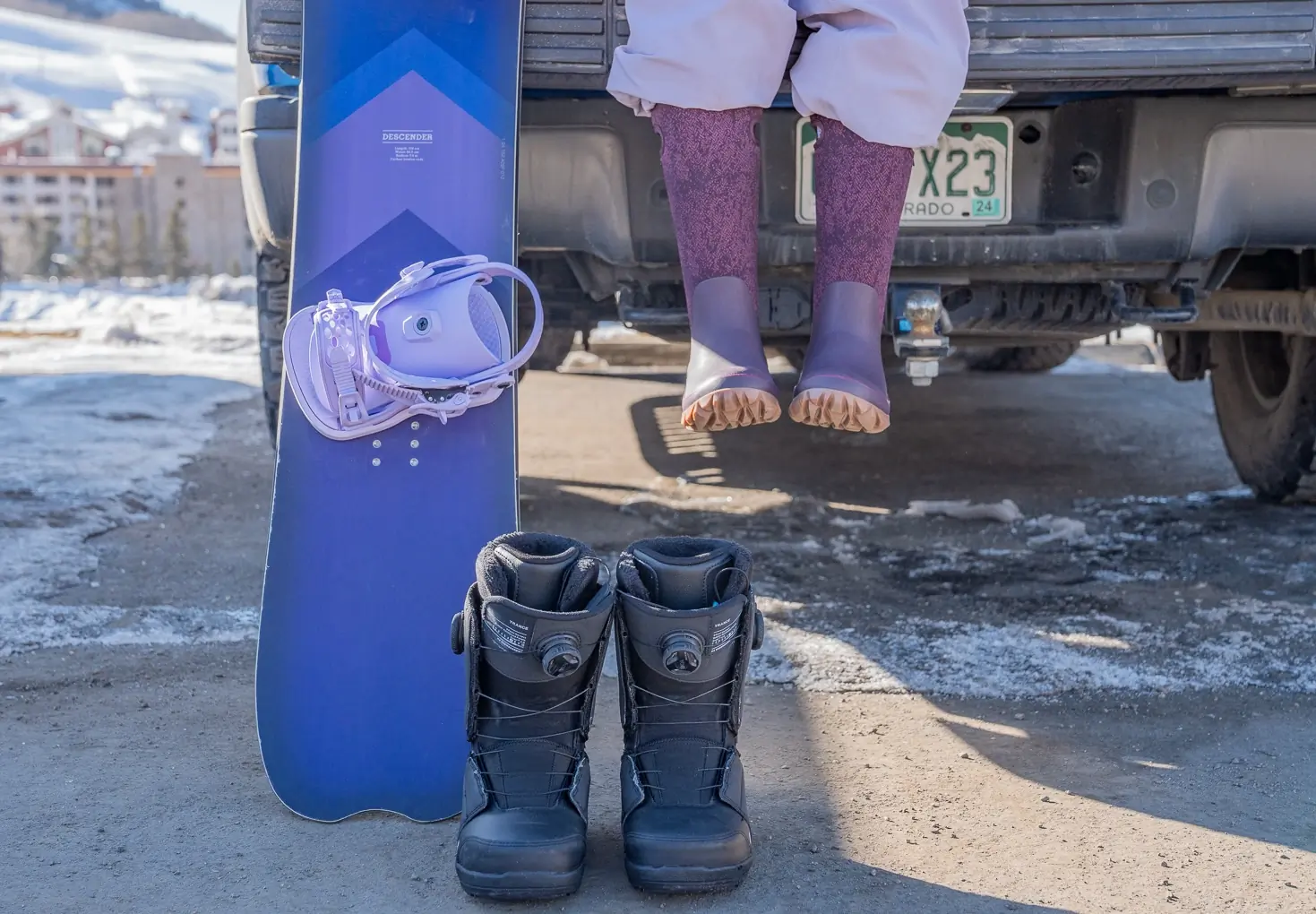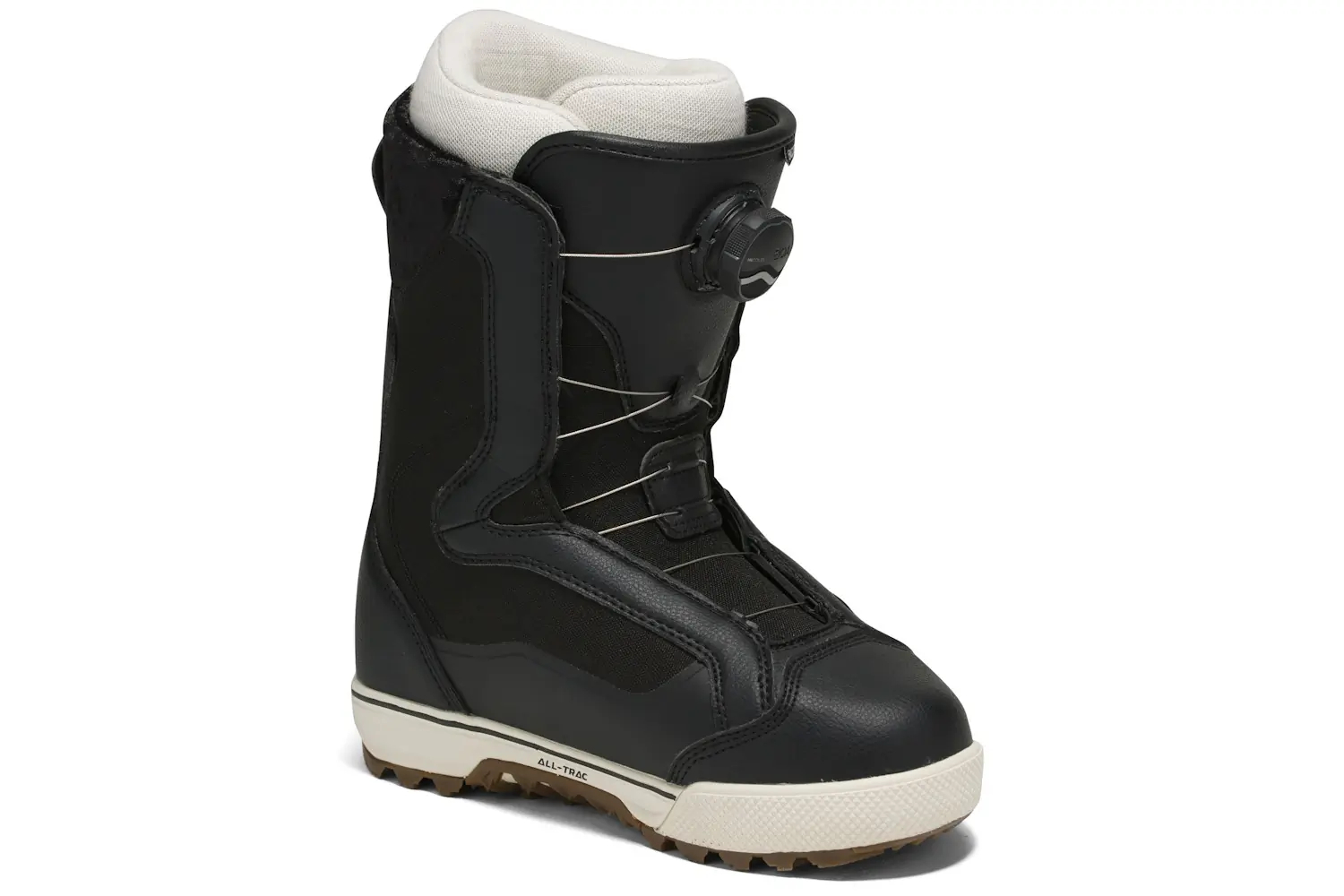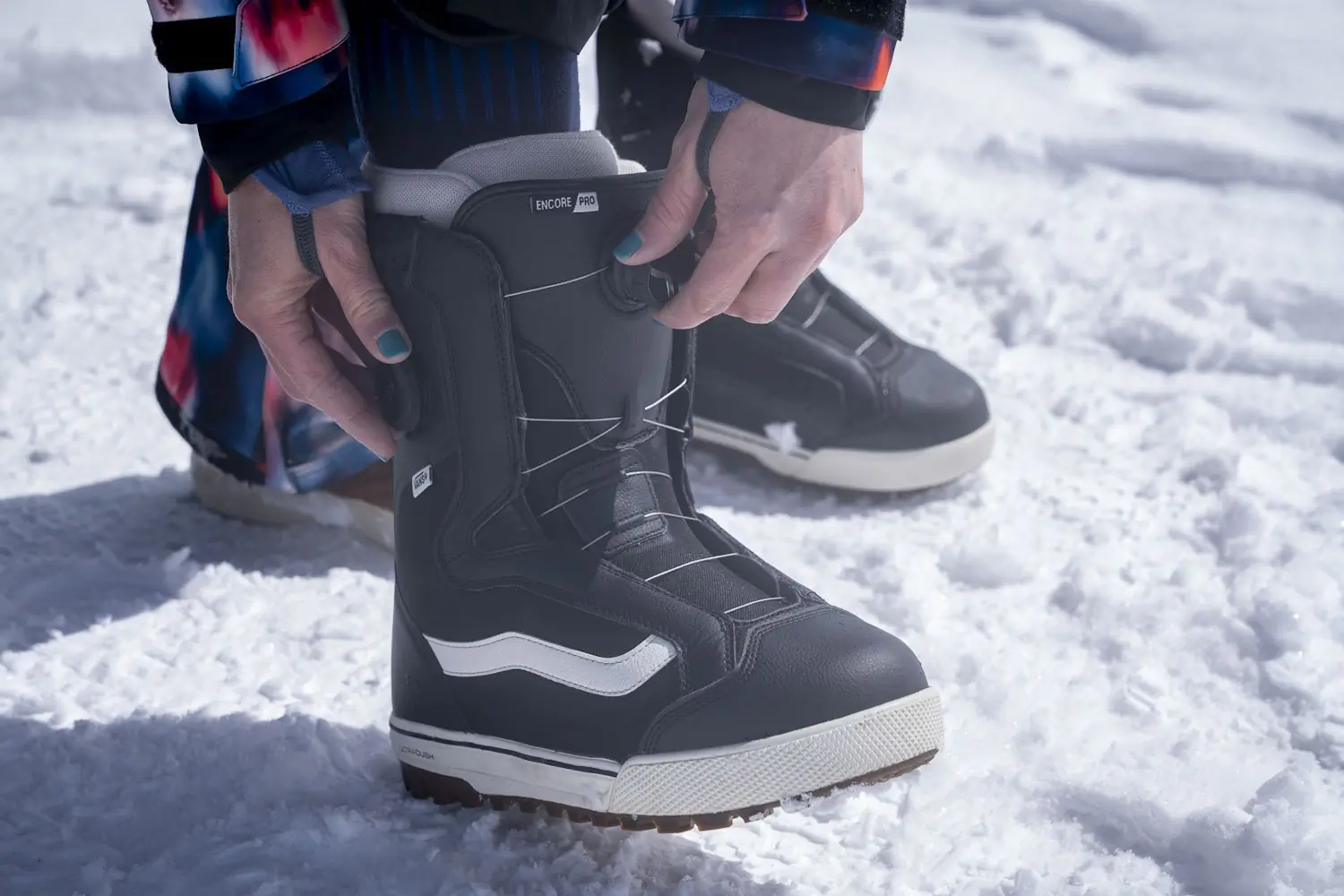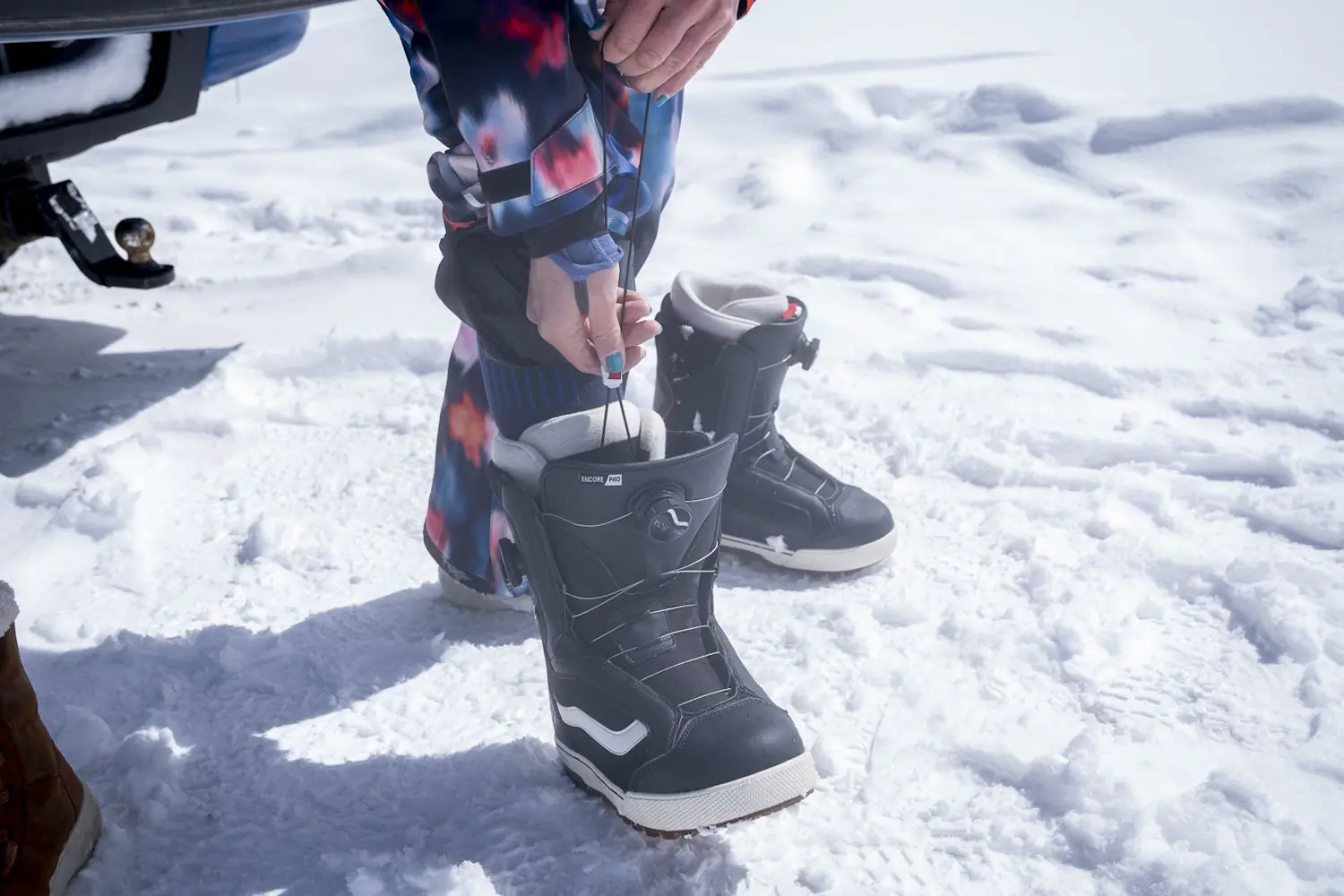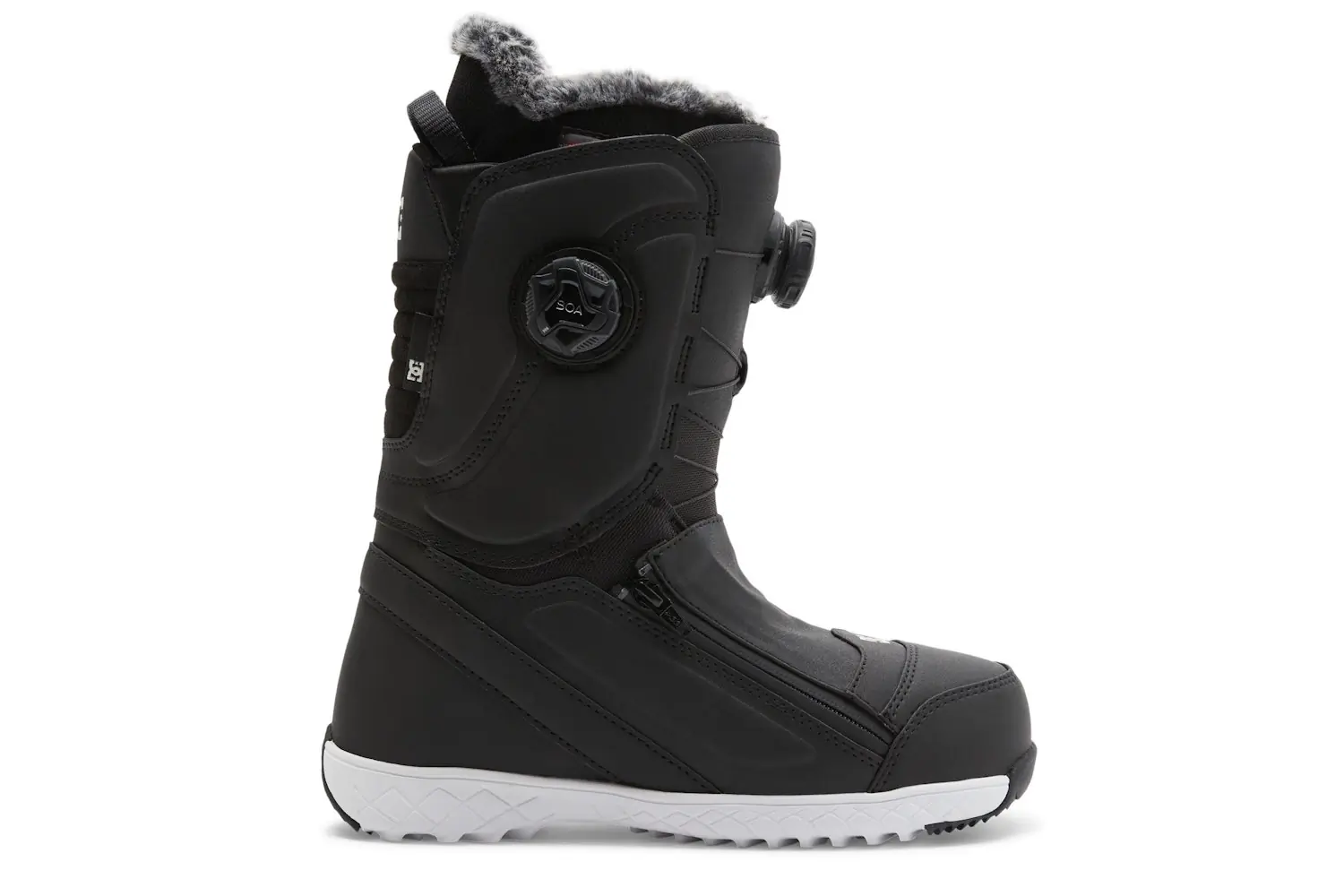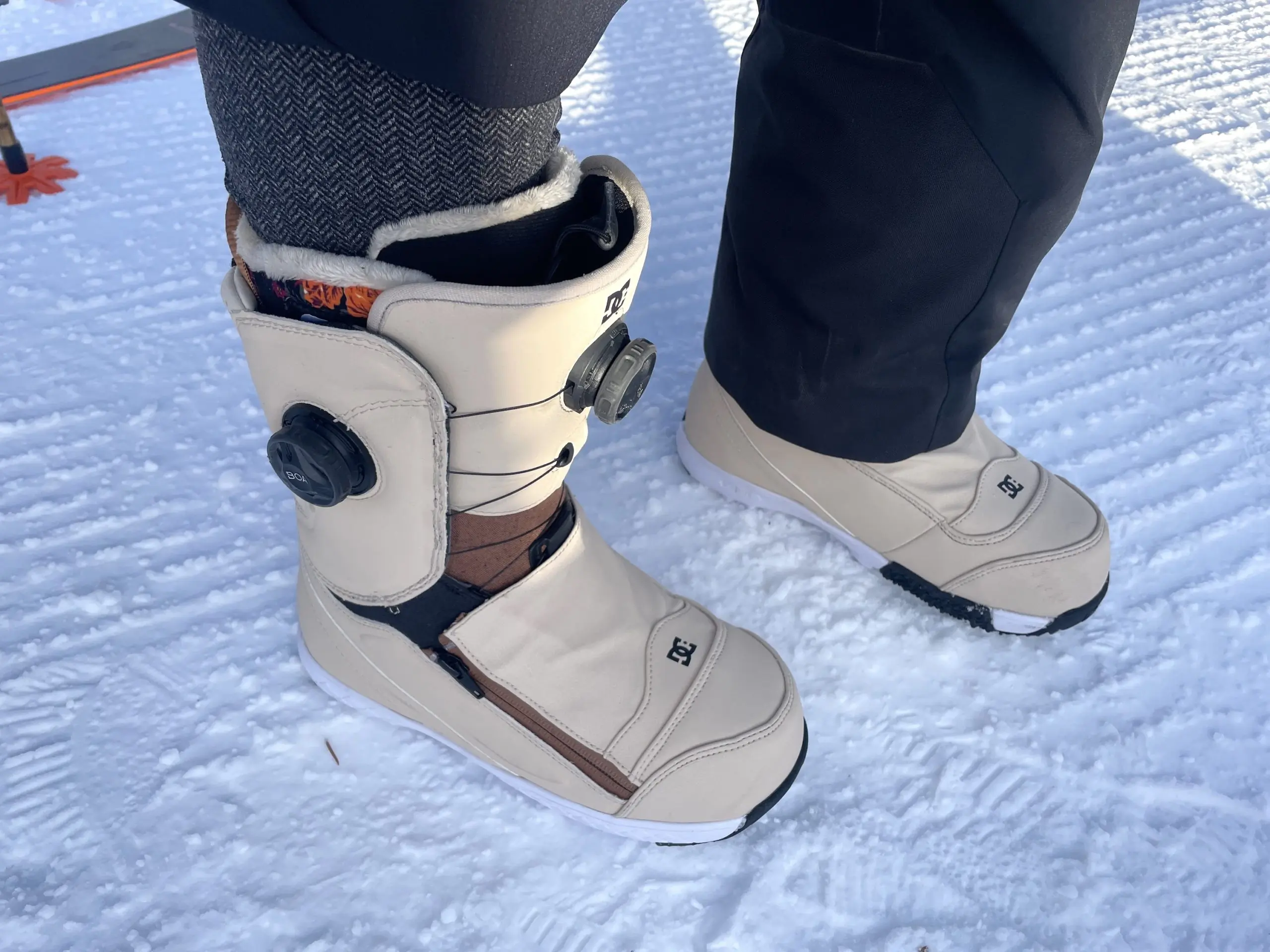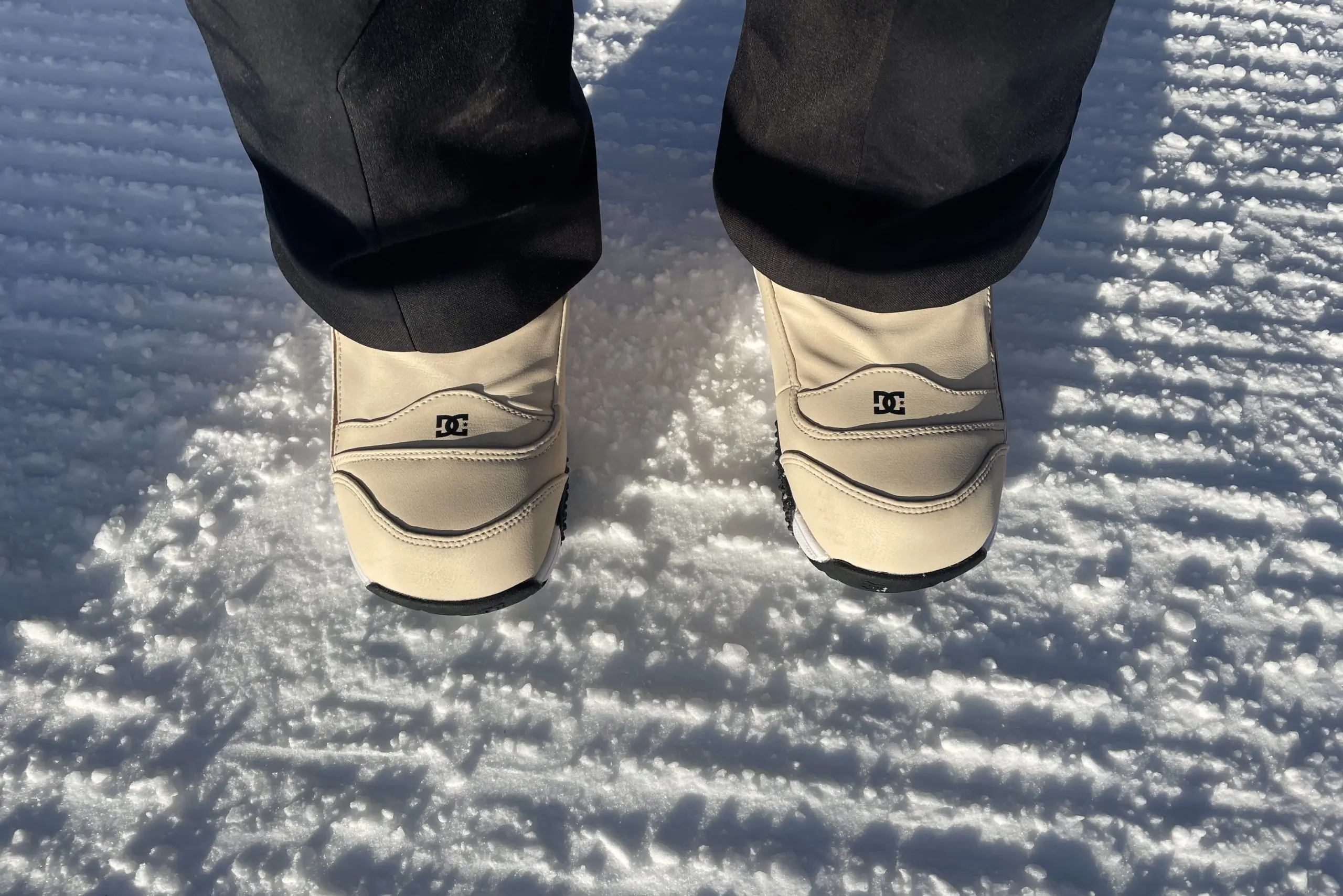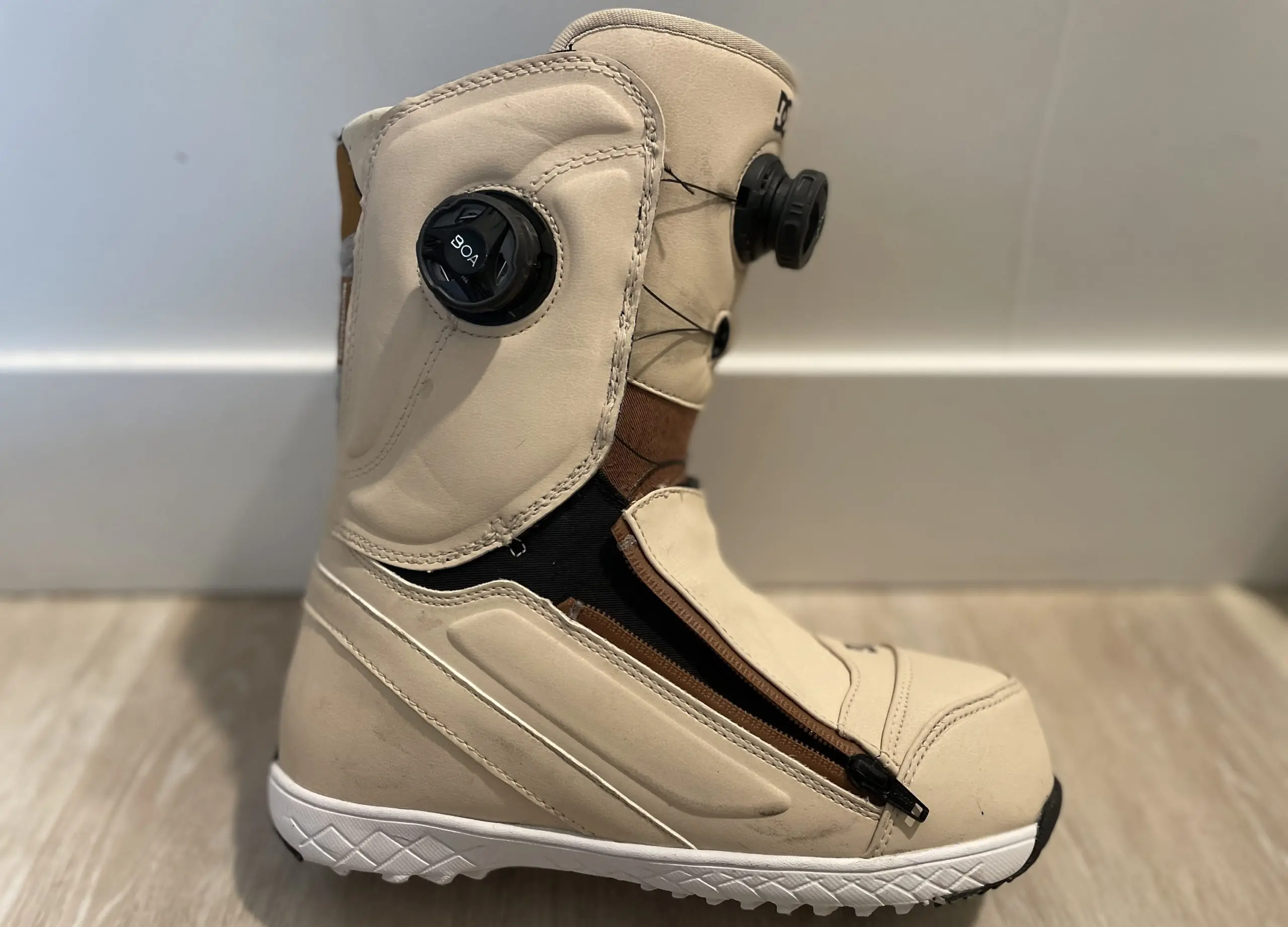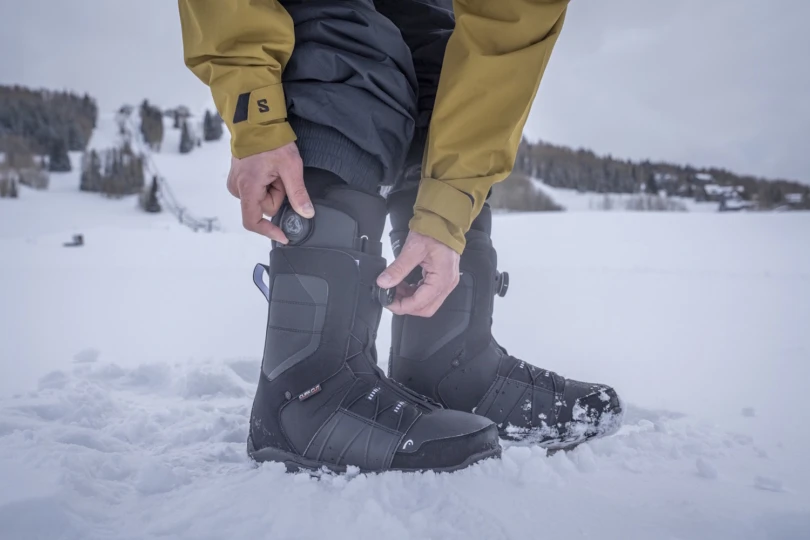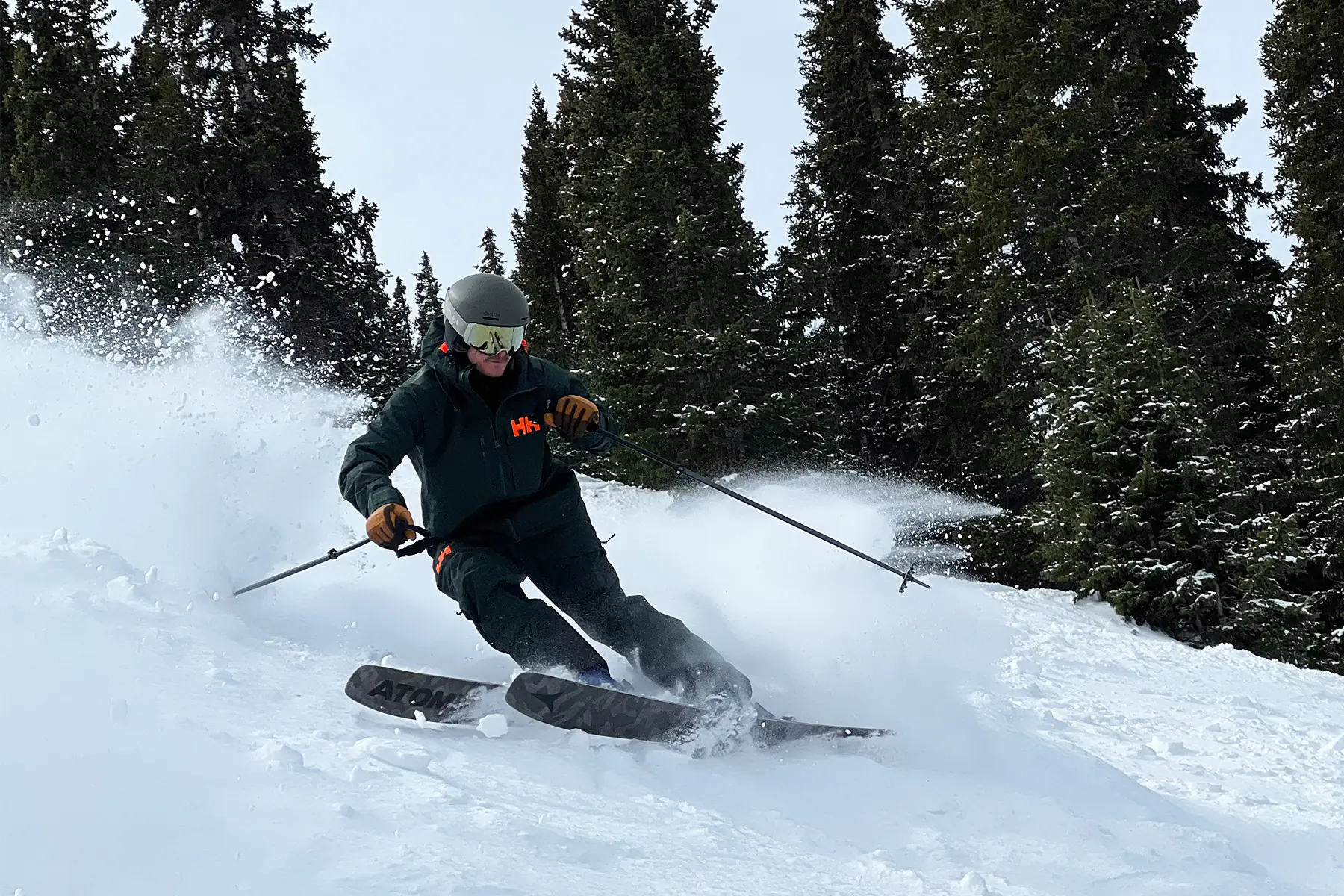Here’s a hot take for you: The most important piece of gear in your snowboard kit is the right pair of snowboard boots. After all, it’s easy to hop on a buddy’s board or demo new bindings, but picking a new pair of boots can be a torturous and time-consuming affair. Land on the right boots, and progression is yours for the taking. Make the wrong choice, and you’ll be babying blisters in the lodge.
To help you on your quest for the perfect snowboarding gear this season, we tested boots from all the top brands. We also divided this list into specific categories so you can easily find a pair of boots that match your riding style and budget. If you’ve been in the boxing ring for a while, check out our two favorite pairs for guys and gals: the Men’s Vans Infuse and Women’s ThirtyTwo Lashed Double BOA. Otherwise, scope out our budget options if you’re still testing the waters.
Editor’s Note: We updated our Snowboard Boots buyer’s guide on October 15, 2025, with the field-tested Burton Mint BOA. We added an extended rating system that includes Fit and Flex, Lacing System, Liner Quality and Heel Hold, as well as Comfort and Cushioning. Jump into the deep pow in our Snowboard Boots Rating System.
Guys: Read about more options in our Best Snowboard Boots for Men, a roundup scribed by snowboard expert Eric Phillips.
The Best Snowboard Boots of 2025-2026
Men’s Vans Infuse
-
Fit and Flex
8.0
-
Lacing System
9.0
-
Liner Quality and Heel Hold
9.0
-
Comfort and Cushioning
8.0
- Flex: Medium to stiff
- Lacing system: Hybrid BOA combines traditional laces with BOA instep adjustment and Velcro power strap
- Ride style: All-mountain
- Experience level: Advanced to expert
Pros
- Versatile crusher that can handle all terrain
- Comfortable right out of the box
- Adjustable flex
- Intuitive and thorough lacing system
Cons
- Too stiff for some mellower freestylers and aspiring intermediates
- Best suited for experienced riders
- We have had issues with these BOA dials — and BOA dials in general — malfunctioning
Women’s Burton Supreme
-
Fit and Flex
8.0
-
Lacing System
8.0
-
Liner Quality and Heel Hold
9.0
-
Comfort and Cushioning
7.5
- Flex: Stiff (6-9/10)
- Lacing system: Burton’s “Speed Zone” quick laces
- Ride style: All-mountain
- Experience level: Intermediate to advanced
Pros
- Packs out less compared to softer boots
- Dual-speed zone lacing system is durable and fast and provides customizable tension
- Stiffest, highest-performance women’s boot in Burton line
Cons
- More expensive choice
- Overwhelming stiffness for beginners and freestyle-oriented intermediates
Burton Moto BOA
-
Fit and Flex
5.0
-
Lacing System
6.0
-
Liner Quality and Heel Hold
7.0
-
Comfort and Cushioning
8.0
- Flex: Soft to medium
- Lacing system: BOA
- Ride style: All-mountain
- Experience level: Beginner to intermediate
Pros
- Very comfortable build
- Lacing system allows for perfect micro-adjustments
- Internal J-bars provide added ankle support
Cons
- Not quite aggressive enough for expert riders
ThirtyTwo Shifty BOA
-
Fit and Flex
8.5
-
Lacing System
6.0
-
Liner Quality and Heel Hold
8.9
-
Comfort and Cushioning
6.5
- Flex: Soft
- Lacing system: BOA
- Ride style: Freestyle
- Experience level: Beginner to intermediate
Pros
- Wallet-friendly
- Out-of-box comfort
Cons
- Lacks support for bell-to-bell ride days
- Softer boots generally break down faster
K2 Waive
-
Fit and Flex
8.0
-
Lacing System
7.0
-
Liner Quality and Heel Hold
9.0
-
Comfort and Cushioning
9.0
- Flex: Stiff (8/10)
- Lacing system: BOA ankle harness, traditional laces with integrated lace locks, Velcro power strap
- Ride style: Freeride, backcountry
- Experience level: Advanced to expert
Pros
- Construction geared toward designated backcountry use
- Highly adjustable and comfortable for confident and aggressive riding
- Best soft boot touring mode we’ve ever tested
Cons
- Expensive
- Slightly bulky compared to your go-to, low-profile solid boots
Vans Viaje Range
-
Fit and Flex
9.0
-
Lacing System
8.9
-
Liner Quality and Heel Hold
9.5
-
Comfort and Cushioning
9.5
- Flex: Medium to stiff (adjustable flex)
- Lacing system: Double BOA
- Ride style: Backcountry, freeride focus
- Experience level: Advanced to expert
Pros
- Adaptive walk mode on cuff for uphilling
- Keeps feet warm in subfreezing temps
- Aggressive lugs for great traction and stability
- Fits narrow feet and heels well
- Tongue stiffeners allow customizable flex from 6 to 9
Cons
- Lacks heel counter for extra crampon security
- D-rings are too small and not reachable by most pant gaiters
Salomon Vista Dual BOA Women’s Snowboard Boots
-
Fit and Flex
6.5
-
Lacing System
7.9
-
Liner Quality and Heel Hold
8.0
-
Comfort and Cushioning
7.5
- Flex: Medium to stiff
- Lacing system: Dual BOA
- Ride style: All-Mountain, freeride
- Experience level: Advanced
Pros
- Dual BOA supports more precise fit
- Foam ankle wrap keeps heel locked in
- Very compact exterior
Cons
- Insole is not very supportive — we suggest adding your own
- Bit of a break-in period for the plush Precision liner: We suggest heat molding
- Not the warmest option on the boot rack
Other Shred-Ready Snowboard Boots We Dig
-
Fit and Flex
8.5
-
Lacing System
8.5
-
Liner Quality and Heel Hold
8.5
-
Comfort and Cushioning
8.5
- Flex: Stiff (8/10)
- Lacing system: Dual BOA adjustment
- Ride style: Freeride
- Experience level: Intermediate to advanced
Pros
- Precise adjustability
- Impressive comfort
- Trustworthy option for off-piste riding
Cons
- On the expensive side
-
Fit and Flex
8.0
-
Lacing System
8.0
-
Liner Quality and Heel Hold
8.0
-
Comfort and Cushioning
8.0
- Flex: Medium (5-8/10)
- Lacing system: Dual BOA and power strap
- Ride style: All-mountain
- Experience level: Intermediate to advanced
Pros
- Easy and convenient binding system
- Boots are comfortable
- Locked heel increases power in riding
Cons
- Requires compatible bindings
- Pricier
-
Fit and Flex
7.0
-
Lacing System
9.0
-
Liner Quality and Heel Hold
7.5
-
Comfort and Cushioning
8.0
- Flex: Soft (3/10)
- Lacing system: Traditional laces
- Ride style: Freestyle
- Experience level: Beginner to intermediate
Pros
- Affordable and stylish
- Simple design
- Soft-flex rating is ideal for beginner riders and intermediate park riders
- Comfortable to walk in
Cons
- Degrade faster
- Too soft for some all-mountain applications and freeriding
-
Fit and Flex
7.5
-
Lacing System
8.0
-
Liner Quality and Heel Hold
8.9
-
Comfort and Cushioning
8.5
- Flex: Medium (6 out of a 1 to 10 scale)
- Lacing system: Double BOA
- Ride style: All-mountain
- Experience level: Intermediate to advanced
Pros
- Durable construction
- Versatile all-mountain boot
- Easy lacing
- Ample comfort
Cons
- Some complaints about warmth
-
Fit and Flex
6.0
-
Lacing System
7.5
-
Liner Quality and Heel Hold
7.5
-
Comfort and Cushioning
8.0
- Flex: Softer side (3/10)
- Lacing system: BOA
- Ride style: Freestyle
- Experience level: Beginner to intermediate
Pros
- Forgiving for playful tricks and jibs
- Great price
Cons
- Lacks dual BOA system for better customization
-
Fit and Flex
6.0
-
Lacing System
8.0
-
Liner Quality and Heel Hold
7.5
-
Comfort and Cushioning
8.0
- Flex: Soft
- Lacing system: Single BOA
- Ride style: All-mountain and park
- Experience level: Beginner to Intermediate
Pros
- Soft, flexible and comfortable
- Integrative reflective foil provides warmth
- Single BOA makes
Cons
- Minimal support for aggressive riding
- Single BOA does not offer targeted tightening like double BOA
- Shallower lugs are not as strongly suited for hiking
-
Fit and Flex
8.0
-
Lacing System
7.9
-
Liner Quality and Heel Hold
8.5
-
Comfort and Cushioning
7.9
- Flex: 7/10
- Lacing system: Double BOA
- Ride style: All-mountain, freeride
- Experience level: Intermediate to Advanced
Pros
- Plush EVA midsole
- Anatomical footbed
- Lightweight
Cons
- No bonus material for retaining body heat
-
Fit and Flex
7.0
-
Lacing System
8.0
-
Liner Quality and Heel Hold
8.5
-
Comfort and Cushioning
9.0
- Flex: Medium
- Lacing system: Double BOA
- Ride style: All-mountain
- Experience level: Intermediate to Advanced
Pros
- Comfortable footbed and midsole with no break-in period
- Dual-zone BOA is adjustable and quick
Cons
- When you ride aggressively, dual BOA system needs tightening throughout the day
- Ample ankle flexibility in the coronal (vertical) plane might not be everyone's cup of tea
-
Fit and Flex
8.5
-
Lacing System
8.0
-
Liner Quality and Heel Hold
6.5
-
Comfort and Cushioning
7.0
- Flex: Stiffer, 7 out of 10 (on a 1-10 scale)
- Lacing system: Dual BOA Fit System with BOA SS laces
- Ride style: All-mountain, freeride
- Experience level: High intermediate to advanced
Pros
- Always kept our feet warm and dry
- All-around stiffness
- Quality build
Cons
- Wish the harness cinch and power strap were easier to adjust
- Beginner to intermediate boarders might not want this stiff boot
Snowboard Boots Comparison Chart
Scroll right to view all of the columns: Price, Flex, Lacing, Ride Style, Experience Level.
| Snowboard Boot | Price | Flex | Lacing | Ride Style | Experience Level |
| Men’s Burton Moto BOA | $280 | Soft | Single BOA | All-mountain | Beginner to Intermediate |
| Women’s ThirtyTwo Lashed Double BOA | $400 | Medium | Double BOA | All-mountain | Intermediate to Advanced |
| Women’s Vans Viaje Range | $460 | Medium to Stiff | Double BOA | Backcountry, Freeride | Advanced to Expert |
| Men’s DC Phase | $200 | Soft | Laces | Freestyle | Beginner to Intermediate |
| Women’s Ride Harper | $250 | Soft | Single BOA | Freestyle | Beginner to Intermediate |
| Women’s ThirtyTwo Shifty BOA | $260 | Soft | Single BOA | Freestyle | Beginner to Intermediate |
| K2 Waive | $590 | Stiff | Single BOA & Laces | Freeride, Backcountry | Advanced to Expert |
| Women’s Burton Supreme | $550 | Stiff | Speed Zone Quick Laces | All-mountain | Intermediate to Advanced |
| Salomon Vista Dual BOA Women’s Snowboard Boots | $450 | Medium to stiff | Dual BOA | All-Mountain, freeride | Advanced |
| Burton Mint BOA | $280 | Soft | Single | All-mountain and park | Beginner to Intermediate |
| Women’s K2 Trance | $380 | Stiff | Double BOA | All-mountain | Intermediate to Advanced |
| Vans Women’s Encore Pro Snowboard Boots | $310 | Medium | Double BOA | All-mountain | Intermediate to Advanced |
| DC Mora BOA Women’s Snowboard Boots | $420 | Stiff | Double BOA | All-mountain, Freeride | Intermediate to Advanced |
| Men’s Vans Infuse | $420 | Medium to Stiff | Single BOA & Laces | All-mountain | Advanced to Expert |
| Men’s Burton Ion BOA | $690 | Stiff | Double BOA | Freeride | Intermediate to Advanced |
| Men’s Burton Photon Step On | $500 | Medium | Double BOA with over-foot strap | All-mountain | Intermediate to Advanced |
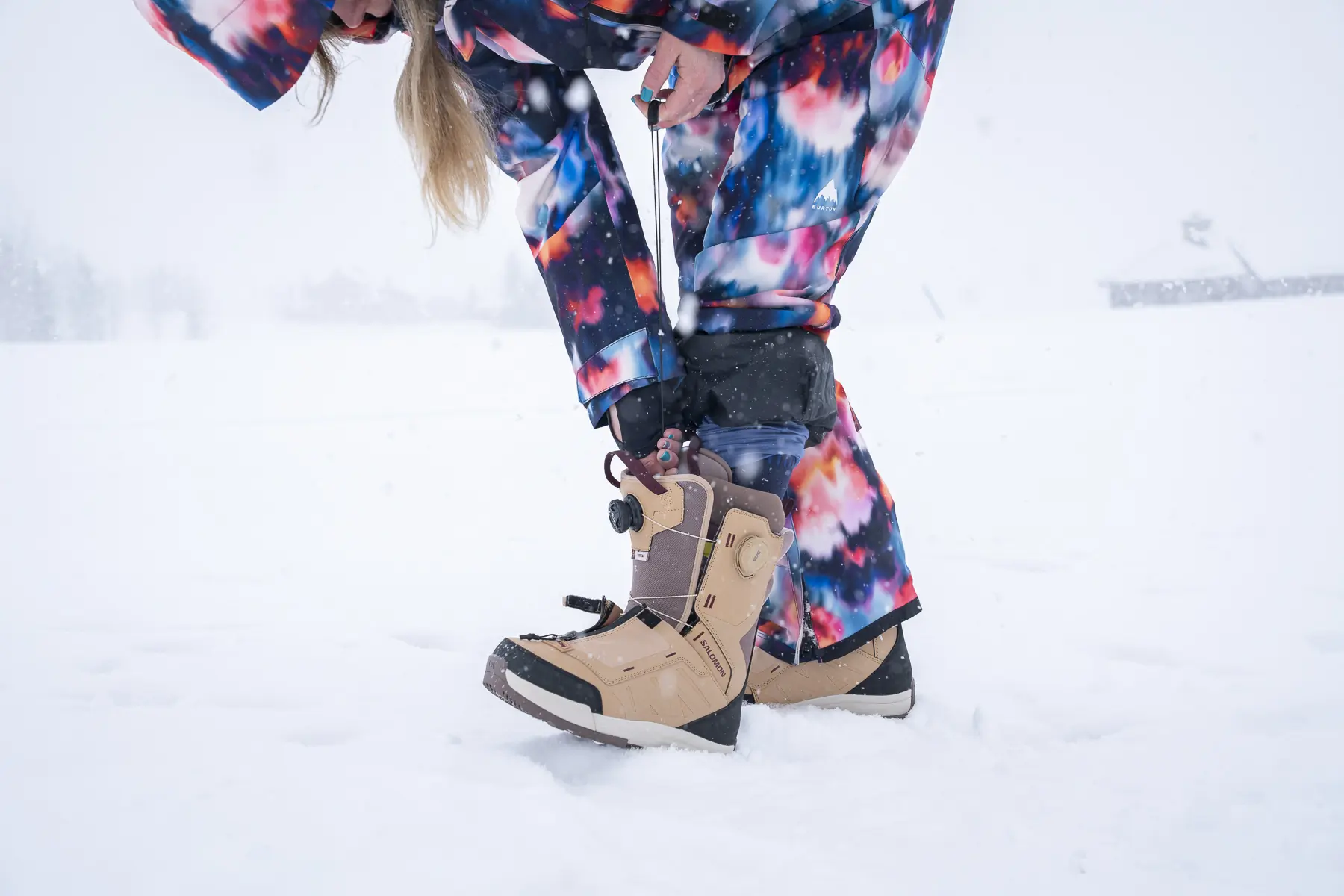
How We Tested Snowboard Boots
While our snowboard boot testers frequent ski resorts, many of us are also diehard splitboarders and mechanized backcountry users with AIARE 2 certifications, testing boots deep in unforgiving backcountry zones.
We’ve faced plenty of challenges with finding the best-fitting snowboard boots, due to foot shape and injuries, and are aware of the obstacles.
Our Expert Testers
Leading the gear testing, Snowsports Senior Editor Morgan Tilton has been snowboarding since 2002. She’s a splitboarder, snowmobiler, and pow surfer. Contributor Austin Beck-Doss has been snowboarding since 2005. Other contributors include Nate Mitka and Mattie Schuler.
Our off-piste testers have included Whitney Gilliam, an AIARE instructor and avid splitboarder based in Southwest Colorado. Longtime GearJunkie contributor Drew Zieff has also chipped in with testing — he’s the director of Backcountry Magazine’s splitboard test and Outside Magazine’s snowboard test.


Our Testing Grounds
Our test team is centered in Crested Butte, Colo., home to world-class resort steeps and legendary backcountry riding. We also have testers based in the Tahoe Sierra and Colorado’s Front Range, including test laps at Eldora Mountain.
Boots in this guide were also tested everywhere from Jackson Hole, Wyo., and Thompson Pass, Alaska, to Bella Coola, British Columbia, and Swedish Lapland.
The GearJunkie team meets for an annual on-snow test week to grind out turns and swap notes, including two previous gatherings at Crested Butte Mountain Resort, which is known for its expert terrain.
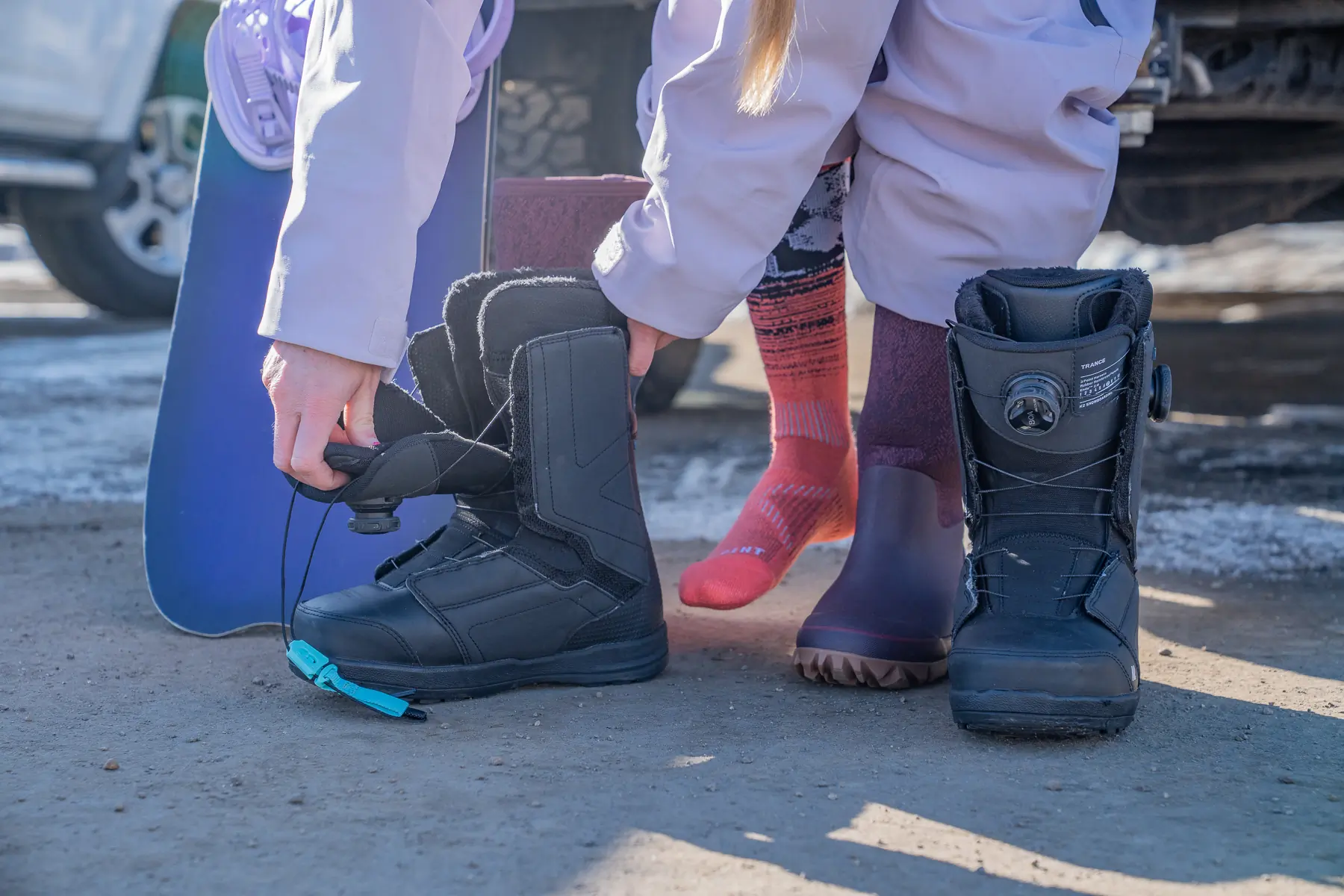



Our Testing Process
While testing our boots, we consider overall fit, stiffness level, durability, comfort, support, outsole grip, warmth, insulation, odor resistance, heel loop, tread, and lace design. We also consider the most popular, highly rated, and legacy products across a range of price points, performance, and style.
But boots are also subjectively ideal for certain feet. For reference, Beck-Doss has wide feet and a high arch. Zieff has narrow feet and unfortunately long second toes, as does Tilton, plus that very narrow heel. She’s experienced superficial frostbite on both feet — the first level of frostbite damage — which made her feet extremely sensitive to cold. We definitely recommend trying on your boots — or 12 of them — to narrow down which brand’s last is a best fit for you.
Otherwise, we’re confident this list includes the best snowboard boots on the market for a range of athletes, goals, and budgets.
Our Snowboard Boots Rating System
We score each pair of snowboard boots on a 1–10 scale for Fit and Flex, Lacing System, Liner Quality and Heel Hold, and Comfort and Cushioning.
Fit and Flex: The most critical factor of a boot design is how it fits. It should feel snug without any pressure points. While there’s a spectrum of foot shapes and sizes, there’s a general quality to a boot fit that makes it a solid match for most people. The flex rating plays a role in how versatile the boot is. The softer it is, the less likely it is to be an everyday queen. The firmest boots also tend to be best for specific objectives versus all-day, every-day rippers.
Lacing System: A huge variety of systems are out there. Double, single, and triple BOA. Traditional laces. And a hybrid of the two, as well as speed laces and power straps. Each system has tradeoffs between speed, comfort, personalization, rigidity, dependability, and durability.
Liner Quality and Heel Hold: Most of our favorite boots have heat-moldable liners. Liners have unique internal harnesses for security, so we test how easy those are to enter and exit, as well as the degree of security. The heel hold is a huge factor. We need our heel to stay put and for cushion to be in all the right places.
Comfort and Cushioning: These points go up in a boot depending on the comfort and design of the footbed, as well as the midsole cushioning and the overall breathability of the liners and exterior.
The Overall Rating is based on contextual, editorial judgment, and the complex user experience across various scenarios and conditions.
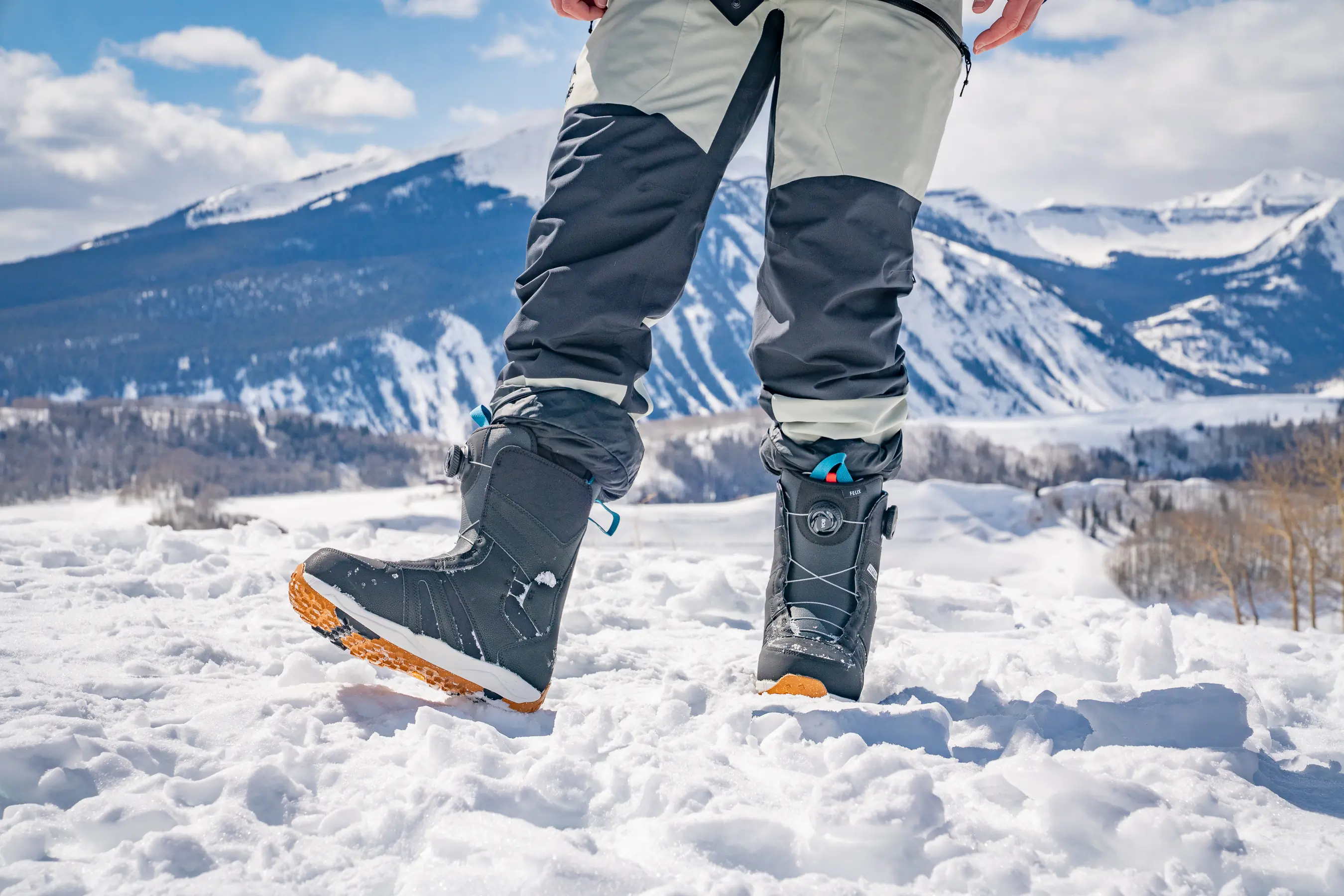



Buyer’s Guide: How to Choose the Best Snowboard Boots
For starters, snowboard boots are generally categorized by terrain preference or rider “style.”
Style
The three most common categories are all-mountain, freeride, and freestyle, followed by a fourth small category that’s growing in popularity: backcountry. Here’s a basic breakdown of riding style.
- All-mountain: All-mountain covers everything from Groomers and powder to jumps and jibs
- Freeride: Off-piste (backcountry, slackcountry, side country, big mountain), steep terrain, firm snow
- Freestyle: Half pipe, jumps, jibs, tricks in the park and around the mountain
- Backcountry: Ascending and descending slopes out-of-bounds, uphilling at the resort
Backcountry Snowboard Boots
Most backcountry boots are freeride boots with backcountry-specific features, but they’re not the only boots that work in the backcountry — far from it. If you’re a splitboarder, you’ll want a stiffer, technical, off-piste-oriented boot like the K2 Waive. These boots have specific features tailored to backcountry travel, like a walk mode, deep lugs for traction, and a crampon-compatible outsole.
However, depending on personal preference, mode of transportation, and your backcountry objectives, some freeride, all-mountain, or even freestyle snowboard boots could work well in the backcountry, too. For instance, if you’re using a snowmobile to access a backcountry zone and then building a booter, you don’t need a walk mode at all, and a freestyle boot might provide the flex you’re looking for.
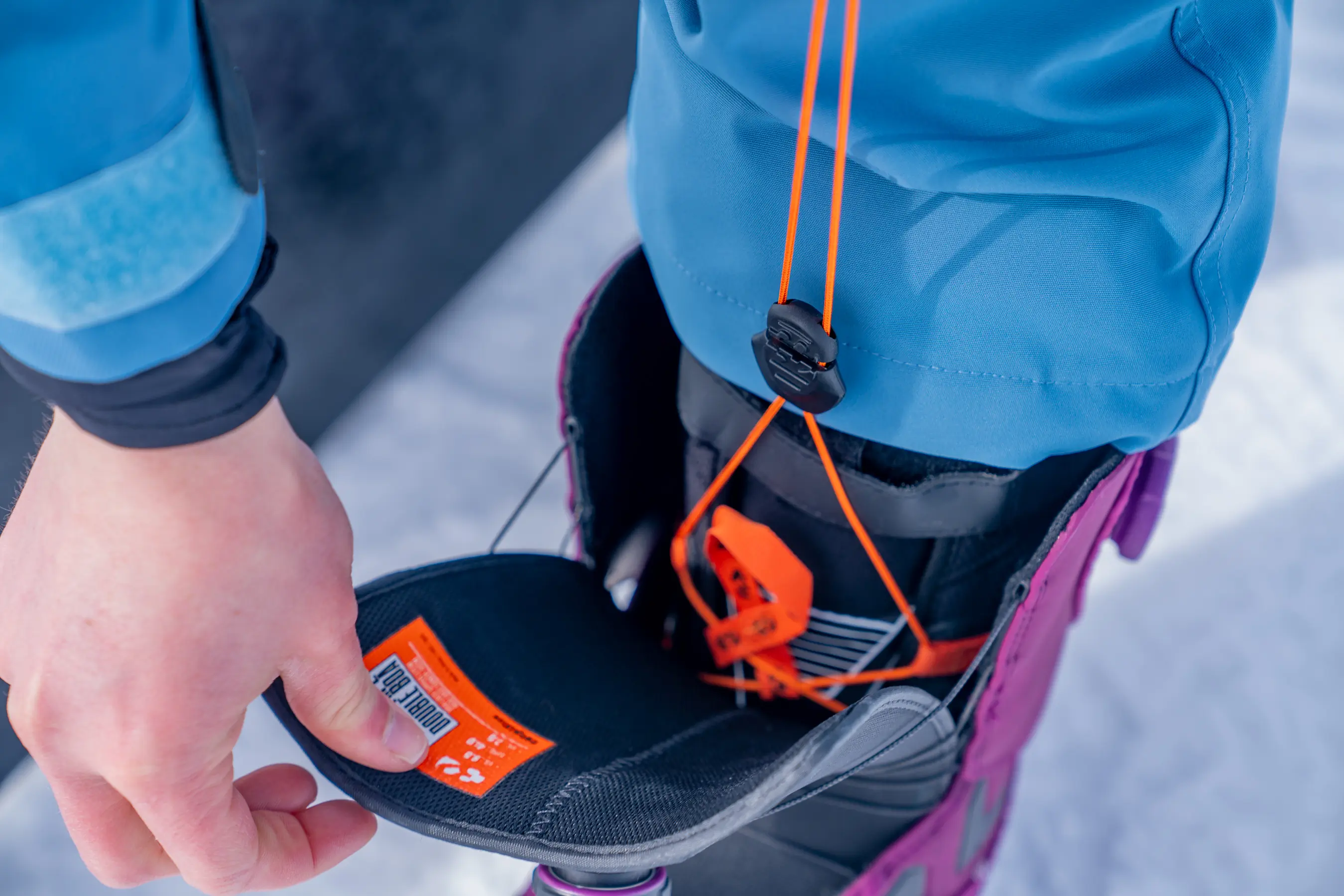



Women’s vs. Men’s Snowboard Boots
Snowboard boots are broadly categorized for men or women. The biggest difference between the anatomy of women and men is that the calf muscle is lower on a woman’s leg. For better support and comfort, the cuff of a woman’s snowboard boot is shorter in length.
Women’s boots also generally have a narrower heel, a more streamlined shape, and greater flex. Some women with longer or wider feet find men’s boot options work great. For some men with narrower feet, women’s boots are a better fit.
Hard Boots vs. Soft Boots
The vast majority of snowboarders are looking for soft boots — these are traditional snowboard boots crafted from materials like leather, rubber, and various fabrics, and they’re traditionally considered the best boots for snowboarding. However, a select group of snowboarders, particularly splitboarders who spend long days in the backcountry, may be interested in hard boots.
Hard boots are crafted from plastic and closely resemble ski boots. In fact, one of our favorite splitboard hard boots, the Phantom Slipper, is quite literally a splitboard-specific riff off of a popular backcountry ski boot, the Atomic Backland.
The benefit of a hard boot over a soft boot is the walk mode. Hard boots have much better walk modes than their soft boot cousins, as the hard plastic pieces can pivot much more efficiently than high-friction materials in soft boots. The Phantom Slipper and the Key Equipment Disruptive, for instance, both have a much bigger range of motion in walk mode than even the K2 Waive, our favorite soft boot for backcountry snowboarding.
Additional benefits of hard boots? Some riders, particularly those with racing backgrounds, will appreciate the level of response that comes from switching to a plastic boot. Also, hard boots are much better for sidehilling, kicking steps, and utilizing crampons.
However, the main demerit of hard boots can be an unsurmountable one: some riders, particularly those with freestyle backgrounds, will miss the comfort and ride quality of soft boots.
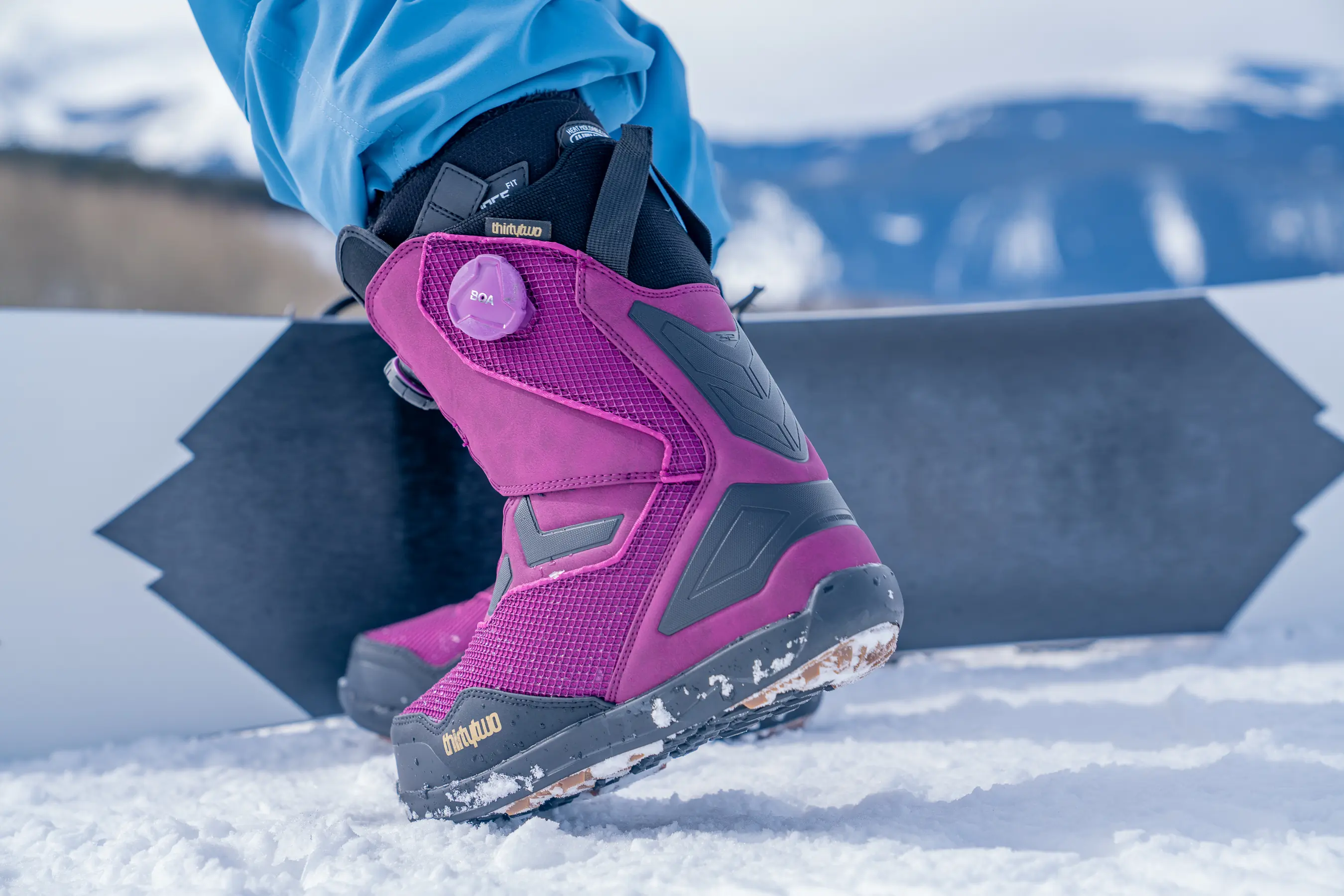



Step-On Snowboard Boots
Step-in snowboard boots are designed to be used with step-in snowboard bindings. These boots incorporate built-in attachment points that allow the boot, when engaged, to lock directly onto designated bindings with mirroring attachment points.
For some riders, these systems minimize time while strapping in and also help make the boot’s connection with the binding consistent across runs. Some riders like being able to stand up straight while sliding their boot in versus bending over or sitting down.
On the other hand, some riders will miss the ride quality and feel of traditional bindings, as well as the customized pressure from run to run. As such, we mainly recommend these systems for aging parents trying to keep up with their kids, riders with injuries that make bending over difficult, and adults who are just learning how to snowboard.
While you might dig step-in systems for ease of use or other reasons, we highly recommend demoing before purchasing.
Step-In Setups
There are a couple of step-in boot and binding systems on the market, most notably K2’s Clicker and Burton’s Step On. By far, the best step-in interface on the market is the Burton Step On system, hence our inclusion of the Burton Photon Step On as our favorite step-in compatible boot. In partnership with Burton, DC, and Nitro both launched their own goods with the Step On technology.
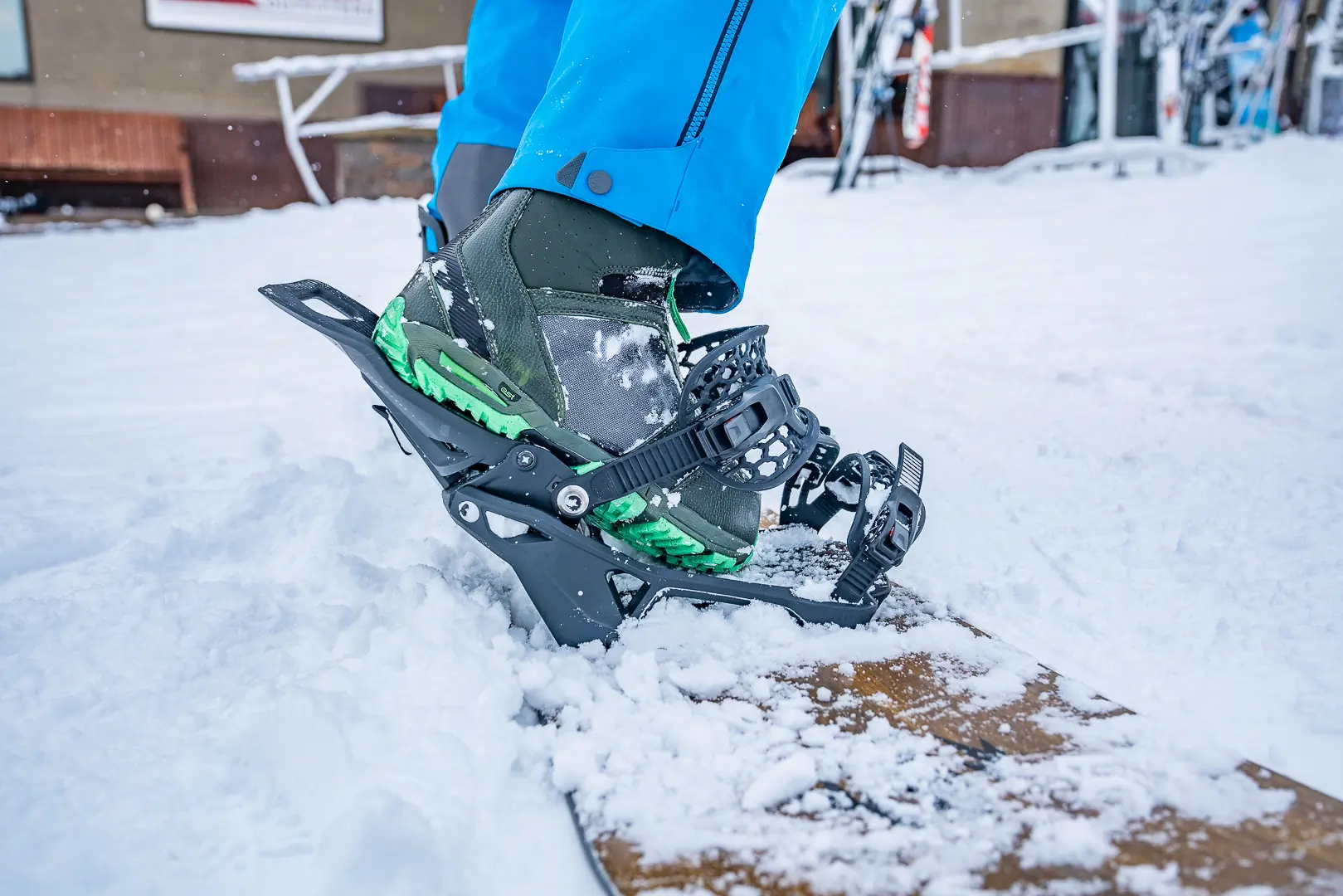



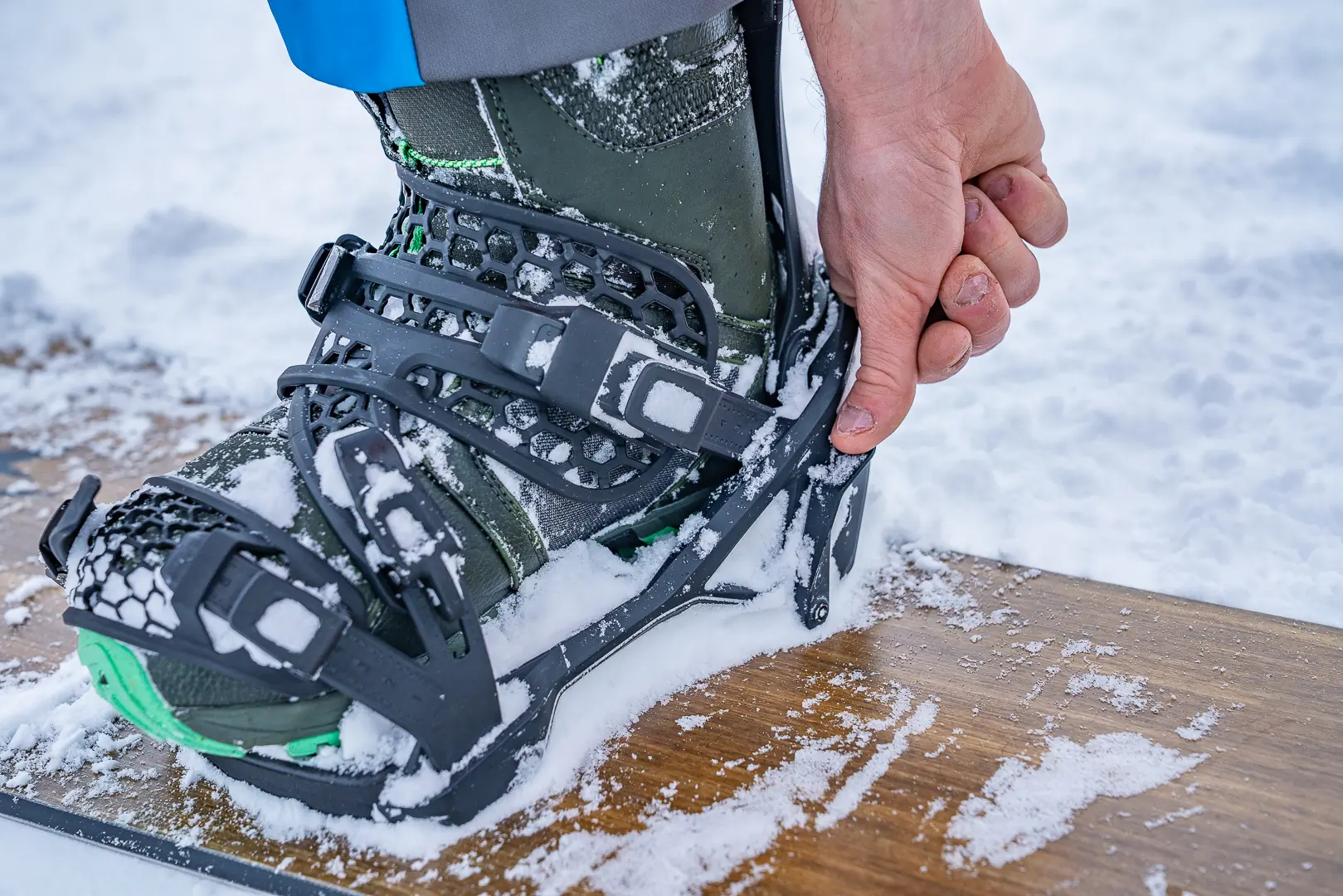



It is worth noting that Burton Step On boots aren’t compatible with normal strap bindings due to their bulky tongue design — with a single BOA strap that goes across the front of the ankle — and neither are the K2 Clicker boots, which have metal components embedded into the outsoles.
Long story short? Try step-in systems before you buy, and plan to invest in a separate pair of boots and bindings if you’re going the step-in route.
Here are the various setups that are available today:
Step-In Boots Only Compatible With Burton Step On Bindings
- Nitro Cave TLS and Profile TLS ($420): made with the Burton Step On Snowboard Boots interface
- DC Men’s Phase, Judge, or Control BOA and two women’s models ($370-450): made with the Burton Step On Snowboard Boots interface
- Burton has 12 models, including a kids’ pair and wide widths for men and women ($200-620)
- K2 Clicker X HB: five models ($370-550) only compatible with the K2 Clicker Step-In Snowboard Bindings
Step-In, Rear-Entry Bindings Compatible With Traditional Snowboard Boots
- Nidecker Supermatic Snowboard Bindings ($400) — Nidecker acquired Flow in 2017, so there are Flow step-in bindings, too
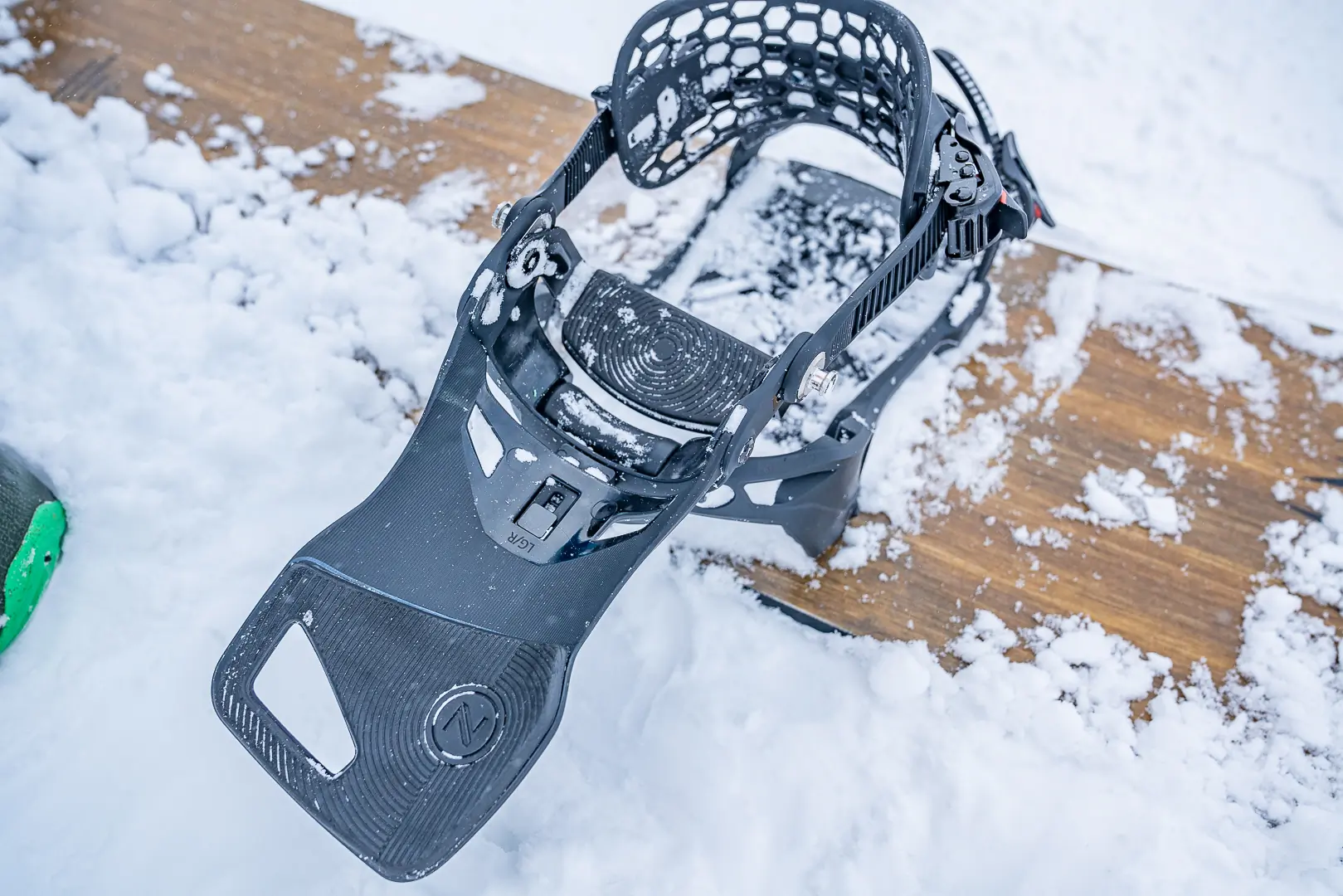



Clicking In: Burton Step On
All Burton Step On boots have two attachment points on either side of the toebox and one on the heel. Burton Step-On bindings have corresponding attachment points. When you step into the Step On bindings, the toes and heels lock, and you have three points of contact for a secure, responsive ride.
Clicking Out: Burton Step On
To release, you pull a simple lever, and the boot pops free. It’s a fairly easy system once you get used to it, although some riders report difficulty when using Step Ons on steep slopes or in powdery snow.
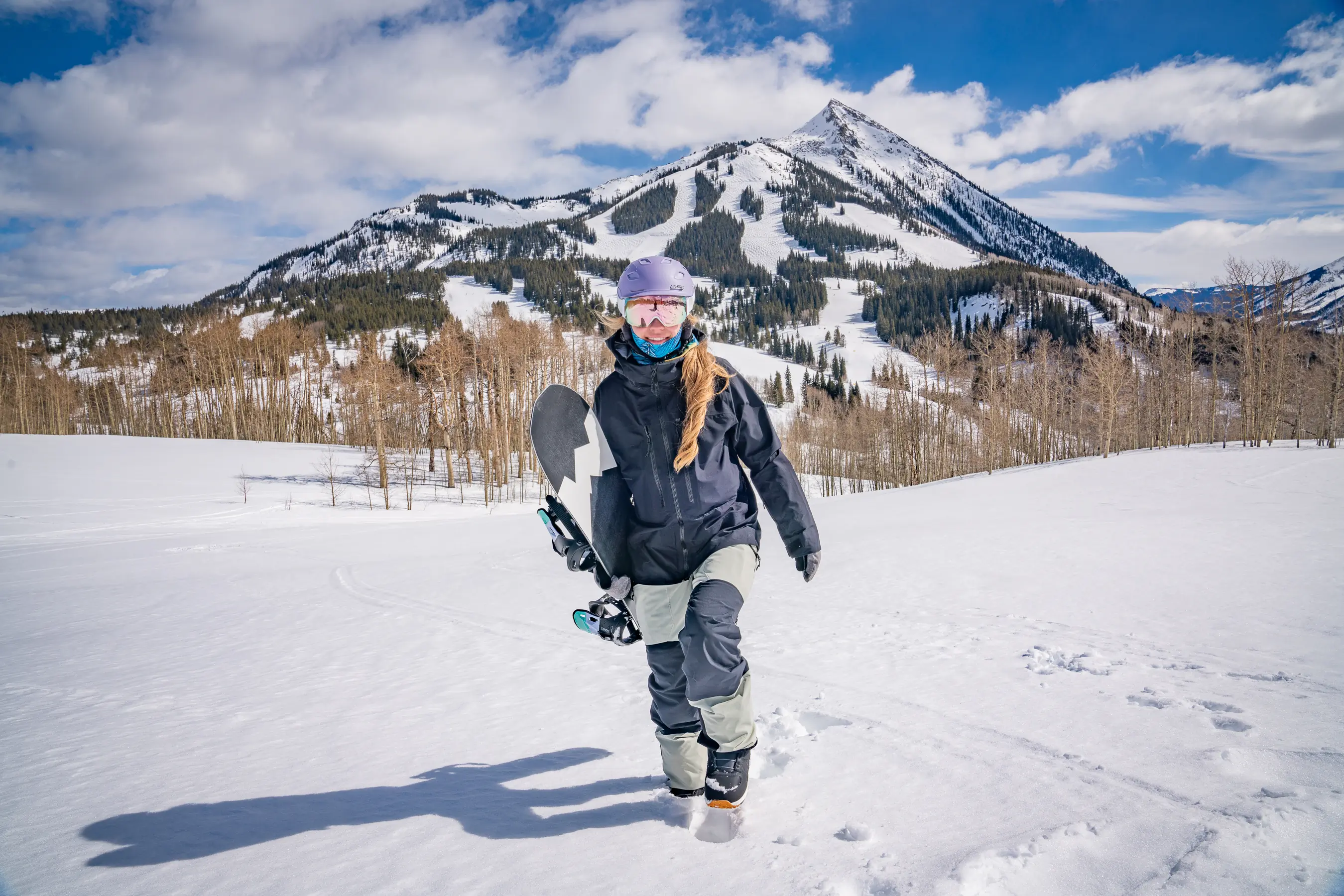



Fit & Sizing
Beyond these two broad categories — men’s and women’s snowboard boots — snowboard boots can have a narrow, wide, or regular width. Their shape can also be more precise and streamlined for refined performance.
It’s important to determine your correct boot size for a particular boot, which can vary slightly from brand to brand. The best way to determine your boot size is to visit a retailer, get accurate foot measurements, and try on different pairs with your preferred snowboard socks.
When you wear snowboard boots, your toes can lightly graze the front of the boot, but you don’t want your toes to curl under. You also want to be sure there’s no heel lift, an indicator that the boots are too long or wide.
Be sure to go to your local snowboard boot shop to try on boots across different brands so that you have an idea of which size boot for each brand fits your feet. The size runs across each brand, and the tightness across styles of boots is unique.
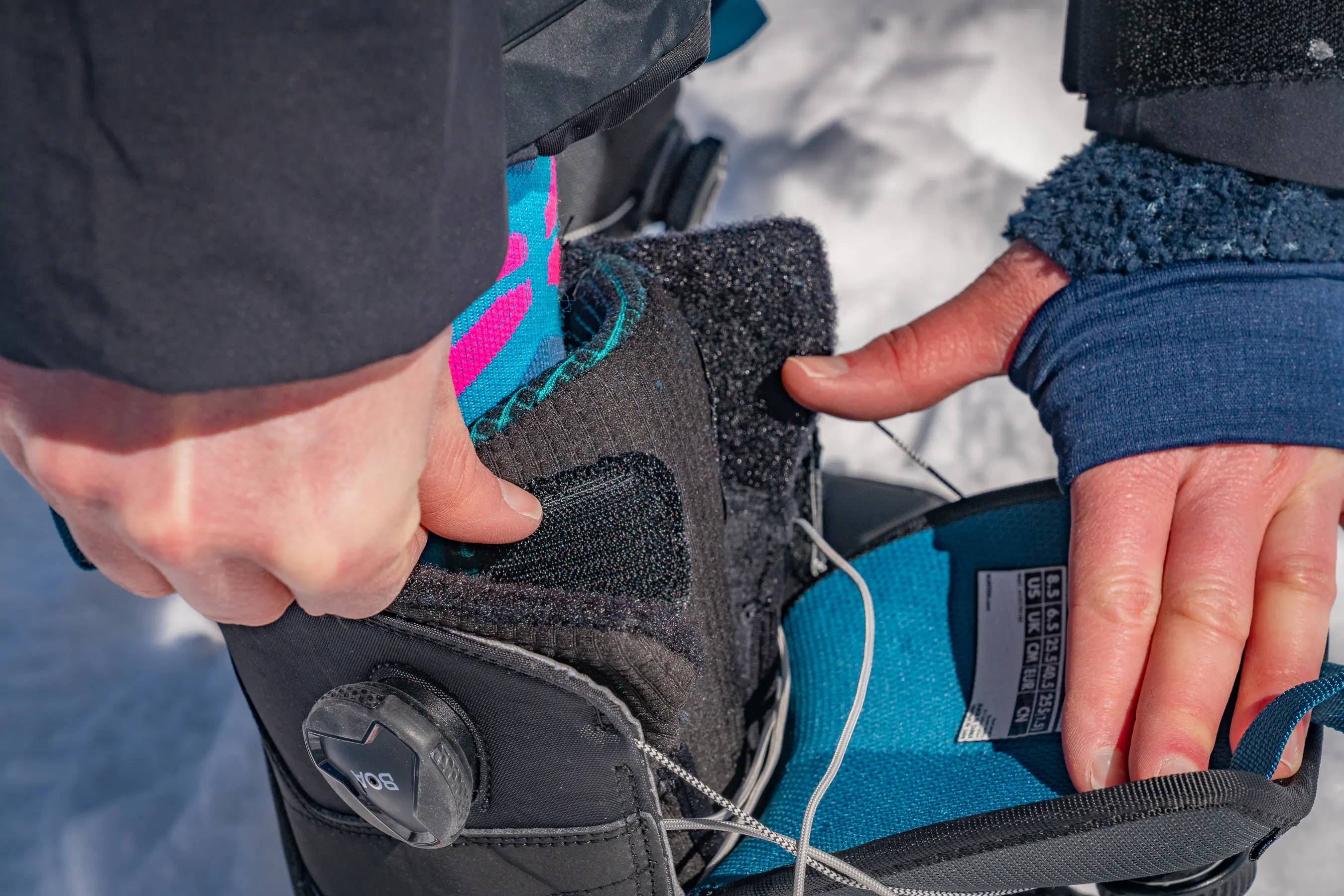



A Note on Sizing Down Boots
With an age-old perspective, many aggressive or elite snowboarders swear on “sizing down.” Sizing down refers to getting a smaller snowboard boot size than your standard shoe size — say, an 8 boot if you usually wear a 9 shoe. The idea here is that all boots pack out, and once you do pack out the smaller-sized boots, the boots will fit perfectly.
But with the advancement of snowboard boot designs, available customization, and the skills of boot technicians, we recommend going to a local shop to work with the on-site boot fitter and customize the materials to your foot. That way, you can skip some of the aches and pains.
Breaking in and packing out smaller boots can be extremely painful, as circulation problems and blisters are par for the course. The benefit of sizing down is that you’ll eventually find better responsiveness with a snugger fit. If your feet are swimming around in your boots after they pack out, you’re not going to get next-level response.
However, it’s tough to enjoy snowboarding if your feet are on fire, so for the most part, we recommend you find a pair of boots that are snug and reasonably comfortable, or at least tolerable, from the jump. The best boots for snowboarding, especially if you’re a casual rider, are the ones that let you ride all day without pain.
If you’re smack dab between sizes, go with the smaller size, and expect a short but painful break-in period.


Get Your Boots Fit by the Pros
Many skiers won’t shop for ski boots without visiting a trusted boot fitter. Snowboarders, on the other foot, don’t place as much value on boot fitters, which is, in our opinion, a huge mistake. Boot fitters can point you to the right boots for your skill level and foot shape, or, if you already have a pair of boots, help customize the fit to the shape of your foot. Here are a few ways we’ve had boot fitters help us in the past:
- Throw flimsy, stock insoles in the trash and replace them with custom footbeds.
- Heat-mold liners. Heat molding liners is a great way to speed up the break-in process. While it’s possible to do this at home, boot fitters have the right tools and tricks to ensure success.
- Punch out hard boots like the Phantom Slipper.
Finding the right boot fitter is tough, as many boot fitters are skiers, and you want an expert boot fitter who also is an expert snowboarder. If you’re in the Sierra, stop by Tahoe Sports Hub and ask for John Lauer — he’s our go-to guy.
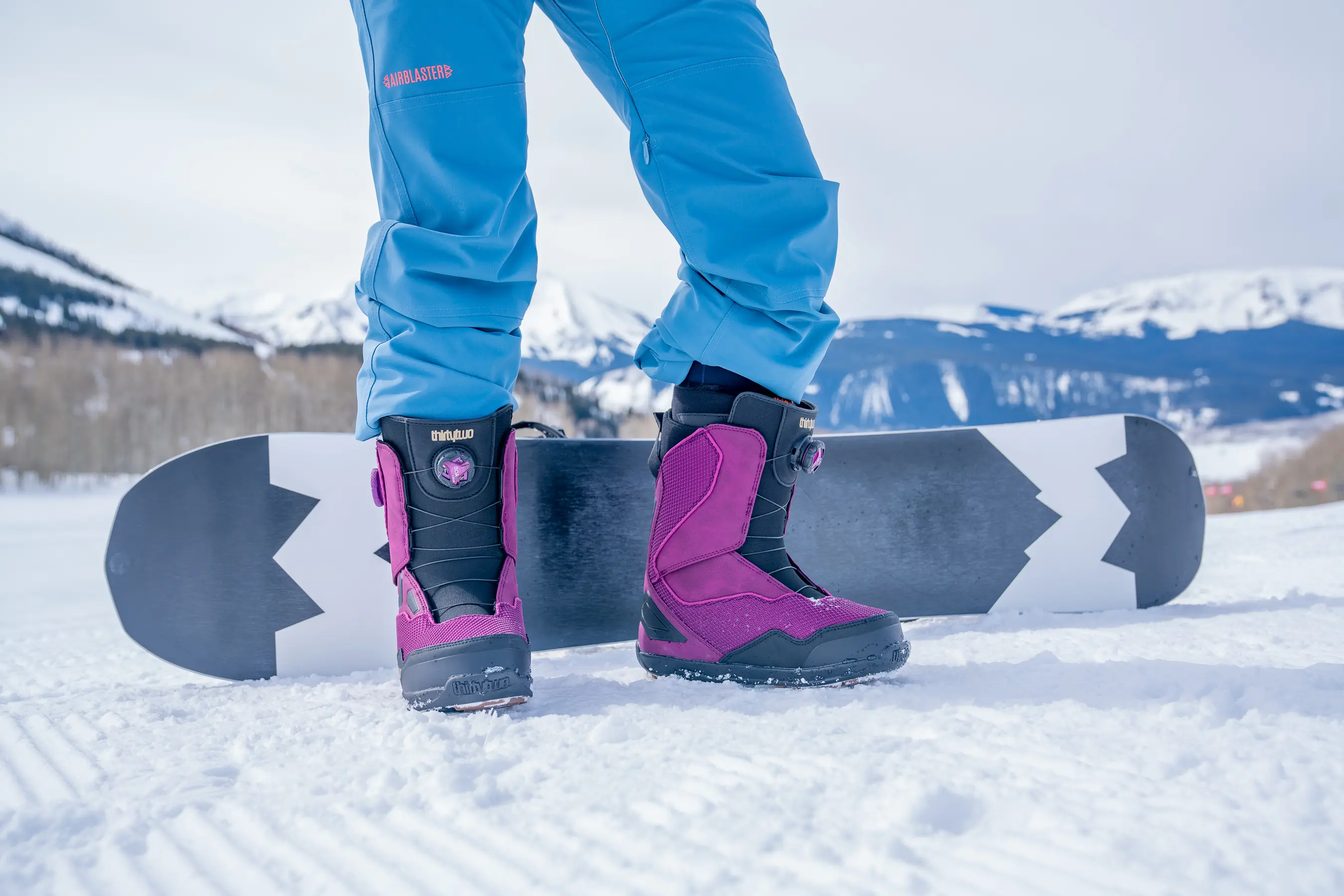



Shims, J-Bars, and Other Boot-Fitting Tricks
While punching and heat-molding will provide you with more room inside snowboard boots, sometimes, you’re actually going to want less space. Less space can result in less blister-inducing foot movement and more response. Using a shim to take up real estate beneath the insole, or boomerang-shaped J-bars on the ankle to hold your heel, are two popular ways to fix common problems.
Some boots, like those from ThirtyTwo, come with helpful heel-hold kits, making it easy for casual riders to tweak the fit. Burton has a J-bar pack, too, that can be a lifesaver. If you’re not confident or looking to DIY, again, this is a fit issue that most boot fitters can solve in a matter of minutes.
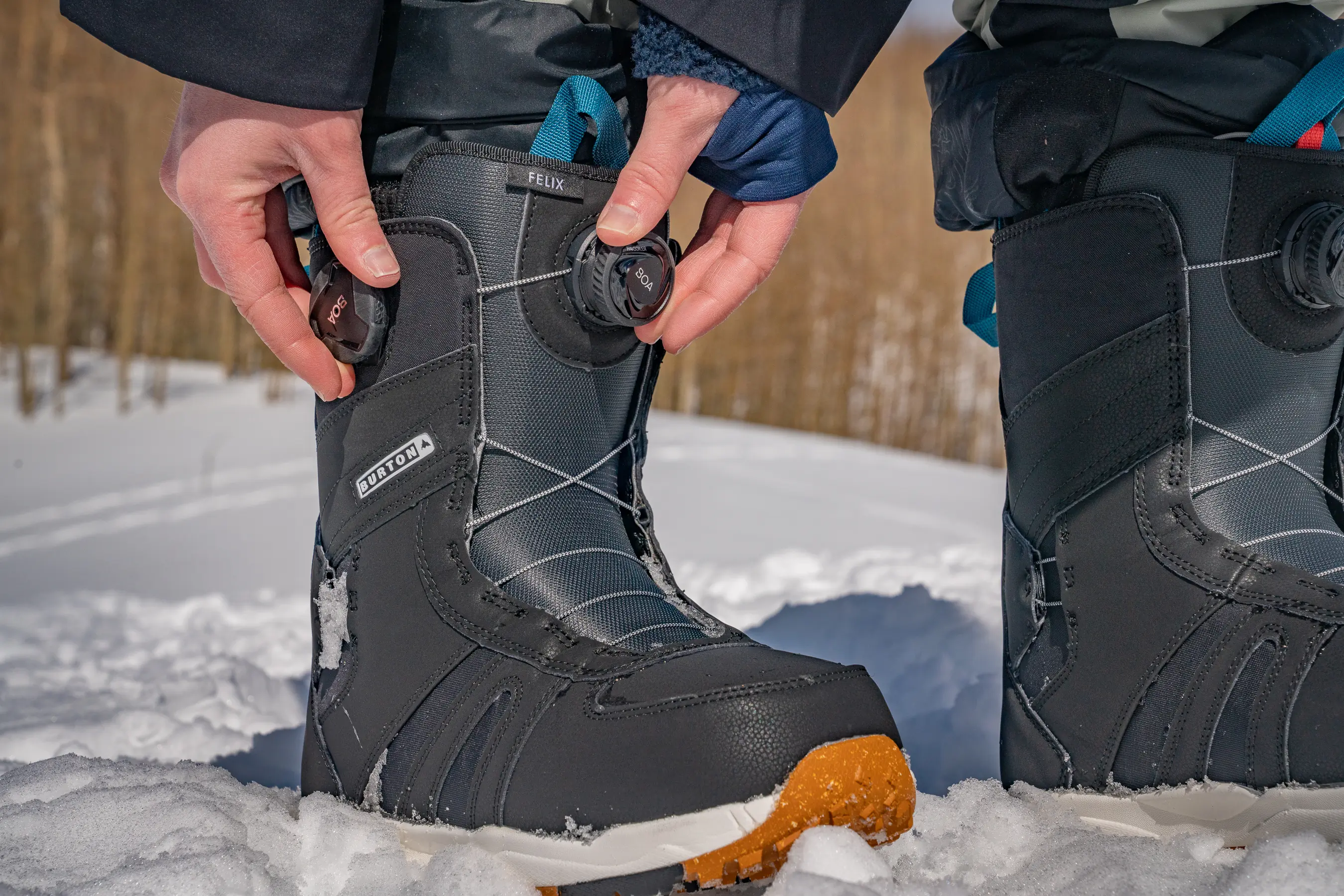



Binding Compatibility
One important thing to consider when shopping for snowboard gear is that there is interplay between boots, bindings, and boards. We already touched on step-in boots, and how Step On boots from Burton and their partner brands, as well as K2 Clicker boots, aren’t compatible with traditional strap bindings.
We also discussed hard boots and soft boots — this one is a bit obvious, but soft boots aren’t compatible with hard boot bindings, and vice versa.
Beyond these specific examples, all soft boots are more or less compatible with all hard boot bindings. However, you still need to think about sizing and compatibility.
Always match your boot size to the binding size. When a boot fits in a binding correctly, you’ll have better performance. If you have a size 11.5 boot, a medium binding that fits boots sizes 8-10 won’t cut it.
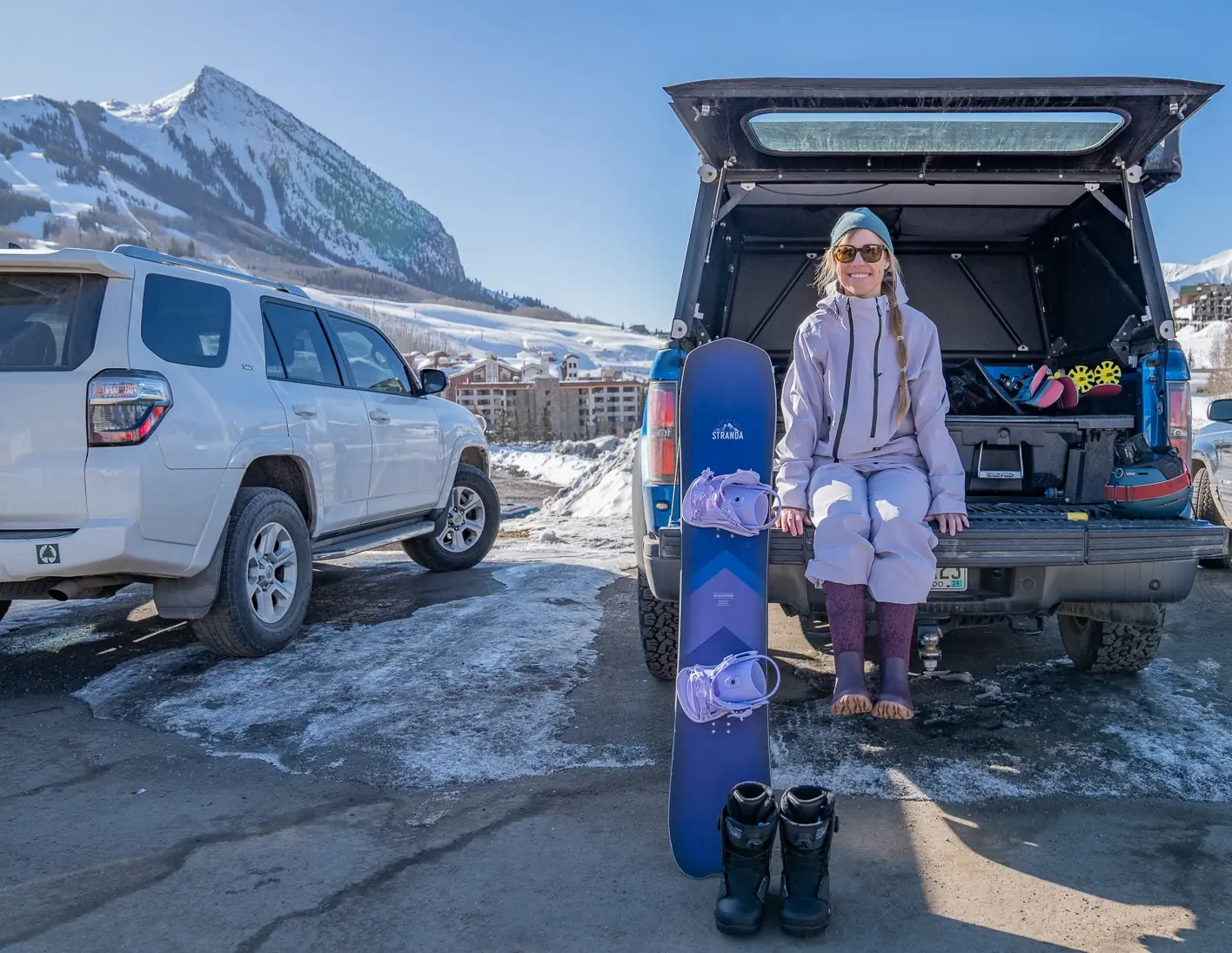



Also, each binding size fits a range of boots (e.g., a medium fits sizes 8-10), but they better accommodate different sizes when adjusted. Don’t be afraid to tweak the heel cup positioning, strap placements, strap lengths, etc. to better accommodate your boots.
Furthermore, it’s worth noting that two boots that are the exact same size may have different profiles. A size 11 in a low-profile, small-footprint boot might squish into a medium binding, while a size 11 with a bulky footprint won’t come close.
You might not think about it while shopping for snowboard boots, but your boot sizing also impacts what size boards you can ride. If you have an 11.5 boot, for instance, you may want to consider a volume-shifted or wide snowboard that accommodates a larger boot and minimizes the chances of the dreaded toe or heel drag.
For all of these reasons, we like to recommend shopping for boots first before purchasing a snowboard and bindings — at least if you’re buying a full setup. And if you find a pair of boots that work well for you but your bindings are too small or your board is too narrow, stick with the boots and plan to upgrade the rest of your kit.


Comfort
A boot’s overall comfort is delivered through the combination of the midsole, liner, and footbed as well as the level of overall support, which prevents fatigue. For instance, the K2 Trance has a foam midsole and anatomically designed EVA footbed for a plush feel that’s also paired with a chatter-absorbing cuff.
Generally, an all-around soft boot might provide immediate comfort but doesn’t necessarily deliver stability for preserving energy on a bell-to-bell or big-objective day. All considered, what feels most comfortable is based on each rider’s preference and foot needs.




Flex
Snowboard boots are constructed on a flex range from soft to medium to stiff. Often brands use a scale of 1 to 10, with 10 being the stiffest. Occasionally, boots have an adjustable flex, like the Vans Viaje, which uses tongue stiffeners and ranges from 6 to 8 on the stiffness scale.
Softer boots typically pack out and break down faster, while stiffer boots last longer and cost more.
We’ll dive more into the specifics below, but ultimately, the ideal flex of a snowboard boot hinges on personal preference and foot needs.
- 1-4: These are softer boots with forgiving flex and comfortable constructions. These boots are great for beginners, but that’s not all: They are also ideal for jibbing, freestyle riding, and tweaking grabs.
- 5-7: These are moderately stiff boots, a solid middle ground for intermediate riders and all-mountain riding. These boots are the most versatile boots, capable of cruising through the park and ripping the entire resort.
- 8-10: These are the stiffest boots out there. These boots are more suited to expert-level riders who demand instantaneous response. They are best for aggressive all-mountain riding and, even more so, unadulterated freeriding.
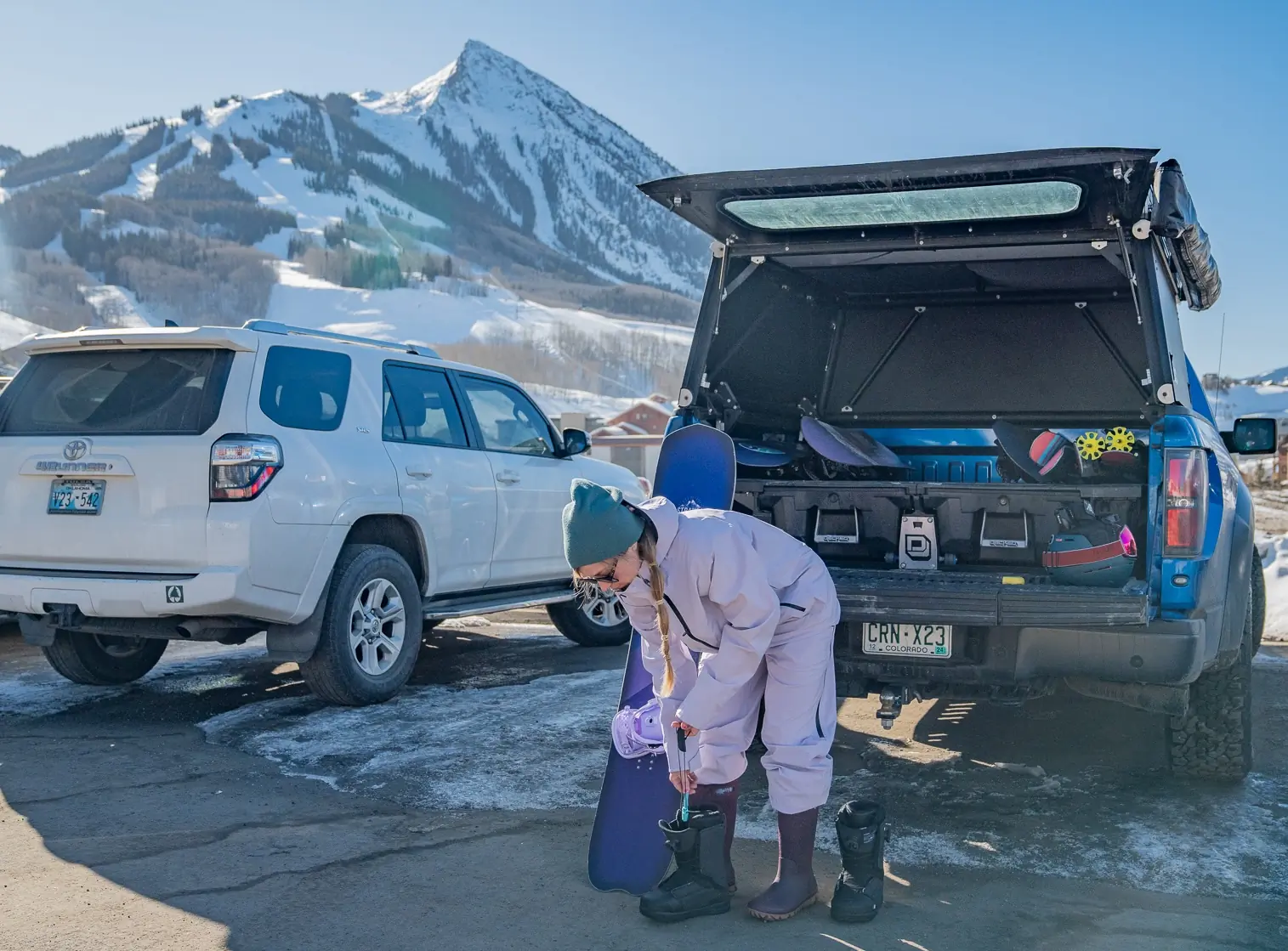



Soft Flex Snowboard Boots
Soft boots like the ThirtyTwo Shifty, Burton Moto BOA, DC Phase, and Ride Harper, are the most comfortable boots, meaning they’re best for beginners or instructors who need to be on their feet all day. Some park riders also prefer a softer boot, as the flex makes locking into jibs and tweaking grabs much easier. However, the flex is too forgiving for high-octane freeriding.
Moderate Flex Snowboard Boots
Medium-stiff boots, like the ThirtyTwo Lashed Double BOA and Women’s K2 Trance, are ideal for progressing intermediates and all-mountain riding. They’re versatile, still reasonably comfortable, and can take on everything from terrain park laps to technical steeps.
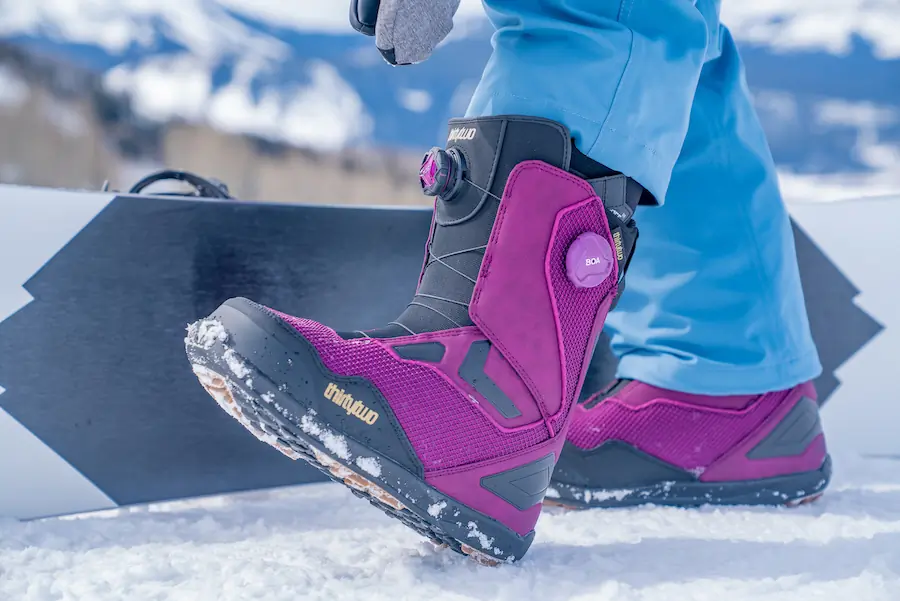



Stiff Flex Snowboard Boots
Stiffer boots, including the Burton Supreme, Men’s Burton Ion BOA, and Vans Viaje Range, are best for freeriding. They enhance the reactivity and precision of the board, a trait more experienced and aggressive riders often prefer.
Backcountry riders also often prefer a somewhat stiffer boot like the K2 Waive. Stiffer boots provide better response on the uphill and the descent, which can be critical in technical, exposed terrain. Additionally, softer boots will get torn to shreds while touring, while stiffer boots can last longer.
While these are general guidelines, they’re not written in stone. A rider’s preferred stiffness level can also come down to personal preference. For instance, some park riders prefer a slightly softer boot for nimble movements while hitting jibs, while pipe riders may opt for a much stiffer boot.
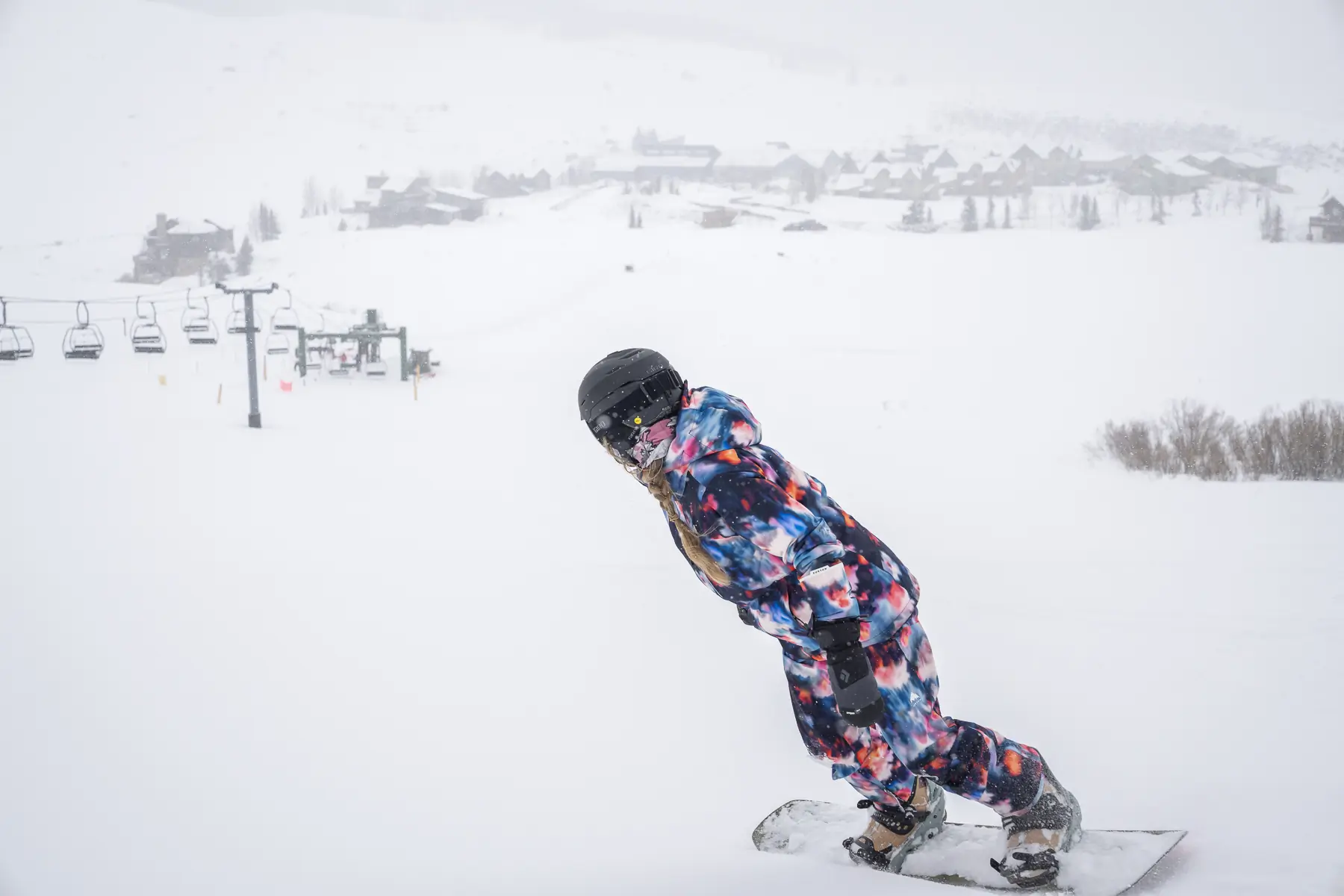



Other advanced or expert riders don’t necessarily prefer the stiffest boots, despite heading into steep and challenging terrain, because they can take away comfort depending on your foot shape. Be sure to try on lots of different types of boots in person before you choose!
Flex of the Snowboard Boots in This Guide
- Men’s Vans Infuse: 5-9/10
- Burton Moto BOA: 3/10
- ThirtyTwo Lashed Double BOA: 6/10
- ThirtyTwo Shifty BOA: 2/10
- K2 Waive: 8/10
- Vans Viaje Range: 6-9/10
- DC Phase: 3/10
- Ride Harper: 3/10
- Women’s Burton Supreme: 6-9/10
- Women’s K2 Trance: 7/10
- Men’s Burton Ion BOA: 8/10
- Men’s Burton Photon Step On: 5-8/10


Outsole
The outsole is the rubber located on the underside of the boot, which grips the snow and ice. Each boot has a unique lug design to help provide great traction while walking on sidewalks or up a slope.
The Vans Infuse sports an outsole that’s perfect for an all-mountain boot — it’s grippy on slick surfaces, capable of scrambling, and isn’t so bulky that it minimizes downhill performance.
If you’re in the market for a backcountry or splitboard mountaineering boot, pay attention to this feature. Look for an outsole with aggressive lugs and dependable, well-vetted material like the Vibram V5 outsole on the K2 Waive.
Or, if you’re looking for an even beefier build, check out the ThirtyTwo Jones MTB — these burly boots sport a heavy-duty Vibram outsole that’s comparable to those on mountaineering boots.
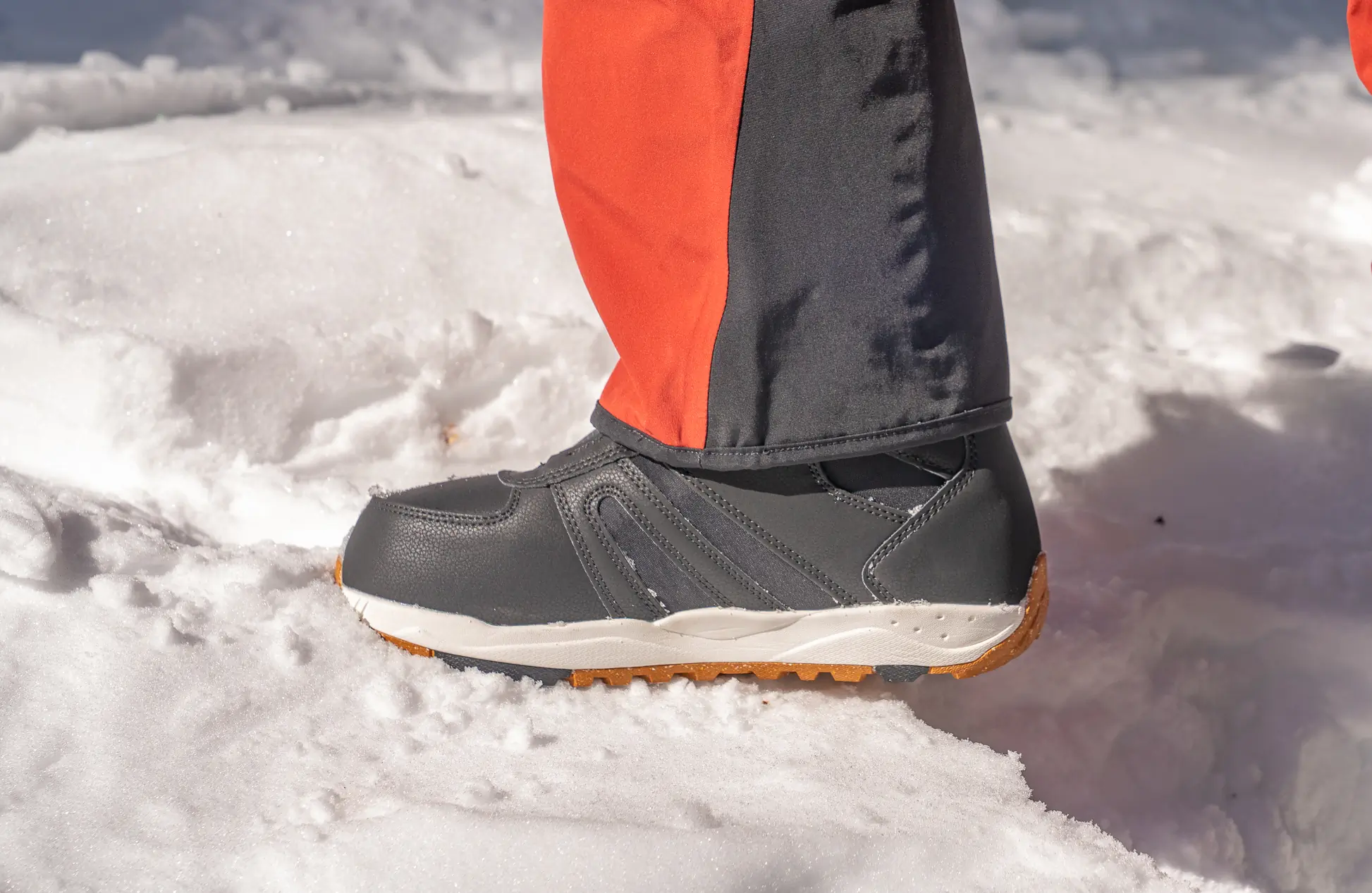



Lacing & BOA
Traditional snowboard boots close up with laces, which certain riders prefer for a more fine-tuned fit all the way up the boot.
Conventional quick-pull closure systems are faster and easier to operate while wearing gloves. Various designs exist across brands, like the speed zone lacing on the Burton Supreme. Other models have a single- or dual-zone BOA system.
Some folks feel quick closures provide a more uniform hug that doesn’t pack out compared to lace setups. One tradeoff is that laces are simpler to replace as they wear out or if they break in the backcountry. Overall, laces are more economical than quick-pull and BOA systems.
A handful of designs mix these options with laces plus a single BOA. And several backcountry and powder-conscious boots feature a zippered shroud to protect the lower portion and closure of the boot from ice and snow, like the Vans Viaje Range. Some boots add extra reinforcement with a Velcro strap.
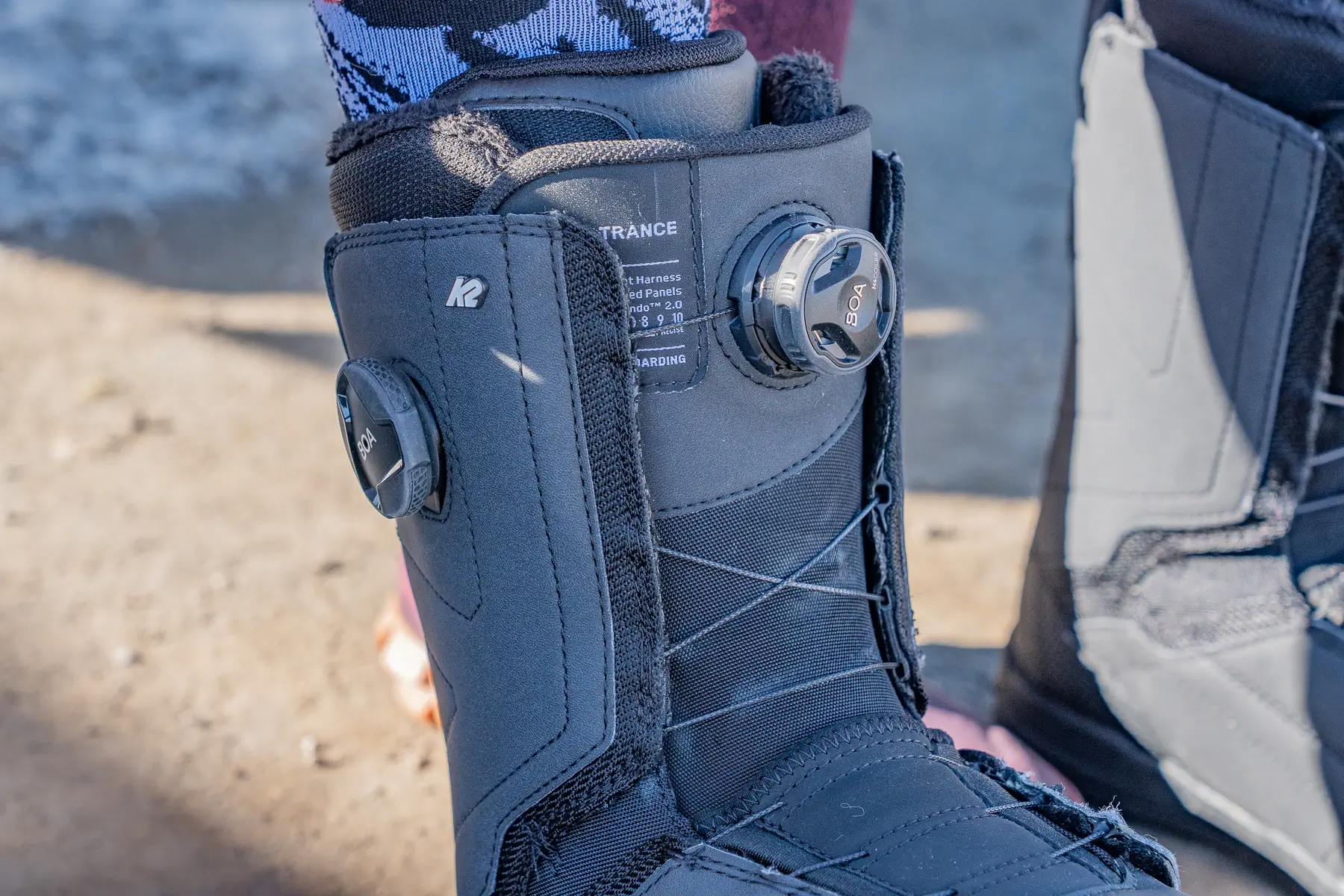



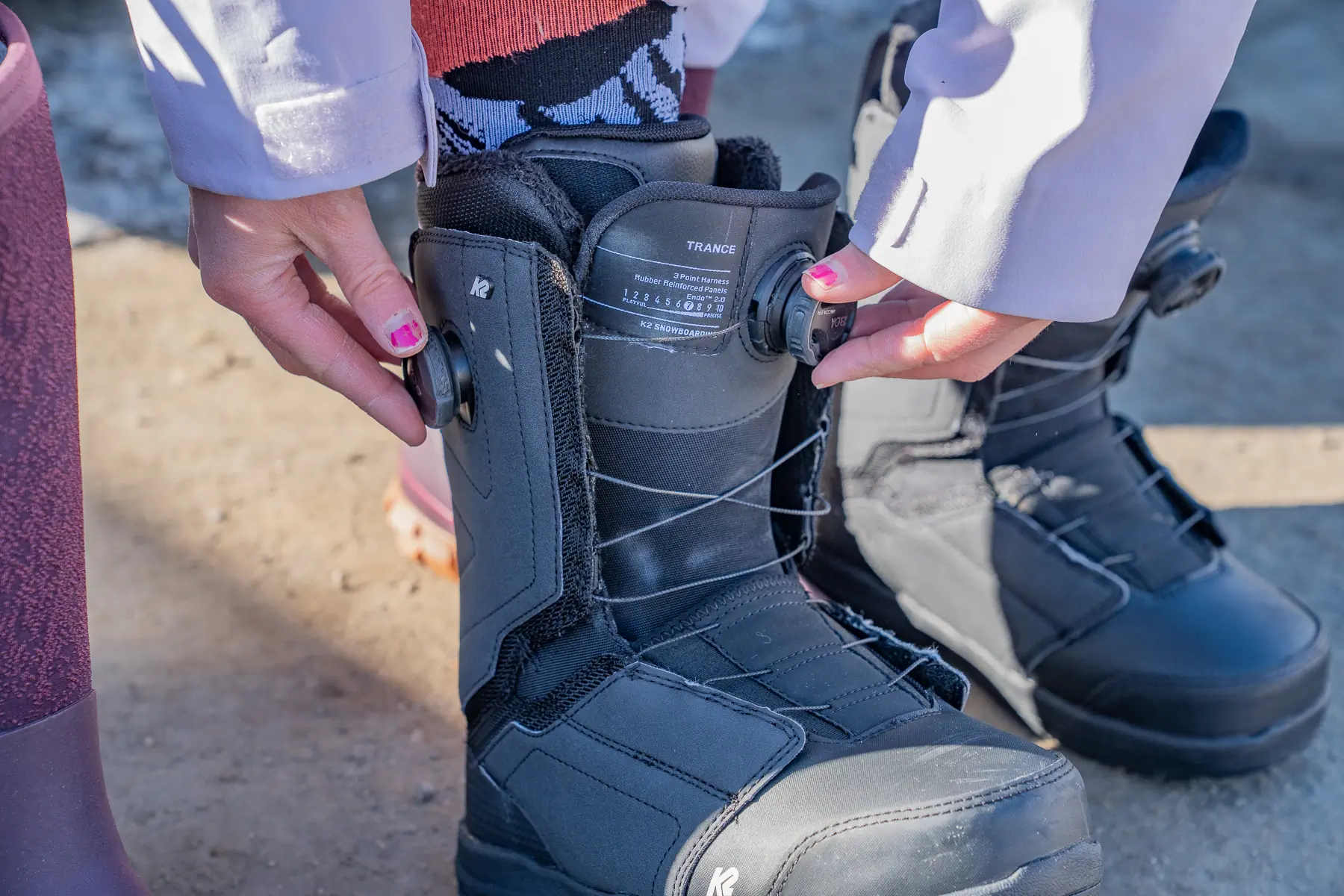



Single, Double, and Triple BOA
You’ll often see affordable boots, like the Burton Moto, using a single BOA system, while more expensive boots, like the Burton Ion, have a double BOA. Some boots, even have triple BOA.
The pros of a single BOA design are simple: you have fewer breakable parts, and tightening the boot is extremely easy. However, because one BOA controls the entire lacing system, you have limited adjustability.
Vice versa, the more BOA dials you have on a pair of boots, the more complex the lacing system, and the more breakable parts you have to deal with. However, this also enables way more adjustability. If you like a tight ankle but loose calf, a boot with dual BOA dials is the way to go.


How to Replace Laces or BOA
Replacing traditional laces is easy, and many boots come with a spare pair of laces in case yours breaks. Just yank out the old laces, thread the new ones, and you’re good to go.
Replacing BOA, on the other hand, is more complicated. If your BOA breaks, it’s possible you just might need a new lace or cable to rethread, which you can learn how to do here. However, it’s also possible that you’ll need to replace the dial itself, which you can also learn how to do here. It’s not a bad idea to grab a spare parts kit in advance, especially if you’re going on a hut trip or traveling overseas.
If DIY fixes aren’t your cup of tea, just bring your busted BOA to your local snowboard shop. Solid snowboard shop techs are usually familiar with typical BOA issues. If your boots are fixable, chances are they can help.
BOA is extremely convenient — until it’s not. That’s why we like using a backcountry boot that doesn’t exclusively rely on BOA, like the K2 Waive. If the BOA breaks while you’re deep in the backcountry, you’ll be able to get back to the trailhead with no problem.
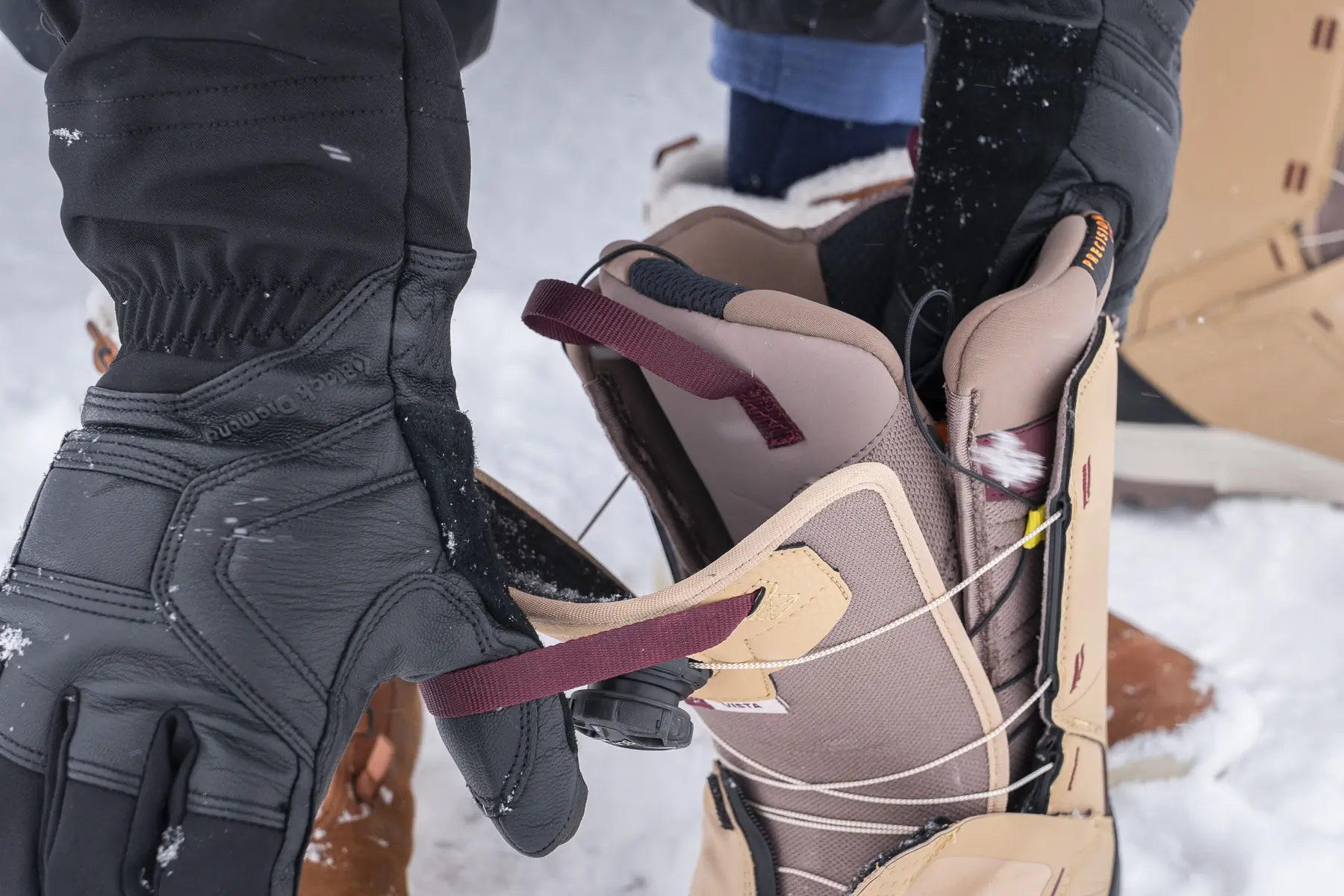



Liners & Footbed
The liner is a boot-shaped layer that fits inside the boot’s exterior shell. Most liners are removable, which is helpful for drying them out after a long day.
Liners are typically constructed with EVA foam, a lightweight and malleable polymer. The foam provides a cushion-like feel and stabilizes the foot. Some liners are heat-moldable, which is great for a more custom fit and shorter break-in period. We discussed this above in our Fit section, but we recommend going to a boot fitter if you are uncomfortable heat-molding your boots at home.
The liner slides into a boot and is cradled by its own lace system, which typically tightens down with a drawstring that also has a release tab. For a better fit, it’s important to tie down this internal harness before tightening down the exterior lace system.
The footbed is removable, so you can upgrade with an aftermarket option that provides tailored support or cushion.
It’s also worth noting that liners are the source of stinky boots, and more and more brands are experimenting with materials that seek to minimize offensive odors. K2, for instance, equipped the Trance with a moisture-managing mesh manufactured from post-consumer polyester and coffee grounds. However, the best way to combat odors is to keep your boots dry — a topic we’ll dive into below.
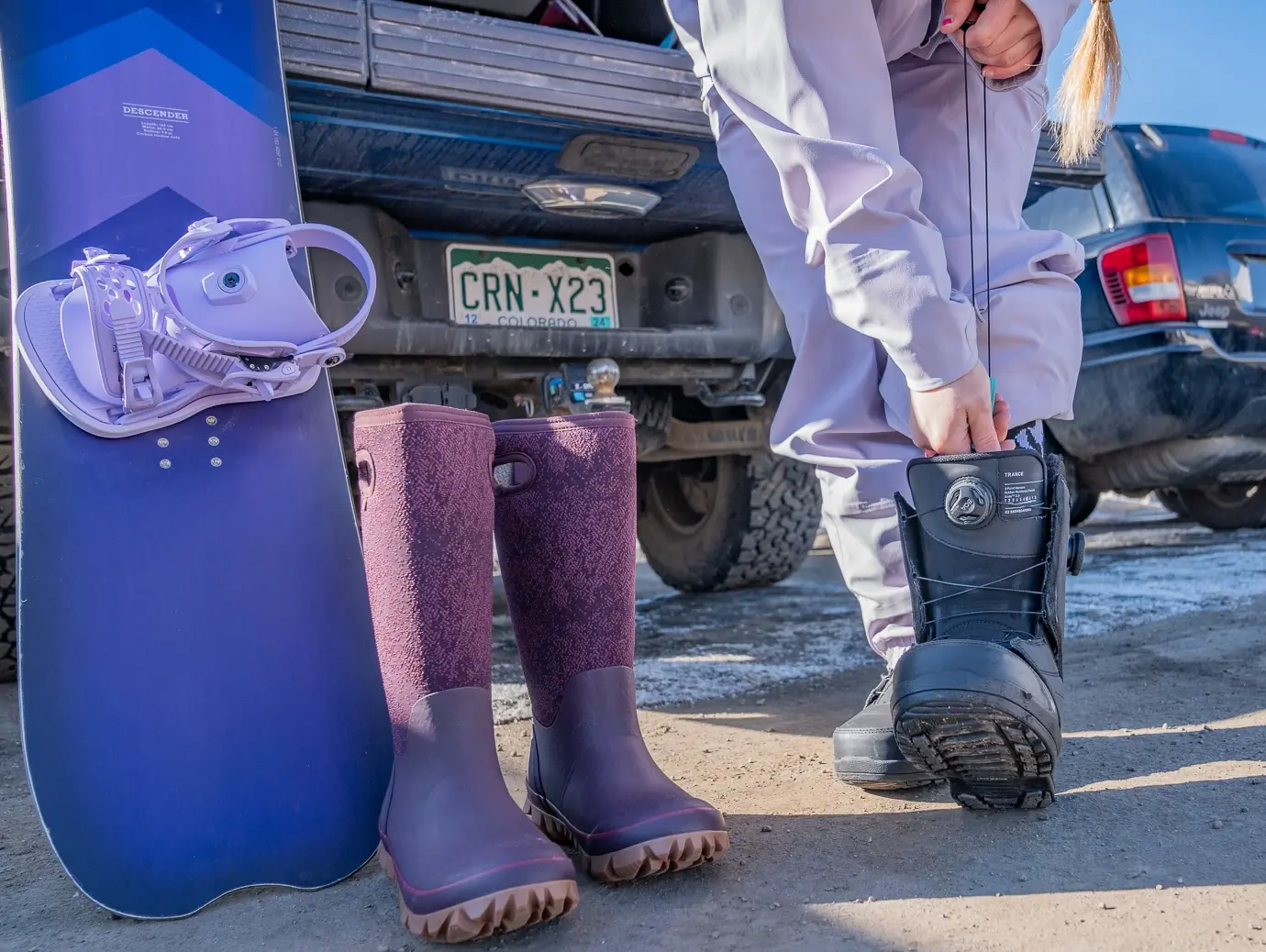



Warmth
Many new-age snowboard boot designs boast unique technologies to help keep your toes safe and toasty. For instance, the Vans Viaje has FlashDry, a technology from The North Face that pushes moisture to the liner surface and keeps the feet dry. The shell has waterproof/breathable valves to release moisture. There’s also a heat-retention wrap integrated around the toebox and above the outsole to hold heat.
However, it’s worth noting that a GearJunkie tester felt the boots lost their warmth after a couple of seasons, and she turned to thicker socks to compensate. Other GearJunkie testers have seen the boots last multiple seasons before the technology began to deteriorate, which is eventually bound to happen with gear.
Some designs also have an integrated heat-reflective foil beneath the feet like the Burton Supreme.
If your feet tend to get cold or you’ve experienced a cold injury, prioritize getting a pair of boots constructed with heat-regulating technology. And don’t forget to choose a warmer snowboard sock if needed. Furthermore, if you’ll be hanging out after the lifts close or have a long drive, bring a dry pair of socks and cozy snow boots to change into.
If your feet still get cold, consider purchasing a pair of rechargeable heated liners, footbeds, or socks.


Snowboard Socks
Choosing the correct snowboard socks can help manage foot temperature and moisture.
They’re available across various densities depending on how cold the climate is where you ride most and your overall body temperature needs. You can find lightweight, medium-weight, and heavy-weight socks.
Snowboard socks also provide targeted cushioning for overall protection and comfort in your boots. These sport-specific socks are woven with a synthetic or merino wool blend.
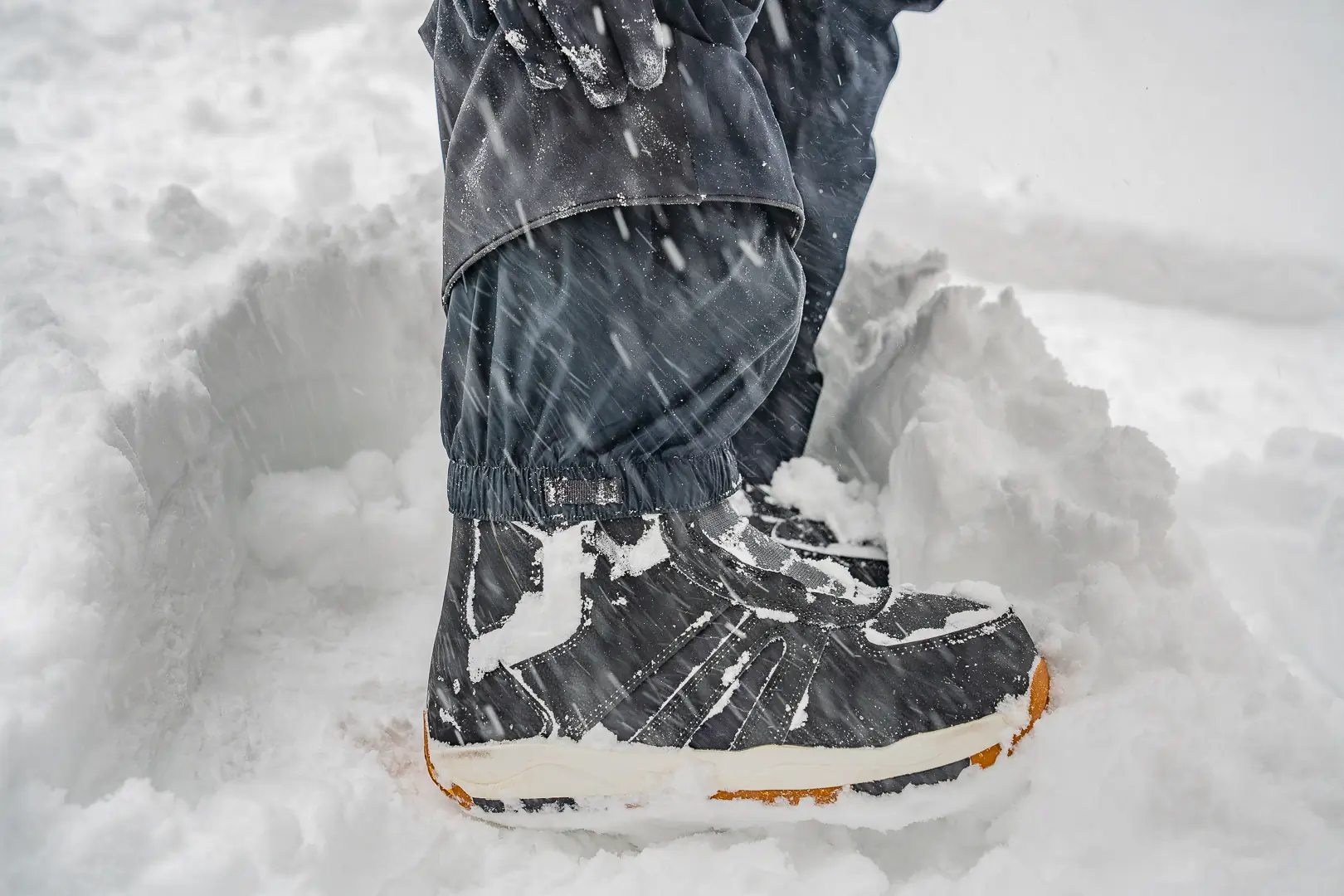



Backcountry Riding & Splitboarding
When snowboarding in the backcountry, you’ll need an effective method of traveling uphill. Most snowboarders hike in their boots and snowshoes or invest in a splitboard and set of skins.
In general, backcountry snowboarding does not necessitate the use of a specific boot. However, certain boot features can significantly improve your comfort and performance. Backcountry terrain requires both uphill and downhill travel. It’s tricky for manufacturers to craft boots that can handle both.
Stiff boots will be efficient while hiking and carving on firm surfaces, while softer boots will feel more playful and nimble in the power. Ultimately, you’ll need to decide which aspects of the backcountry experience you want to prioritize. If you tend to take longer tours that are more than 1-2 hours long, we suggest opting for a stiffer boot that will provide more support.
Backcountry-specific boots do exist, though many riders stick to the boots they wear at the resort. Some features commonly found on backcountry-specific boots include crampon compatibility, a reinforced toebox for kicking in steps, deeper and more strategic lugs for snow and ice traction, and extra rigidity for traversing across steep slopes.
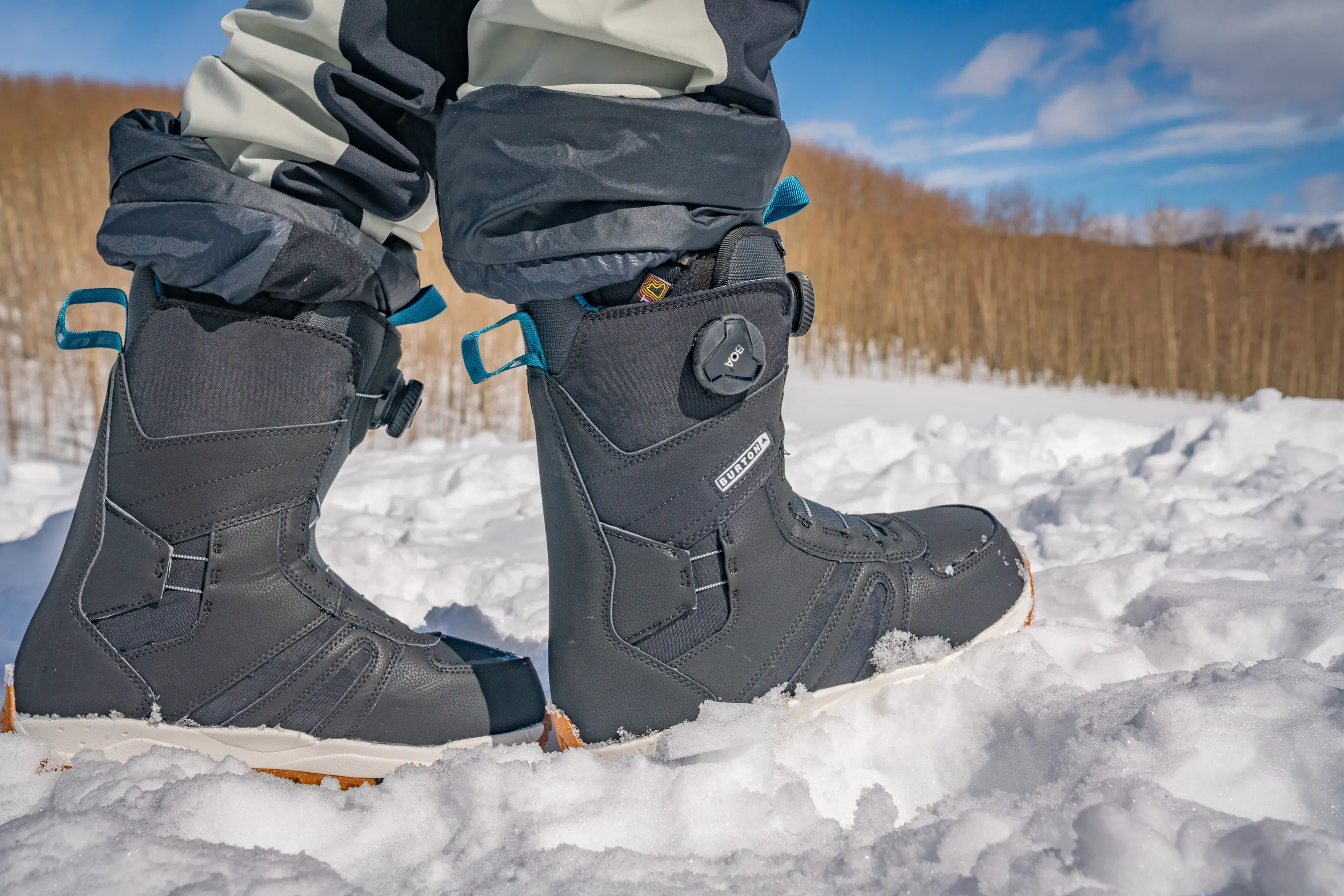



Sustainability
Sustainability is a hot topic across all of snowboarding. Still, it’s still much more common to discuss sustainable board-manufacturing techniques than sustainable boot-manufacturing techniques. However, that is starting to change.
Brands like Ride focus on innovative eco-friendly technologies. The new Torrent, for instance, which we’re currently checking out, is built with a bio-based toe and heel cap, anti-stink bamboo and charcoal mesh, and a sugarcane-derived EVA foam midsole.
While we’re always on the hunt for sustainable manufacturing techniques, we still have a long way to go. That said, one of the best ways you can minimize your impact is by purchasing well-made boots that will last multiple seasons instead of snagging cheap ones that’ll blow out in a few weeks.
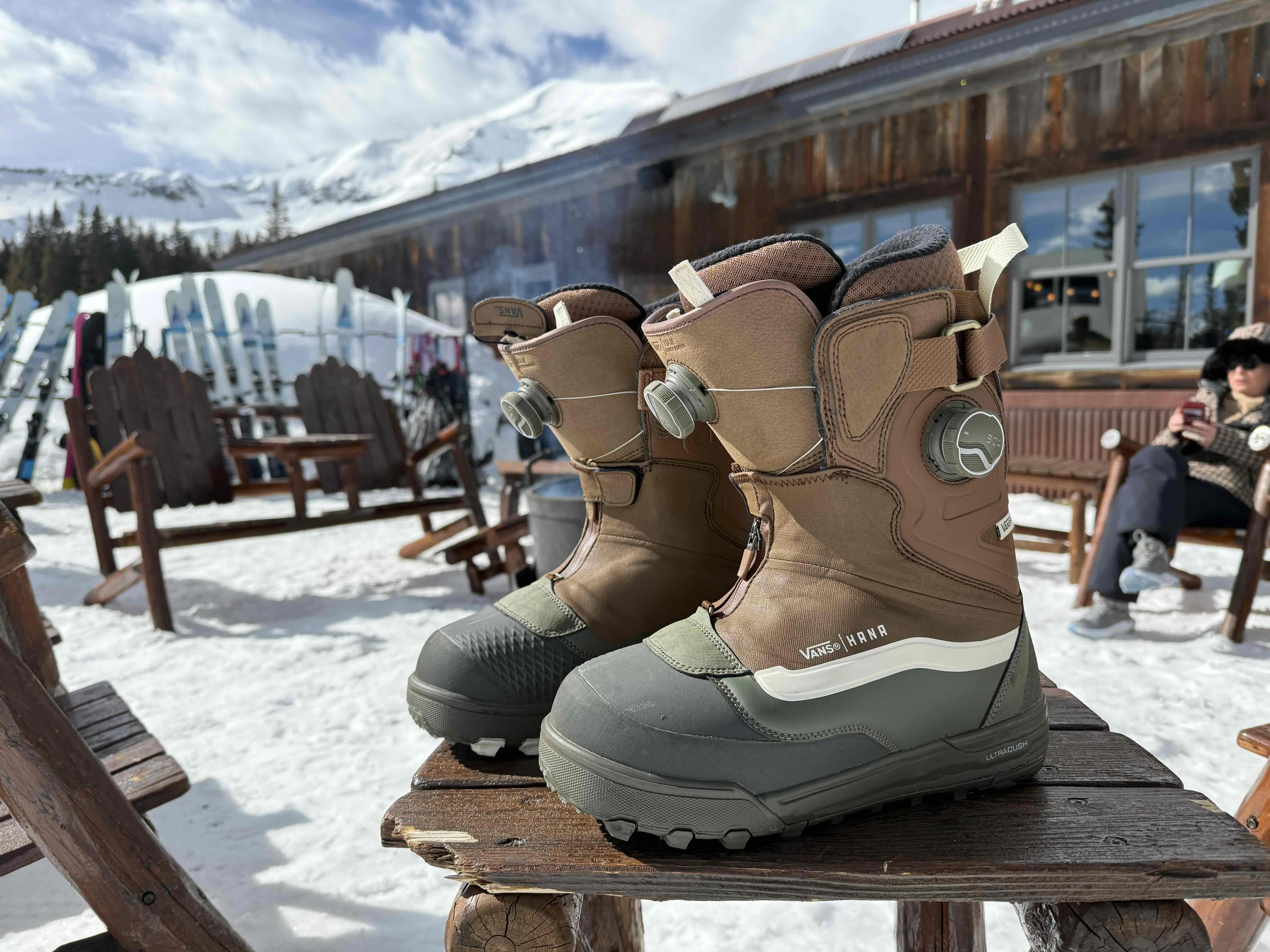



How to Take Care of Your Snowboard Boots
If you’re a hard-charger who is riding 100+ days a season, it’s not out of the ordinary to need a new pair of boots every year. However, if you’re a more casual rider, boots should last several seasons. Regardless, with a little care, you’ll extend the lifespan of your boots.
The most basic way to care for your snowboard boots is to keep them dry, and the best way to dry your boots is to bring them inside every day after riding. Pull the liner out of the boots and pop the liner on a boot dryer. This process moves air through the liner material, which helps eliminate odors and prevent mold while getting the liner dry for the next day.
While many boot dryers have heat settings, we like to use air dry settings, as room temperature air won’t compromise any heat-molding or boot-fitting work you’ve done. Avoid putting boot liners too close to blasting heaters or hot fireplaces, as this can impact boot-fitting and heat-molding work.
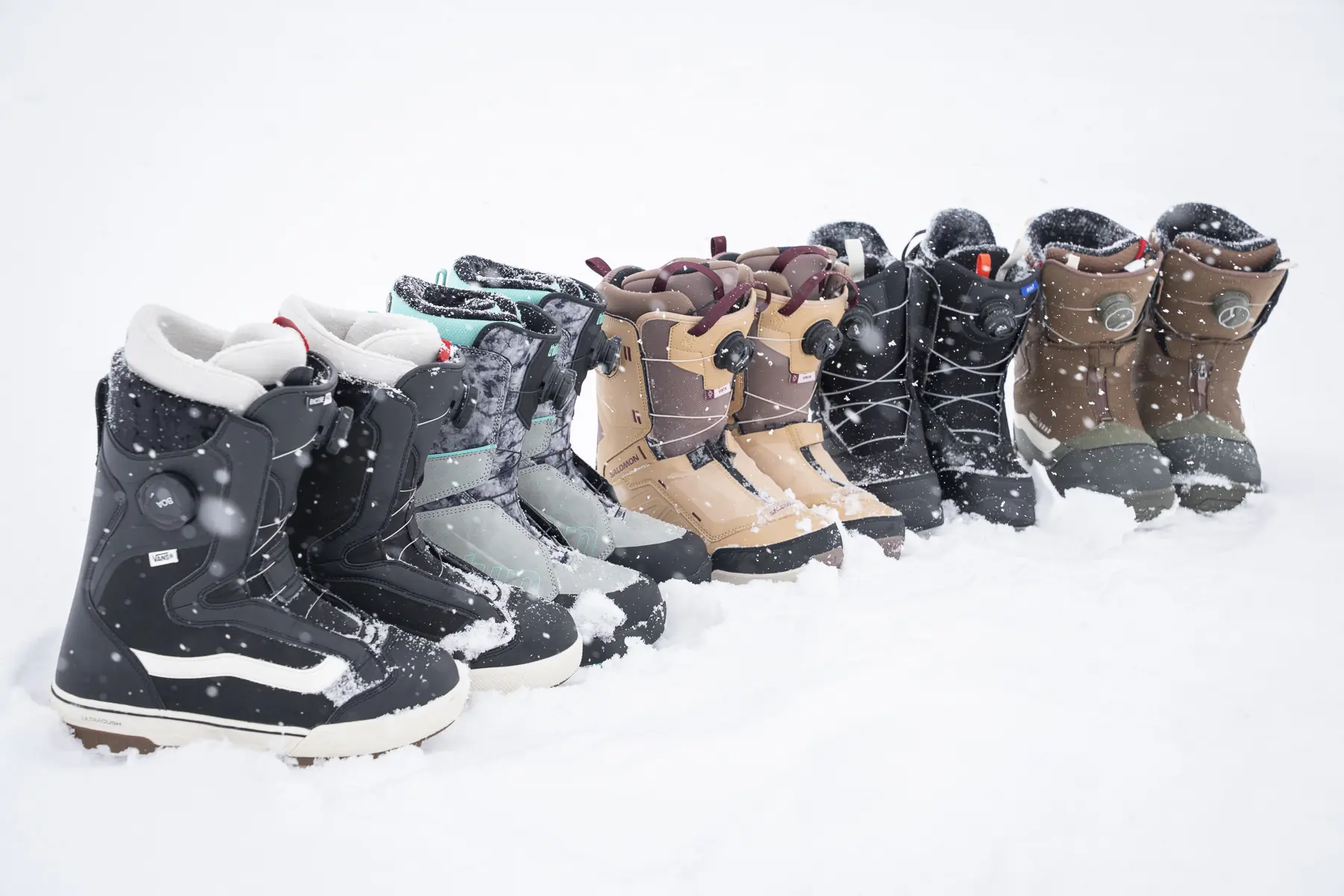



Price & Value
Our favorite snowboard boots range from $200 to $550. On that lower end, you’ll find more forgiving construction, which equates to a softer boot that’ll also break down faster. The higher the price, the more built-out the boot is with high-end materials that are more durable, technical for various terrain like booting up an inbounds hike or hiking along a ridge. Generally, costlier boots are more aggressive for experienced riders and off-piste terrain.
Budget
If you’re shopping on a budget, our top picks in this guide are the Men’s Burton Moto BOA ($280) and the Women’s ThirtyTwo Shifty BOA ($260), which are both on the more forgiving side. Anything under $300 we consider a reasonably priced boot, although these boots are usually softer and better suited for freestyle.
These are also great boots for beginner or once-in-a-while riders, so that your feet can feel good in the boots. Other economic-priced boots include the Men’s DC Phase ($200) and Women’s Ride Harper ($250).
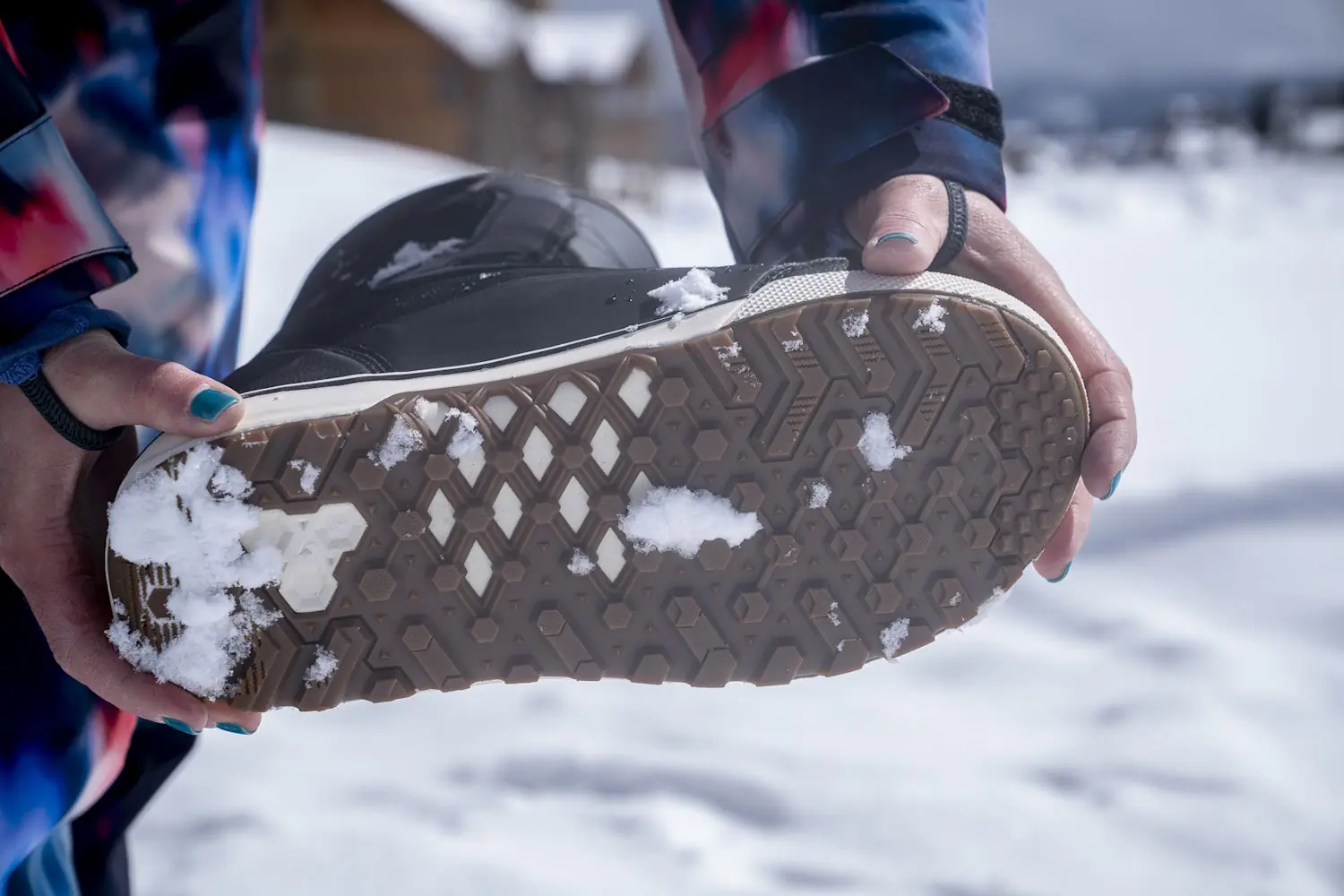



Mid-Tier
At the mid-tier, $300-470 is the sweet spot for most riders, as you’ll find everything from premium freestyle boots to burly freeride boots in this range.
At the lower end of this price range, you’ll find more simple, straightforward boots like traditionally laced models. And on the high end, you’ll see more elite boots like the Women’s Vans Viaje Range ($465) and K2 Trance ($380). You start to see boots introduce modifiable size ranges, a double BOA lace system, more complex tread and rubber in the outsole, and textiles or layers that rebound and regulate body heat to help your feet stay warm. You start to advance from a soft to a moderately stiff boot.
This is also the price range of most all-mountain boots, including the Men’s Vans Infuse ($420) and the ThirtyTwo Lashed Double BOA ($400).
Premium
Above $470, you’ll find more specialized and stiffer boots. Beginners should generally stay away from this price range with the exception of step-in boots like the Burton Photon Step On ($500), which has a medium degree of stiffness.
But overall, premium boots include stiffer splitboarding boots like the Men’s K2 Waive ($590), freeride boots like the Women’s Burton Supreme ($550), and aggressive all-mountain designs like the Burton Ion BOA ($650).


Frequently Asked Questions
Snowboard boots should feel snug all around your foot, with your toes barely reaching the end of the boot. Most boots have liners that can either be custom-fitted to your foot or naturally adjust over time.
Your snowboard boot size will likely be equivalent to your shoe size, give or take a half-size on either end. Like standard shoes, every company’s fit will vary.
Each snowboard boot feels different based on the fit, softness/stiffness profile, and the materials used to create the interior liner and the exterior shell. Some ingredients degrade and soften faster with use, while others are more rigid and durable. Typically, higher-end materials reflect a bigger price tag.
Many snowboard boots have heat-moldable liners that are removable. Heat-moldable liners will eventually conform to your feet if you simply ride in them. To speed up the process for immediate comfort, take your boots to a snowboard shop to get the liners molded.
A retail specialist sticks the liners onto a special heater that warms the components and then puts the footbeds back inside. With the materials all toasty, you stand in the liner for up to 15 minutes to cast the shape of your foot.
You can also pull on your boots and snowboard socks at home to help with the break-in process.


Snowboard boots are harder to walk in than shoes, as they only allow for forward ankle movement. On the flip side, the increased softness and flexibility make them easier to walk in than standard ski boots.
If a snowboard boot is packed out and too big or the support is too soft, riders can try to compensate by clamping down the closure system and binding. As a result, the pressure applied to the top of the foot can cut off circulation and lead to numbness.
On the other hand, riders who size down for a better heel hold can face the same issue, especially if the boot is stiffer and doesn’t pack out as much as they anticipated. Furthermore, some stiff designs and particular shapes are not ideal for certain foot shapes and can decrease blood flow.
Make sure you properly measure the length and width of your foot and try on various boot sizes at a retail store. Adding a new insole, J-bars (also known as l-pads), C-pads, ankle wrap pads, a foam narrowing pad, or boot-fitting foam can help snug up the boots in the right spots without downsizing.
The most noteworthy difference between the anatomy of women and men is that the calf muscle is lower on a woman’s leg. For better support and comfort, the cuff of a woman’s snowboard boot is shorter in length.
Women generally have narrower feet than men. Snowboard boots built for women often have a narrower heel and an overall more streamlined shape. For greater flex and easier transfer of energy, women’s snowboard boots are also generally less stiff.
Some women with longer or wider feet find men’s boot options work great. For some men with narrower feet, women’s boots are a better fit.
If you choose a women’s boot, it’s good to get a women’s binding for the best compatibility. Likewise, if you opt for a men’s boot, consider getting a men’s binding.


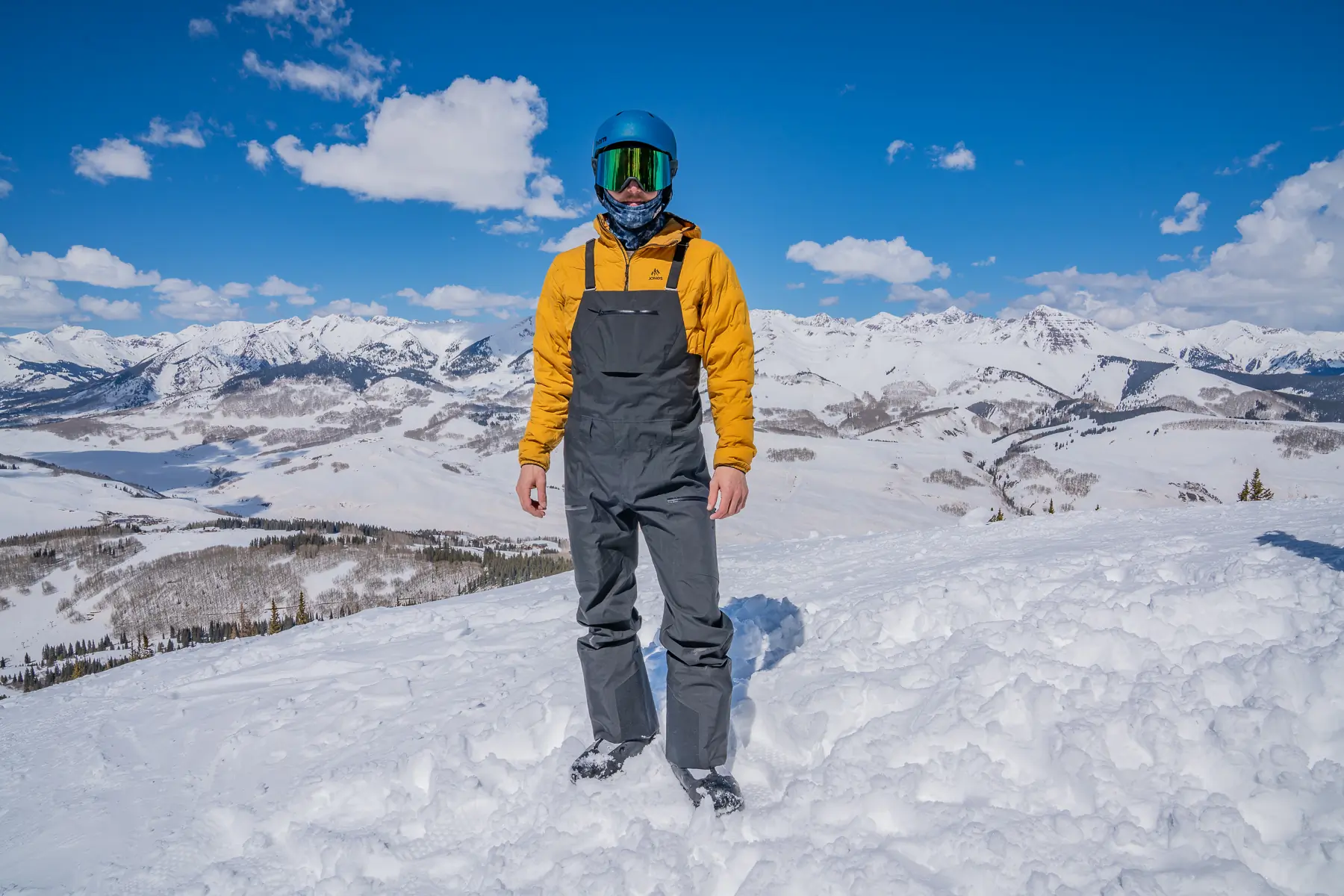

The Best Men’s Ski Bibs of 2025-2026
Whether you ski, snowboard, snowmobile, or splitboard, we’ve found the best men’s ski bibs.
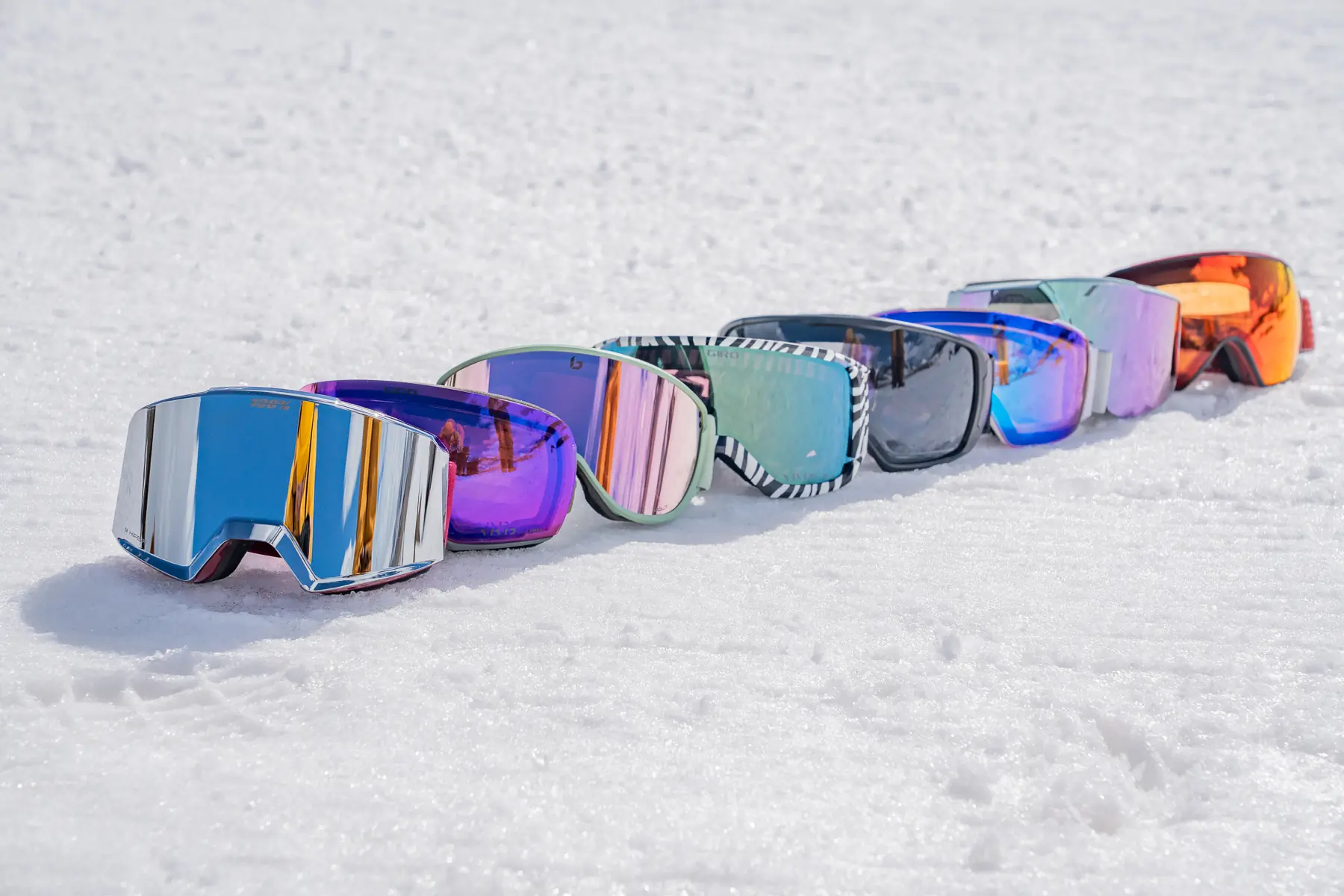

The Best Ski Goggles of 2025-2026
Searching for the best ski goggles for skiing, snowboarding, or snowmobiling? We’ve got you covered with our vetted collection.



